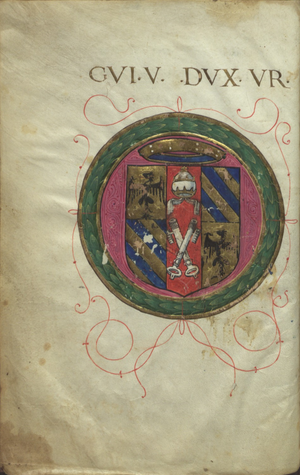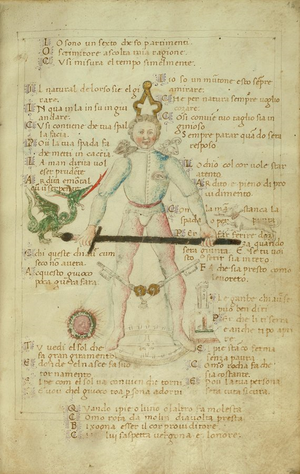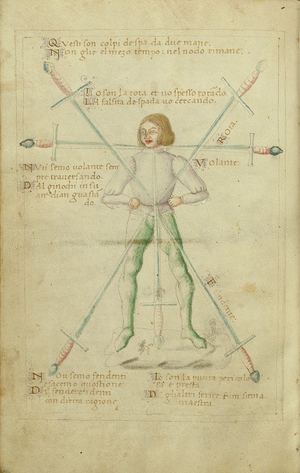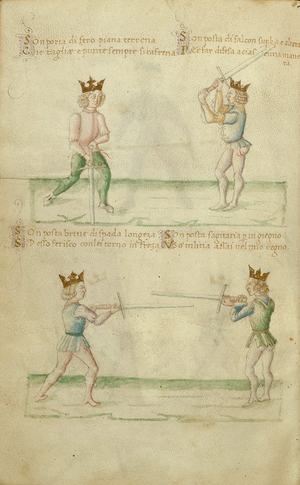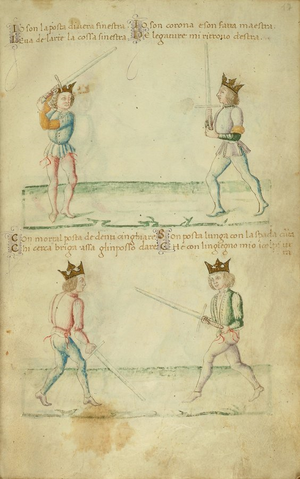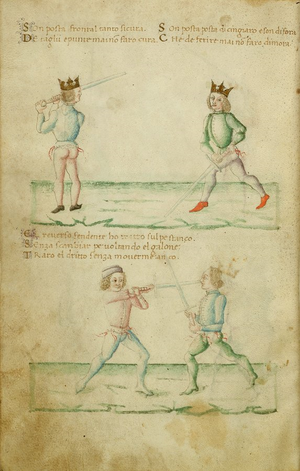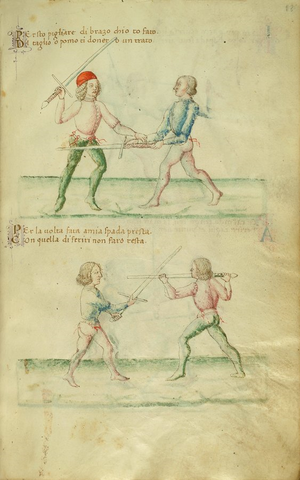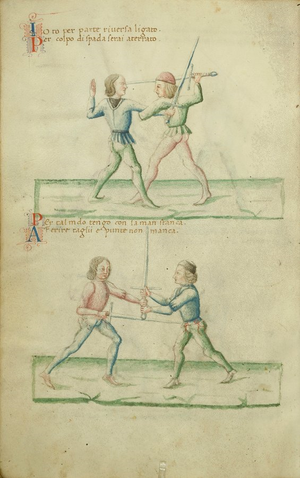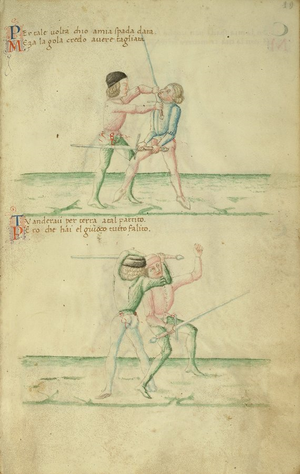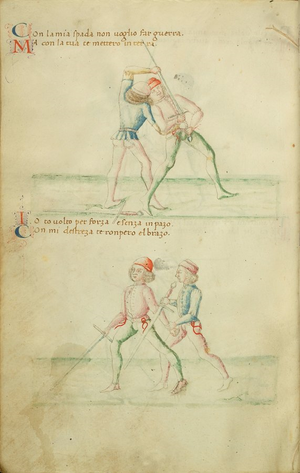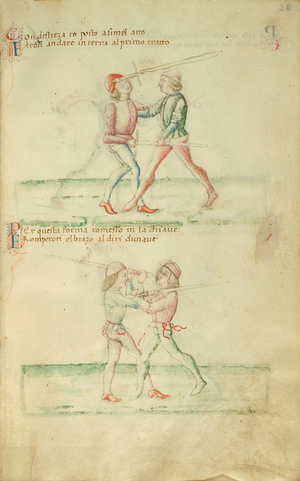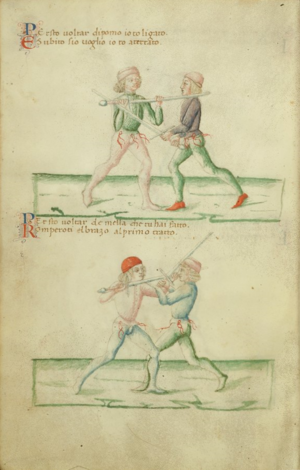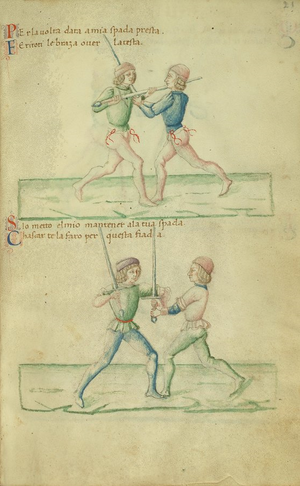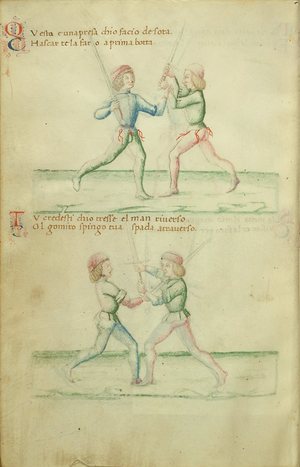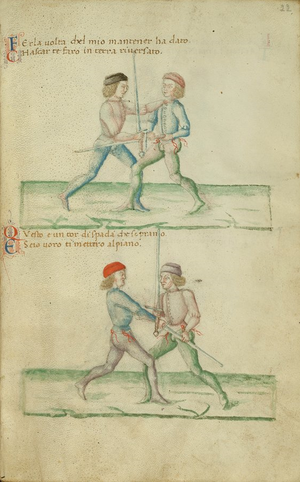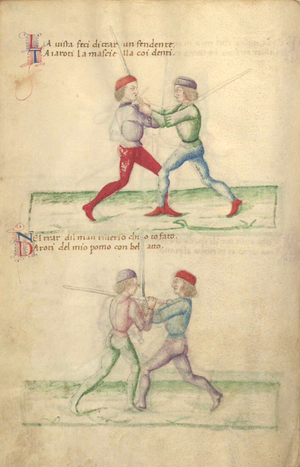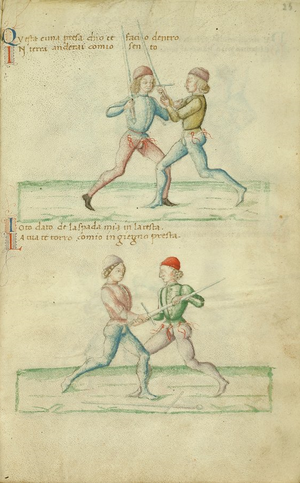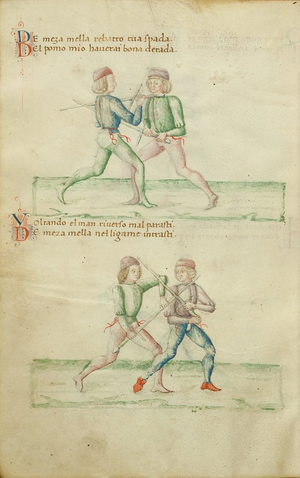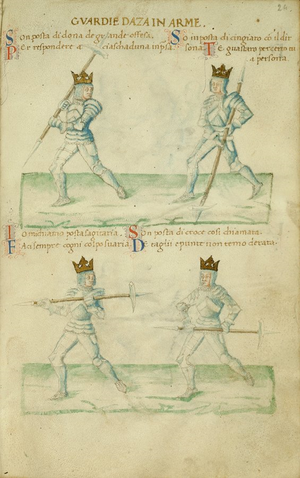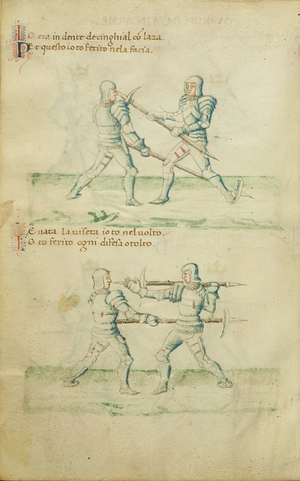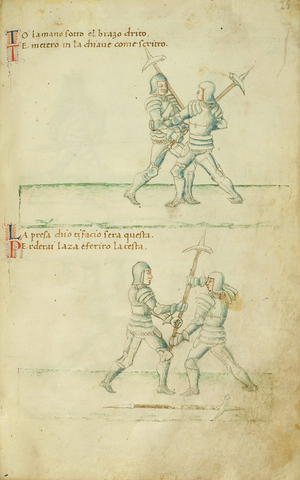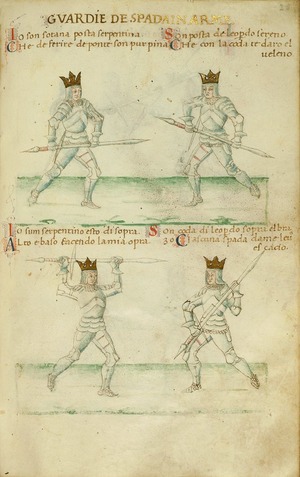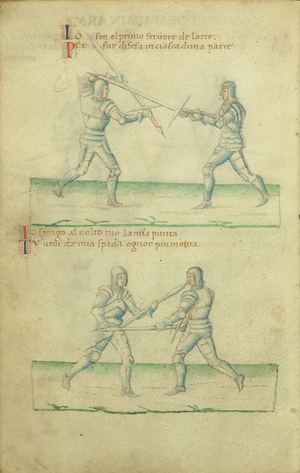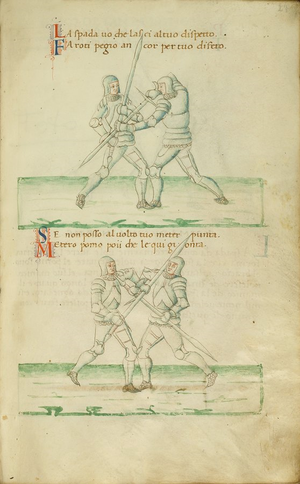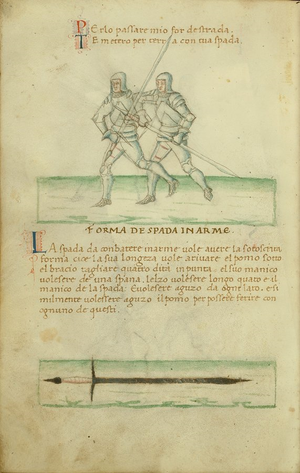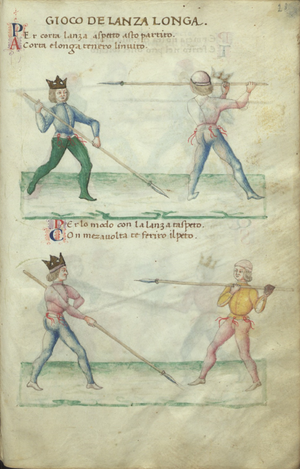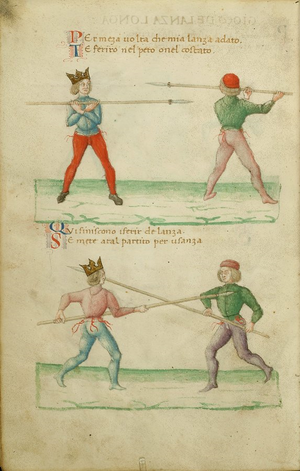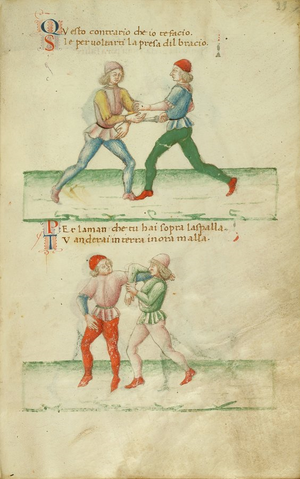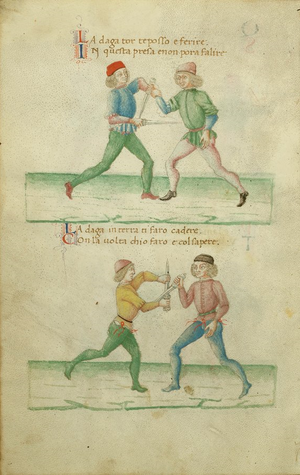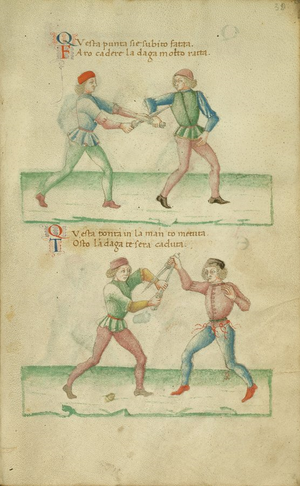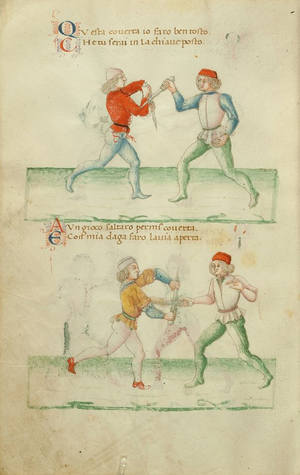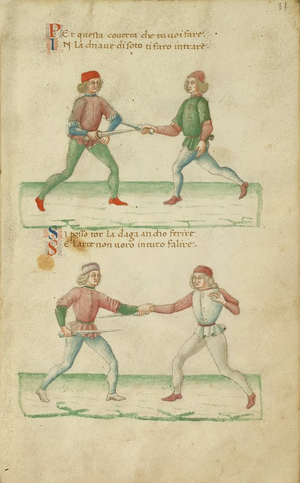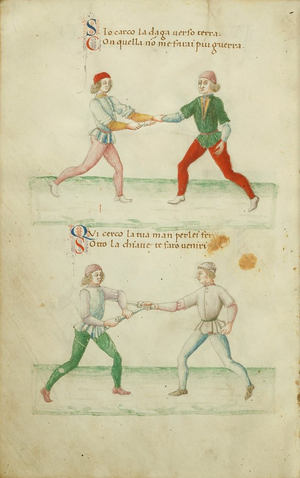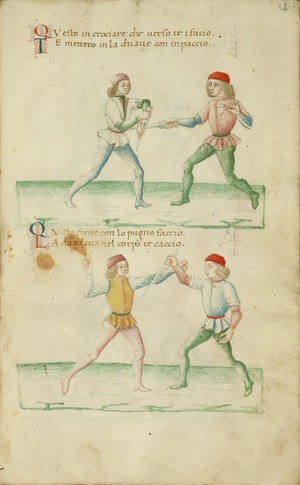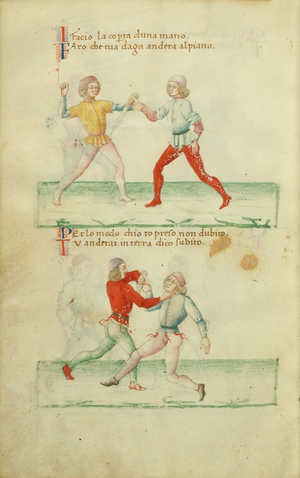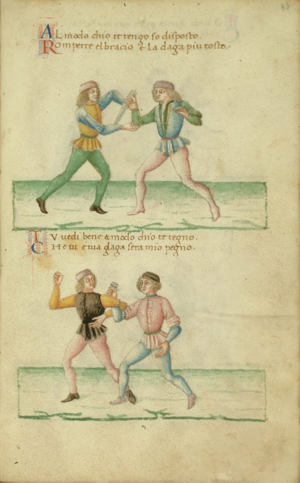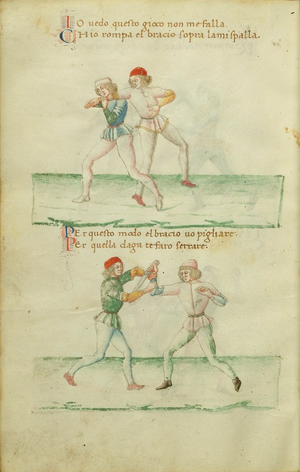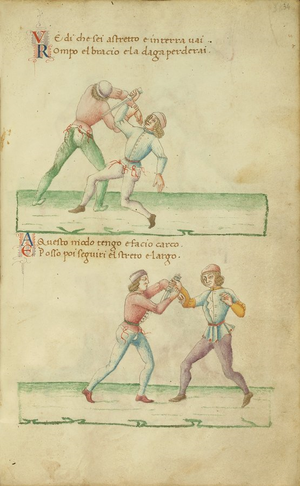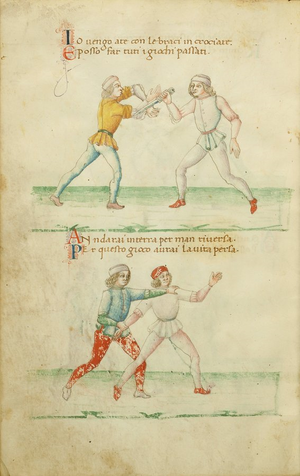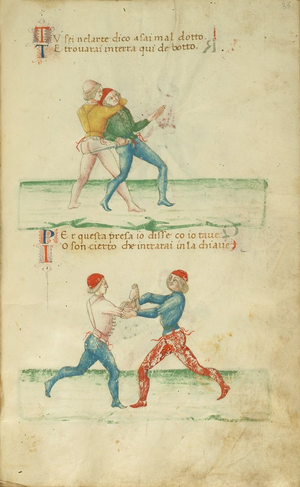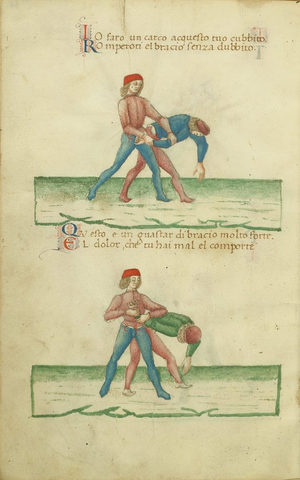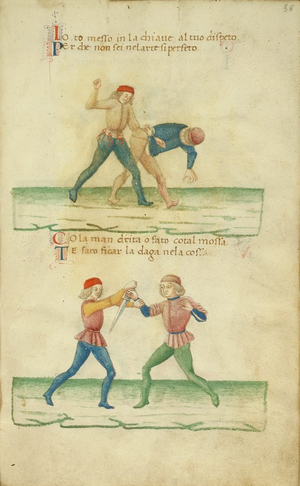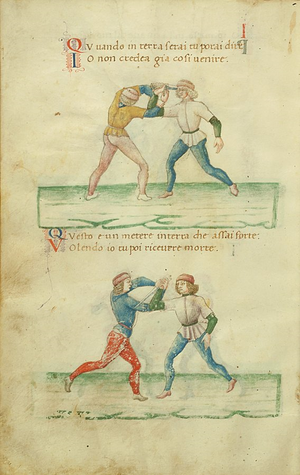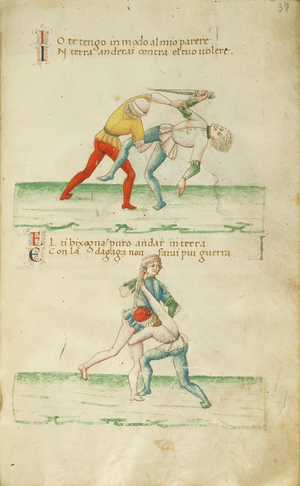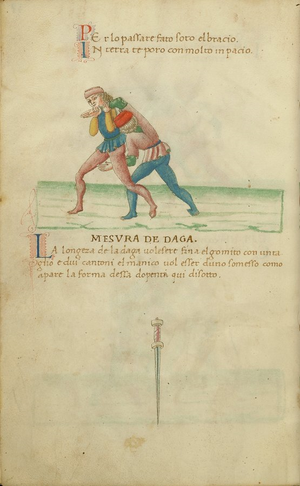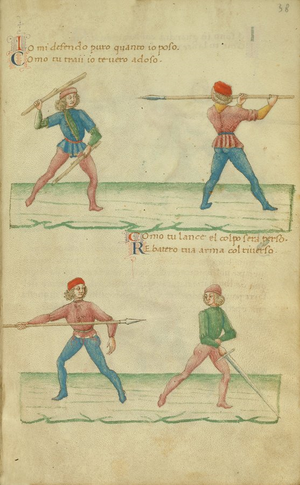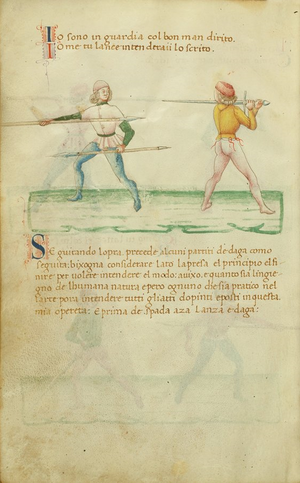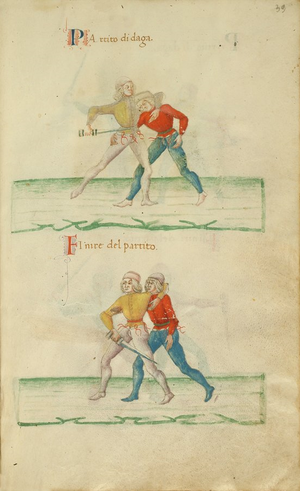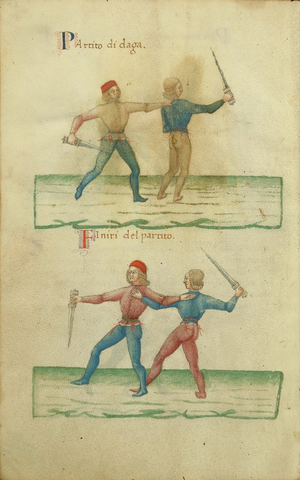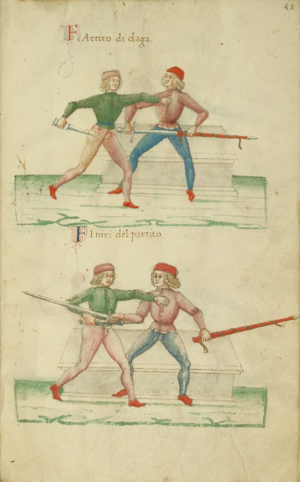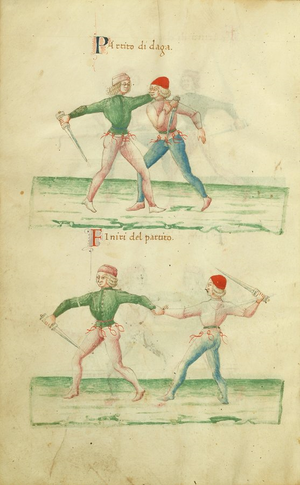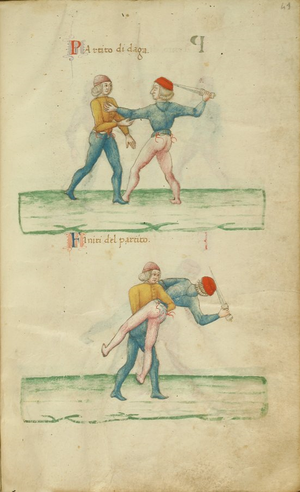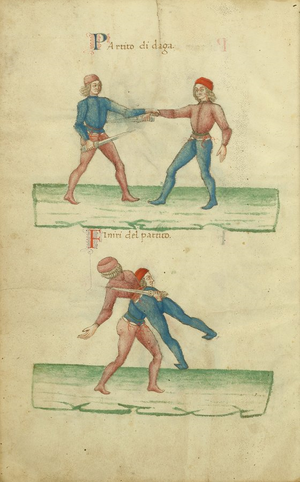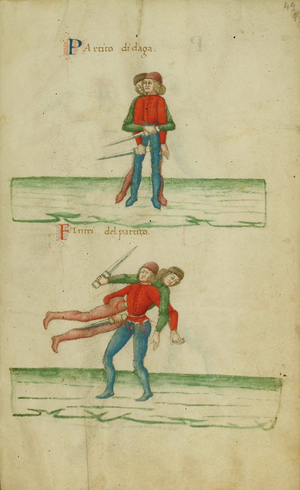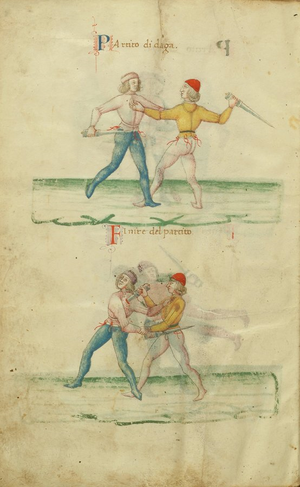|
|
You are not currently logged in. Are you accessing the unsecure (http) portal? Click here to switch to the secure portal. |
Difference between revisions of "Philippo di Vadi"
| (29 intermediate revisions by the same user not shown) | |||
| Line 36: | Line 36: | ||
| principal manuscript(s)= | | principal manuscript(s)= | ||
| first printed edition= Porzio and Mele, 2002 | | first printed edition= Porzio and Mele, 2002 | ||
| − | | wiktenauer compilation by= | + | | wiktenauer compilation by= |
| spouse = | | spouse = | ||
| Line 47: | Line 47: | ||
| signature = | | signature = | ||
| website = | | website = | ||
| + | | translations = {{plainlist | ||
| + | | {{english translation|File:The Knightly Art of Combat of Filippo Vadi.pdf|local=1}} | ||
| + | | {{english translation|http://www.thearma.org/Manuals/Vadi.htm}} | ||
| + | }} | ||
| below = | | below = | ||
}} | }} | ||
| − | '''Philippo di Vadi Pisano''' was a [[century::15th century]] [[nationality::Italian]] [[fencing master]]. His name signifies that he was born in Pisa, a city in northern Italy, but little else can be said with certainty about the life of this master. It may be that he was the same Philippo Vadi who was governor of Reggio under the marquisette of Leonello d’Este and later, from 1452 to 1470, counselor to Borso d’Este, Duke of Ferrara.<ref>For an alternative theory as to the identity of Philippo di Vadi, see Greg Mele. "[http://hemaalliance.com/discussion/viewtopic.php?p=29181#p29181 Interesting information on the Vadi family (Philippo Vadi)]". [[HEMA Alliance|HEMA Alliance Forum]]. 06 June 2012. Retrieved 09 October 2012.</ref> Some time after this, Vadi composed a treatise on fencing entitled ''[[De Arte Gladiatoria Dimicandi (MS Vitt.Em.1324)|De Arte Gladiatoria Dimicandi]]'' ("On the Art of Swordsmanship") | + | '''Philippo di Vadi Pisano''' was a [[century::15th century]] [[nationality::Italian]] [[fencing master]]. His name signifies that he was born in Pisa, a city in northern Italy, but little else can be said with certainty about the life of this master. It may be that he was the same Philippo Vadi who was governor of Reggio under the marquisette of Leonello d’Este and later, from 1452 to 1470, counselor to Borso d’Este, Duke of Ferrara.<ref>For an alternative theory as to the identity of Philippo di Vadi, see Greg Mele. "[http://hemaalliance.com/discussion/viewtopic.php?p=29181#p29181 Interesting information on the Vadi family (Philippo Vadi)]". [[HEMA Alliance|HEMA Alliance Forum]]. 06 June 2012. Retrieved 09 October 2012.</ref> Some time after this, Vadi composed a treatise on fencing entitled ''[[De Arte Gladiatoria Dimicandi (MS Vitt.Em.1324)|De Arte Gladiatoria Dimicandi]]'' ("On the Art of Swordsmanship"), which currently exists in at least two manuscript copies. It was dedicated to Guidobaldo da Montefeltro, Duke of Urbino,<ref name=Vadi>'''Vadi, Philippo di'''. ''De Arte Gladiatoria Dimicandi'' [manuscript]. [[De Arte Gladiatoria Dimicandi (MS Vitt.Em.1324)|MS Vitt. Em. 1324]]. Rome, Italy: [[Biblioteca Nazionale Centrale di Roma]], 1480s.</ref> and gifted to him between 1482 and 1487,<ref name=Rubboli>[[Marco Rubboli|Rubboli, Marco]] and [[Luca Cesari|Cesari, Luca]]. ''[[:File:The_Knightly_Art_of_Combat_of_Filippo_Vadi.pdf|The Knightly Art of Combat of Filippo Vadi]]''. Document circulated online.</ref> but while this may indicate that he served the duke after leaving Ferrara, there is no record of a Master Vadi being attached to the ducal court. |
Vadi was probably an initiate of the tradition of [[Fiore de’i Liberi]], as both his teachings and the format of his treatise closely resemble those of the earlier master. As both Leonello and Borso were sons of Niccolò III d’Este, owner of two copies of Fiore's treatise ''Fior di Battaglia'', Vadi would have had ample opportunity to study his writings. | Vadi was probably an initiate of the tradition of [[Fiore de’i Liberi]], as both his teachings and the format of his treatise closely resemble those of the earlier master. As both Leonello and Borso were sons of Niccolò III d’Este, owner of two copies of Fiore's treatise ''Fior di Battaglia'', Vadi would have had ample opportunity to study his writings. | ||
| + | {{TOC limit|3}} | ||
== Treatise == | == Treatise == | ||
{{master begin | {{master begin | ||
| title = Preface | | title = Preface | ||
| − | | width = | + | | width = 90em |
}} | }} | ||
| − | {| class=" | + | {| class="master" |
|- | |- | ||
| − | ! | + | ! <p>Illustrations</p> |
! <p>{{rating|B}}<br/>by [[Guy Windsor]]</p> | ! <p>{{rating|B}}<br/>by [[Guy Windsor]]</p> | ||
! <p>[[De Arte Gladiatoria Dimicandi (MS Vitt.Em.1324)|Transcription]]<br/>by [[Marco Rubboli]] and [[Luca Cesari]]</p> | ! <p>[[De Arte Gladiatoria Dimicandi (MS Vitt.Em.1324)|Transcription]]<br/>by [[Marco Rubboli]] and [[Luca Cesari]]</p> | ||
|- | |- | ||
| − | | rowspan=" | + | | rowspan="5" | [[File:Cod.1324 IIv.png|300px|center]] |
| | | | ||
| − | + | | {{section|Page:Cod.1324 IIv.jpg|1|lbl=IIv}} | |
| + | |||
| + | |- | ||
| + | | <p>'''To my most illustrious Prince Guido di Montefeltro Duke of Urbino'''</p> | ||
| {{section|Page:Cod.1324 01r.jpg|1r.1}} | | {{section|Page:Cod.1324 01r.jpg|1r.1}} | ||
|- | |- | ||
| − | | | + | | <p>This little book I dedicate to you, most honourable prince Guido,<br/>And to whom I devote in equal measure my intellect,<br/>Since you have paid close attention to the Muses in the sporting jurisdiction of Mars.<br/>The Muses and Mars are wont to show favour to princes.<br/>Phoebus and the Muses especially give honour to you here.<br/>Soon also Mars and Minerva pay you homage.<ref>The translation of these lines was kindly done by Alan Cross, personal correspondence, 28 September 2016.</ref></p> |
| − | < | ||
| − | |||
| − | |||
| − | the | ||
| − | Mars | ||
| − | |||
| {{section|Page:Cod.1324 01r.jpg|1r.2}} | | {{section|Page:Cod.1324 01r.jpg|1r.2}} | ||
|- | |- | ||
| − | | | + | | <p>'''Philippo Vadi offers this book on the Art of fencing in earnest'''<ref>The title that the manuscript is known by comes from this line of the book: ''de arte gladiatoria dimicandi''. ''Dimicare'' means to fight in earnest against your enemies; ''l’arte gladiatoria'' is the art of fencing. Together, the sense is “the art of fencing in earnest against your enemies”, as opposed to fencing for fun, exercise or display.</ref>''' to the illustrious Prince Guido di Montefeltro Duke of Urbino.'''</p> |
| − | |||
| {{section|Page:Cod.1324 01r.jpg|1r.3}} | | {{section|Page:Cod.1324 01r.jpg|1r.3}} | ||
|- | |- | ||
| + | | <p><ref>I am indebted to both Prof Alessandra Petrina and Tom Leoni for their suggestions on improving this section.</ref>Just as my earnest mind, devoid of all cowardice and spurred by an outpouring of natural desire in my earliest thriving years, moved me towards warlike deeds and matters; so did it move me, as time progressed and as I grew in strength and knowledge, to learn more of those warlike deeds, matters, styles and skills through hard work, such as how to play with the sword, lance, dagger and pollax.</p> | ||
| | | | ||
| − | + | {{section|Page:Cod.1324 01r.jpg|1r.4|p=1}} {{section|Page:Cod.1324 01v.jpg|1v.1|p=1}} | |
| − | |||
|- | |- | ||
| | | | ||
| − | | | + | | <p>Of these things, through the guidance of almighty God, I acquired a good deal of knowledge and this through the practical experience and instruction of many teachers from various different countries, all masters and utterly proficient and knowledgeable in this art.</p> |
| − | Of these things, through the guidance of God I acquired | ||
| {{section|Page:Cod.1324 01v.jpg|1v.2}} | | {{section|Page:Cod.1324 01v.jpg|1v.2}} | ||
|- | |- | ||
| | | | ||
| − | | | + | | <p>And not to diminish but instead to increase this doctrine so that it will not perish from my negligence, because from it comes no small help in battles, wars, riots and other warlike tumults: instead it gives all men trained and instructed in this material immediate and unique help: it has been suggested and required that I compile a booklet concerning these things by people I have surpassed in the art, and am more long winded than: adding to this various figures and placing various examples so that any man versed in this material can use if for assaults at arms, and can defend himself intelligently and be advised of all the types and styles.</p> |
| − | + | | {{section|Page:Cod.1324 01v.jpg|1v.3}} | |
| − | |||
|- | |- | ||
| | | | ||
| + | | <p>Therefore, anyone with a generous spirit will see this little work of mine as a jewel and a treasure and will keep it in memory deep within their heart, so that this art and discipline should never fall into the hands of peasants and low-born men.</p> | ||
| | | | ||
| − | + | {{section|Page:Cod.1324 01v.jpg|1v.4|p=1}} {{section|Page:Cod.1324 02r.jpg|2r.1|p=1}} | |
| − | | {{section|Page:Cod.1324 02r.jpg|2r. | ||
|- | |- | ||
| | | | ||
| − | | | + | | <p>Because Heaven has not made these rough-hewn men, ignorant and beyond all cleverness and diligence and wholly bereft of bodily agility, but instead they were made like animals without reason, just to carry heavy burdens and do base and rustic work; and because I declare them to be in every way alien to this science; everyone of perspicacious intelligence and lively limbs such as courtiers [l.10], scholars, barons, princes, dukes and kings, should on the contrary be welcomed into this noble science according to the principle of the Instituta which states: not only should the Imperial Majesty be honoured with Arms, but it must also be armed with sacred laws.</p> |
| − | + | | {{section|Page:Cod.1324 02r.jpg|2r.2}} | |
| − | | {{section|Page:Cod.1324 02r.jpg|2r. | ||
|- | |- | ||
| | | | ||
| − | | | + | | <p>Nobody should think that there is anything false or any kind of error in my book, because I have omitted and carved out anything unsure, and included only things that I have seen and tested. Let us begin then to explain our intention, with the aid and grace of the omnipotent God, blessed be His name.</p> |
| − | Nobody should think that there is anything false or any kind of error in my book, because I have | + | | {{section|Page:Cod.1324 02r.jpg|2r.3}} |
| − | |||
| − | |||
| − | |||
| − | |||
| − | |||
| − | |||
| − | |||
|- | |- | ||
| | | | ||
| + | | <p>Some animals, lacking reason, ply their skills naturally without any knowledge. Man, instead, naturally lacks skills and his body lacks weapons. Nature compensates for this deficiency of weapons by giving man his hands, and for his lack of natural skills by offering him the virtues of intelligence and thought. Even if a man were born with some level of skill, he would not be able to acquire the remainder naturally, that is, learn to use all weapons and know each skill. He was therefore not endowed by nature with either skill or weapon. Consequently, among all animals, man needs intelligence and reason, through which art and ingenuity flourish and in which he overtakes and surpasses all other animals. Just so every trained and clever man of good intelligence overtakes and surpasses any other who is stouter and stronger than him.</p> | ||
| | | | ||
| − | + | {{section|Page:Cod.1324 02r.jpg|2r.4|p=1}} {{section|Page:Cod.1324 02v.jpg|2v.1|p=1}} | |
| − | | {{section|Page:Cod.1324 02v.jpg|2v. | ||
|- | |- | ||
| | | | ||
| + | | <p>As the famous saying goes: cleverness overcomes strength. And what is greater still and almost incredible: the wise rules the stars. An art that conquers all, and dominates anyone who would fight you or stand against you, is born from the aforesaid cleverness and other piercing thinking.</p><p>And not only can just one man prevail against another, but also a way and possibility exists for one man to overcome many. Not only do we show the way and the theory of combating the adversary as well as to defend yourself against him, but we also teach methods on how to take the weapon from his hand.</p> | ||
| | | | ||
| − | + | {{section|Page:Cod.1324 02v.jpg|2v.2|p=1}} {{section|Page:Cod.1324 03r.jpg|3r.1|p=1}} | |
| − | |||
|- | |- | ||
| | | | ||
| − | | | + | | <p>Oftentimes in these texts, a small person of little strength overcomes, prostrates and throws a big, tough and brave man to the ground; just so, you will see how the humble can overtake the proud, and the unarmed the armed. And many times it happens that someone on foot defeats and conquers someone on horseback.</p> |
| − | |||
| {{section|Page:Cod.1324 03r.jpg|3r.2}} | | {{section|Page:Cod.1324 03r.jpg|3r.2}} | ||
|- | |- | ||
| | | | ||
| − | | | + | | <p>But because it would be very inconvenient if this noble doctrine were to wilt and die through negligence, I, Philippo di Vadi from Pisa having studied this art ever since my first flourishing years, having travelled to and practiced in many different countries, lands, castles and cities to collect the teachings and examples of many perfect masters of the art, having acquired and obtained (by the Grace of God) a sufficient portion of the art, I have decided to compose this little work, in which I have organised and shown at least the main points of four types of weapon: the lance, sword, dagger and axe.</p> |
| − | But because | ||
| {{section|Page:Cod.1324 03r.jpg|3r.3}} | | {{section|Page:Cod.1324 03r.jpg|3r.3}} | ||
|- | |- | ||
| | | | ||
| + | | <p>And in this book, I will describe the rules, the methods and the actions of this art, with examples illustrated with various figures, so anyone new to the art can understand and learn how to fight, and by which trick and ploy he can fend off and beat aside the opponent’s attacks and counters. I have only included in the aforesaid book the good and true doctrine, which I have received from the most perfect masters, with great pains, efforts, and sleepless nights. And I have also included things that I have discovered and often tested.</p> | ||
| | | | ||
| − | + | {{section|Page:Cod.1324 03r.jpg|3r.4|p=1}} {{section|Page:Cod.1324 03v.jpg|3v.1|p=1}} | |
| − | |||
|- | |- | ||
| | | | ||
| − | | | + | | <p>Let me remind and admonish all not to be rashly presumptuous, nor to be so bold as to interfere in this art and discipline unless one is high-minded and filled with gallantry. That is because whoever is thick-brained, pusillanimous and cowardly must be banished from such nobility and refinement. To this doctrine should only be invited such men as soldiers,<ref>The word here is ‘sacomani’ (more commonly saccomani), a kind of man at arms who follows the army looking for spoils. I think ‘scavenger’ would not be inaccurate, but clearly Vadi is laying out a hierarchy of martial prowess, with kings at the top, barons in the middle, and men at arms near the bottom. Saccomani is the lowest class of men worthy to learn the art, and so elevated above what comes to mind when we think ‘scavenger’. I’ve used the generic ‘soldier’ here. It is not a normal translation of this term, but it fits this hierarchy better.</ref> men at arms, scholars, barons, lords, dukes, princes and kings of the land, and any of those whose task is to govern the state, and to any of these who defend widows and orphans (both of which are pious and divine works).</p> |
| − | |||
| {{section|Page:Cod.1324 03v.jpg|3v.2}} | | {{section|Page:Cod.1324 03v.jpg|3v.2}} | ||
|- | |- | ||
| − | | | + | | class="noline" | |
| − | | | + | | class="noline" | <p>And if this little work of mine finds its way into the hands of anyone versed in the art, and appears to him to have anything redundant or wrong, may it please him to cut, take away or add to it as he pleases. Because in the end I place myself under his correction and judgement.</p> |
| − | And if this | + | | class="noline" | {{section|Page:Cod.1324 03v.jpg|3v.3}} |
| − | | {{section|Page:Cod.1324 03v.jpg|3v.3}} | ||
|} | |} | ||
| Line 174: | Line 161: | ||
{{master begin | {{master begin | ||
| title = Introduction | | title = Introduction | ||
| − | | width = | + | | width = 90em |
| + | }} | ||
| + | {{master subsection begin | ||
| + | | title = Chapter 1 | ||
| + | | width = 90em | ||
}} | }} | ||
| − | {| class=" | + | {| class="master" |
|- | |- | ||
| − | ! | + | ! <p>Illustrations</p> |
! <p>{{rating|B}}<br/>by [[Guy Windsor]]</p> | ! <p>{{rating|B}}<br/>by [[Guy Windsor]]</p> | ||
! <p>[[De Arte Gladiatoria Dimicandi (MS Vitt.Em.1324)|Transcription]]<br/>by [[Marco Rubboli]] and [[Luca Cesari]]</p> | ! <p>[[De Arte Gladiatoria Dimicandi (MS Vitt.Em.1324)|Transcription]]<br/>by [[Marco Rubboli]] and [[Luca Cesari]]</p> | ||
|- | |- | ||
| − | | | + | | class="noline" | |
| − | | | + | | class="noline" | <p>{{red|b=1|Chapter I begins}}</p> |
| − | + | ||
| − | < | + | <p>If you wish to truly know<br/> |
| − | If fencing is an art or science | + | If fencing is an art or science<br/> |
| − | Hark my words, I say.</ | + | Hark my words, I say.</p> |
| − | < | + | <p>Ponder this, my statement:<br/> |
| − | It is a true science and not an art | + | It is a true science and not an art<br/> |
| − | + | And Geometry, which divides and separates,</p> | |
| − | < | + | <p>By infinite numbers and measures<br/> |
| − | By infinite numbers and measures | + | And fills her papers with science,<br/> |
| − | And fills her papers with science.</ | + | Shows this with its pithy eloquence.<ref>I, and Mele and Porzio before me (on page 41), were confounded by the page break between this line and the next. ''E mostrallo con breve eloquenza./La geometria che divide e parte.'' F3v, f4r. I am indebted to Prof Petrina for pointing out that Geometry, not the author, is the subject of the sentence. I mention this particularly because I know that many readers will trace the translation line by line, comparing it to a transcription or the scans of the ms, and may wonder why Geometry is apparently on the wrong line! It serves to illustrate the differences between the two languages, and as a reminder that similar changes to word order can be expected throughout.</ref></p> |
| − | < | + | <p>The sword is placed in her care,<br/> |
| − | So measure blows and steps together | + | So measure blows and steps together<br/> |
| − | So Science keeps you safe.</ | + | So Science keeps you safe.</p> |
| − | < | + | <p>From Geometry fencing is born,<br/> |
| − | And under her it has no end; | + | And under her it has no end;<br/> |
| − | And both of them are infinite.</ | + | And both of them are infinite.</p> |
| − | < | + | <p>And if you heed my doctrines,<br/> |
| − | + | You’ll know how to answer with reason<br/> | |
| − | And pluck the rose from the thorns.</ | + | And pluck the rose from the thorns.</p> |
| − | < | + | <p>To make your opinion clearer,<br/> |
| − | + | And to sharpen your intellect,<br/> | |
| − | + | So you may be able to answer to everyone:</p> | |
| − | < | + | <p>MMusic adorns her and chooses her as its subject,<br/> |
| − | + | Song and sound are added to the art,<br/> | |
| − | + | To make it a more perfect science.</p> | |
| − | < | + | <p>So Geometry and Music combine<br/> |
| − | Their scientific virtues in the sword, | + | Their scientific virtues in the sword,<br/> |
| − | To adorn the great light of Mars.</ | + | To adorn the great light of Mars. </p> |
| − | < | + | <p>Now if you like what I have said,<br/> |
| − | And the explanations I have written | + | And the explanations I have written<br/> |
| − | Keep them in mind, | + | Keep them in mind, and don’t let it fall out.</p> |
| − | < | + | <p>So answer true as I have told you,<br/> |
| − | In fencing you will find no end, | + | In fencing you will find no end,<br/> |
| − | + | As every backhand finds its fore,<br/> | |
| − | Counter by counter without end.</ | + | Counter by counter without end.</p> |
| − | | {{section|Page:Cod.1324 03v.jpg|3v.4 | + | | class="noline" | {{section|Page:Cod.1324 03v.jpg|3v.4}} |
{{paget|Page:Cod.1324|04r|jpg|p=1}}<br/>{{section|Page:Cod.1324 04v.jpg|4v.1|p=1}} | {{paget|Page:Cod.1324|04r|jpg|p=1}}<br/>{{section|Page:Cod.1324 04v.jpg|4v.1|p=1}} | ||
| + | |} | ||
| + | {{master subsection end}} | ||
| + | |||
| + | {{master subsection begin | ||
| + | | title = Chapter 2 - Measure of the two-handed sword | ||
| + | | width = 90em | ||
| + | }} | ||
| + | {| class="master" | ||
|- | |- | ||
| − | | | + | ! <p>Illustrations</p> |
| − | | | + | ! <p>{{rating|B}}<br/>by [[Guy Windsor]]</p> |
| − | + | ! <p>[[De Arte Gladiatoria Dimicandi (MS Vitt.Em.1324)|Transcription]]<br/>by [[Marco Rubboli]] and [[Luca Cesari]]</p> | |
| − | < | + | |
| − | The pommel should come under the arm | + | |- |
| − | As it appears here in my writing.</ | + | | class="noline" | |
| + | | class="noline" | <p>{{red|b=1|Chapter II. Measure of the two-handed sword.}}</p> | ||
| + | |||
| + | <p>The sword should be of the correct size,<br/> | ||
| + | The pommel should come under the arm<br/> | ||
| + | As it appears here in my writing.</p> | ||
| + | |||
| + | <p>As you wish to avoid any trouble,<br/> | ||
| + | The pommel should be round to fit in the closed fist<br/> | ||
| + | Do this not to enter the trap.</p> | ||
| − | < | + | <p>And may this be always done:<br/> |
| − | The | + | The handle should be always a span<br/> |
| − | + | Who does not have this measure will be defeated.</p> | |
| − | < | + | <p>So your mind is not deceived,<br/> |
| − | The | + | The crossguard should be as long as the handle<br/> |
| − | + | And pommel together, and you won't be doomed.<ref>Note that on folio 28r where he gives the form of the sword to be used in armour, the crossguard is as long as the handle alone, not handle and pommel together. The images tend to suggest this latter arrangement.</ref></p> | |
| − | < | + | <p>The crossguard should be strong and square as needed<br/> |
| − | The crossguard should be as | + | With a wide and pointed iron,<ref>This could refer to the blade, but most practitioners believe it refers to the crossguard itself, which can indeed be sharpened for striking with, as we see in the section on combat with the sword in armour. The word is ‘ferruza’; ‘ferruzo’ means ‘a little piece of iron’, so the implication is that this would refer to the crossguard.</ref><br/> |
| − | + | It must cut and thrust to do its duty.</p> | |
| − | < | + | <p>Take note and understand this addendum<br/> |
| − | With | + | If you wish to test the sword in armour,<br/> |
| − | + | Make the cutting edges four fingers from the point,<br/> | |
| + | With the handle as is said above,</p> | ||
| − | < | + | <p>With pointed crossguard, and note well the text.</p> |
| − | + | | class="noline" | {{section|Page:Cod.1324 04v.jpg|4v.2}} | |
| − | |||
| − | |||
| − | + | |} | |
| − | + | {{master subsection end}} | |
| + | {{master subsection begin | ||
| + | | title = Chapter 3 - Theory of the sword | ||
| + | | width = 90em | ||
| + | }} | ||
| + | {| class="master" | ||
|- | |- | ||
| − | | | + | ! <p>Illustrations</p> |
| − | | | + | ! <p>{{rating|B}}<br/>by [[Guy Windsor]]</p> |
| − | + | ! <p>[[De Arte Gladiatoria Dimicandi (MS Vitt.Em.1324)|Transcription]]<br/>by [[Marco Rubboli]] and [[Luca Cesari]]</p> | |
| − | < | + | |
| − | Because the cross is a royal weapon, | + | |- |
| − | + | | class="noline" | | |
| + | | class="noline" | <p>{{red|b=1|Chapter III. Theory of the sword.}}</p> | ||
| + | |||
| + | <p>Grasp the sword manfully,<br/> | ||
| + | Because the cross is a royal weapon,<br/> | ||
| + | Harmonise it with your bold spirit.</p> | ||
| + | |||
| + | <p>If you have a judicious mind,<ref>''si tu averai nel cervel tuo sale'', lit. “if you have salt in your brain”.</ref><br/> | ||
| + | You must consider here,<br/> | ||
| + | Which way to take to climb these stairs.</p> | ||
| − | < | + | <p>The art of the sword is only a crossing,<br/> |
| − | + | Delivering thrusts and cuts in the fight,<br/> | |
| − | + | To make war against he who stands against you.</p> | |
| − | < | + | <p>On one side you make defence<br/> |
| − | + | The forehand blows go from one side,<br/> | |
| − | + | The backhands from the other side make offence.</p> | |
| − | < | + | <p>The true edge falls on the forehand side,<br/> |
| − | The forehand | + | And note well this principle<br/> |
| − | The | + | The backhand takes the same road as the false edge.</p> |
| − | < | + | <p>And follow then as the saying goes,<br/> |
| − | + | Place yourself in guard with the sword in hand,<br/> | |
| − | + | If you pass forwards or back<ref>''Passi o torni'', lit. “pass or return.” It’s clear from the context that this means forwards or backwards. Also, on f22r of the Getty ms, Fiore describes the three turns and four steps which make up the footwork of his system. By pairing ''accrescere'' and ''discrescere'', ''passare'' and ''torrnare'', it’s clear that ‘passare’ is a pass forward and ‘tornare’ is a pass backward. See also f19r where ‘tornare’ is used and the fencing context makes it absolutely clear that it refers to passing back with the front foot.</ref> remain side-on.</p> | |
| − | < | + | <p>So that you will not play in vain,<br/> |
| − | + | Face the side to which you turn,<br/> | |
| − | + | And enter from there. And don’t let this seem strange to you:</p> | |
| − | < | + | <p>Place your sword towards the target<br/> |
| − | + | Against the companion with your point in his face,<br/> | |
| − | And | + | And be quick to strike him.</p> |
| − | < | + | <p>You must be very careful,<br/> |
| − | + | Keep an eye on the weapon that can strike you,<br/> | |
| − | + | Grabbing the tempo and the measure, well collected.</p> | |
| − | < | + | <p>Make your heart agree with your feet and arm<br/> |
| − | + | In defending with good measure,<br/> | |
| − | + | That you may take all the honour.</p> | |
| − | < | + | <p>And note well and understand my text<br/> |
| − | + | That if the companion strikes with his sword,<br/> | |
| − | + | And achieves the crossing with yours,</p> | |
| − | < | + | <p>Watch that you do not end up out of the line,<br/> |
| − | + | Go with the cover and with the point to the face,<br/> | |
| − | + | The blows go hammering the head.</p> | |
| − | < | + | <p>Play of the cross and you will not be conquered,<br/> |
| − | + | If the companion crosses wide and you thrust,<br/> | |
| − | + | You want to not be divided from him.</p> | |
| − | < | + | <p>When you are joined with him at the half sword,<br/> |
| − | + | Get closer to him, as reason calls for,<br/> | |
| − | + | And leave the wide play and confront him there.</p> | |
| − | < | + | <p>Also it is often so,<br/> |
| − | + | That a man doesn’t feel very strong,<br/> | |
| − | + | Then he needs cunning, not words.</p> | |
| − | < | + | <p>Pass out of the way with agility,<br/> |
| − | + | With the cover of the good backhand,<br/> | |
| − | + | Redoubling swiftly with a forehand.</p> | |
| − | < | + | <p>If you don’t feel your cunning has been lost<br/> |
| − | + | Leave the wide and find the stretto play<br/> | |
| − | + | This will make strength change sides.</p> | |
| − | < | + | <p>And take note of and understand this saying,<br/> |
| − | + | That when crossing, you will cross with strength,<br/> | |
| − | + | Because it dampens the effect of his sword.</p> | |
| − | < | + | <p>Know that cleverness always overcomes strength,<br/> |
| − | + | Make the cover and immediately strike,<br/> | |
| − | + | In largo and constrained you’ll beat down strength.</p> | |
| − | < | + | <p>And if you want to make him feel your point,<br/> |
| − | + | Go out of the way with a pass across,<br/> | |
| − | + | Make him feel your point in his chest.</p> | |
| − | < | + | <p>With the point high and the pommel low<br/> |
| − | + | And the arms out [of the line] with a good cover,<br/> | |
| − | + | Pass to the left side with a good pace.</p> | |
| − | < | + | <p>And if the point will find an open way,<br/> |
| − | + | Passing to the outside do not fear,<br/> | |
| − | + | In every way you will make your offer.</p> | |
| − | < | + | <p>Press in and grasp the grip of his sword,<br/> |
| − | + | If this cannot be done well,<br/> | |
| − | + | Crushing his sword does the duty.</p> | |
| − | < | + | <p>Always match your passes<br/> |
| − | + | With the enemy’s, and when you find him<br/> | |
| − | + | (And what I say do not forget)</p> | |
| − | < | + | <p>As you see that he moves the sword,<br/> |
| − | + | Or if he passes, or even strikes,<br/> | |
| − | + | Or you pass back, or you find him near,</p> | |
| − | < | + | <p>Let wisdom, strength and boldness go<br/> |
| − | + | With him who desires honour in arms,<br/> | |
| − | + | Lacking these, he must exercise more.</p> | |
| − | < | + | <p>You must have a bold heart,<br/> |
| − | + | If a big man appears strong to you<br/> | |
| − | + | Use cunning, it will give you advantage.</p> | |
| − | < | + | <p>Be as careful as you would be with death<br/> |
| − | + | That your play is not courteous,<br/> | |
| − | + | When the other tries to shame you.</p> | |
| − | < | + | <p>And note well this statement of mine,<br/> |
| − | + | You know your heart, not the companion’s<br/> | |
| − | + | Do not ever fall into that illusion.</p> | |
| − | < | + | <p>Make yourself great in trickery<br/> |
| − | + | If you wish for success in this art<br/> | |
| − | + | That will bear good fruit.</p> | |
| − | < | + | <p>Note well and understand this part:<br/> |
| − | + | He who wishes to use the art to oppose everyone,<br/> | |
| − | + | Out of a thousand, one will best him,<ref>This is very obscure in the Italian. Prof. Petrina suggests: “Imbratar carte” means write a lot with little effect – it is usually said of a bad poet. So – he who wishes to oppose his own art to everybody else’s is writing a lot to no effect?” Alessandra Petrina, personal correspondence, 23rd March 2018.</ref></p> | |
| − | < | + | <p>And so he loses his honour for one single mistake.<br/> |
| − | + | He who is below may believe to be above,<br/> | |
| − | + | And this is the kind who is often combative with others,</p> | |
| − | < | + | <p>Often he will start a disagreement with another,<br/> |
| − | + | And what started as such becomes a quarrel,<br/> | |
| − | And | + | Here is where he who knows the art will show his mettle.</p> |
| − | < | + | <p>If the tongue could cut by its nature,<br/> |
| − | + | And strike as well as the sword can,<br/> | |
| − | + | The dead would be countless.</p> | |
| − | < | + | <p>And make sure your mind does not fall<br/> |
| − | And | + | But choose your defence with reason,<br/> |
| − | + | And with justice go justly.</p> | |
| − | < | + | <p>He who wishes to offend others without reason<br/> |
| − | + | Certainly damns his soul and body<br/> | |
| − | And | + | And brings shame upon his master.</p> |
| − | < | + | <p>And you must also keep in mind<br/> |
| − | + | To always honour your teacher,<br/> | |
| − | + | Because money alone does not repay such a debt.</p> | |
| − | < | + | <p>He who wishes to master the sword and be dextrous,<br/> |
| − | + | Must be accomplished in teaching and learning,<br/> | |
| − | + | While removing from you any wrong action.</p> | |
| − | < | + | <p>If you never stop prizing loyalty,<br/> |
| − | You | + | You can talk to princes and kings,<br/> |
| − | + | So that this art be used by them.</p> | |
| − | < | + | <p>Because they are expected to govern<br/> |
| − | + | And for each to maintain justice,<br/> | |
| − | + | For widows, orphans and other affairs.</p> | |
| − | < | + | <p>All sorts of good things come from this art,<br/> |
| − | And | + | By arms the cities are governed,<br/> |
| − | + | And the crowds are kept under control.</p> | |
| − | < | + | <p>And she maintains in herself such dignity,<br/> |
| − | + | That it often warms your heart,<br/> | |
| − | + | Driving out cowardice from you.</p> | |
| − | < | + | <p>This [art] will make you acquire both riches and honour,<br/> |
| − | + | And this passes above all other things,<br/> | |
| − | + | Be always in your lord’s good graces.</p> | |
| − | < | + | <p>If you will have such a magnificent art,<br/> |
| − | + | You will never be poor, anywhere,<br/> | |
| − | + | Because this virtue is so glorious.</p> | |
| − | < | + | <p>If poverty shows you the cards<br/> |
| − | + | Only once, then you will see,<br/> | |
| − | + | By this art, riches will embrace you.</p> | |
| − | < | + | <p>Sometimes you will find yourself<br/> |
| − | + | Being like a blown-out candle,<br/> | |
| − | + | Do not doubt that you will soon return.</p> | |
| − | < | + | <p>To find this art I have spared no pains,<br/> |
| − | + | I speak not of the old but the new,<br/> | |
| − | + | I am happy to have put her to paper.</p> | |
| − | < | + | <p>I have kept her firmly imprisoned,<br/> |
| − | I | + | But as I release her, I truly swear:<br/> |
| − | + | She gives me wealth, and as it happened to me,<br/> | |
| + | So it happens to those in whom virtue is found.</p> | ||
| + | | class="noline" | | ||
| + | {{section|Page:Cod.1324 04v.jpg|4v.3|p=1}}<br/>{{paget|Page:Cod.1324|05r|jpg|p=1}}<br/>{{paget|Page:Cod.1324|05v|jpg|p=1}}<br/>{{paget|Page:Cod.1324|06r|jpg|p=1}}<br/>{{paget|Page:Cod.1324|06v|jpg|p=1}}<br/>{{paget|Page:Cod.1324|07r|jpg|p=1}}<br/>{{section|Page:Cod.1324 07v.jpg|7v.1|p=1}} | ||
| − | + | |} | |
| − | + | {{master subsection end}} | |
| − | |||
| − | |||
| − | |||
| + | {{master subsection begin | ||
| + | | title = Chapter 4 | ||
| + | | width = 90em | ||
| + | }} | ||
| + | {| class="master" | ||
|- | |- | ||
| − | | | + | ! <p>Illustrations</p> |
| − | | | + | ! <p>{{rating|B}}<br/>by [[Guy Windsor]]</p> |
| − | '' | + | ! <p>[[De Arte Gladiatoria Dimicandi (MS Vitt.Em.1324)|Transcription]]<br/>by [[Marco Rubboli]] and [[Luca Cesari]]</p> |
| − | < | + | |
| − | She | + | |- |
| − | Makes the eye quick | + | | class="noline" | |
| + | | class="noline" | <p>{{red|b=1|Fourth Chapter}}<ref>This number is written out (''quarto''), and does not have a roman numeral in the ms, so I have written it out here.</ref></p> | ||
| + | |||
| + | <p>This art is so noble and refined,<br/> | ||
| + | She teaches man [how] to proceed,<br/> | ||
| + | Makes the eye quick, bold and noble.</p> | ||
| + | |||
| + | <p>This art teaches you to turn well,<br/> | ||
| + | Teaches also to cover and be strong,<br/> | ||
| + | And cuts and thrusts, it teaches [you] to parry well.</p> | ||
| − | < | + | <p>How many are those, the numberless dead,<br/> |
| − | + | To whom the art did not appeal,<br/> | |
| − | And | + | And so they closed the doors of life.</p> |
| − | < | + | <p>There is no greater treasure than life,<br/> |
| − | + | And everyone strives to defend it,<br/> | |
| − | + | To hold onto it as hard as they can.</p> | |
| − | < | + | <p>Abandon material goods, and all valuable things,<br/> |
| − | + | Defend your body with this art,<br/> | |
| − | + | And you will have honour and glory.</p> | |
| − | < | + | <p>Oh what a laudable and good thing it is<br/> |
| − | + | To learn this art that costs you so little,<br/> | |
| − | And you | + | And a thousand times gives you life.</p> |
| − | < | + | <p>Oh in how many ways it can serve you,<br/> |
| − | + | Without searching you will find quarrels,<br/> | |
| − | + | Blissful is he who can put out another’s fire.</p> | |
| − | < | + | <p>My art, new and made with reason,<br/> |
| − | + | I speak not of the old, that I leave<br/> | |
| − | + | To our ancestors and their beliefs.</p> | |
| − | < | + | <p>If you do not want your honour to be thrown down,<br/> |
| − | + | Measure your tempo and that of the companion.<br/> | |
| − | + | This is the foundation of the art and its measure.</p> | |
| − | < | + | <p>Open your ears to the great text,<br/> |
| − | + | And understand its beautiful principles,<br/> | |
| − | + | To not give your teacher cause for lament.</p> | |
| − | < | + | <p>Make it so the swords are always sisters<br/> |
| − | And | + | When you come to fence with someone<br/> |
| − | + | And choose between them the one you want.<ref>The image here is of a formal duel, in which the duellists are given their choice of weapons. This indicates a specific context for this art to work in.</ref></p> | |
| − | < | + | <p>Do not give advantage of the sword<ref>Advantage of the sword is presumably length, especially in a duelling context.</ref> to anyone<br/> |
| − | + | You will be in danger of being shamed,<br/> | |
| − | And | + | And this is something that everyone must follow.</p> |
| − | < | + | <p>Good eye, knowledge, speed are needed,<br/> |
| − | You will | + | And if you have strength and heart with you<br/> |
| − | + | You will give everyone their due.<ref>Lit. “You will make everyone scratch their own mange”</ref></p> | |
| − | < | + | <p>Understand my statement well,<br/> |
| − | And | + | A big man should have a long sword,<br/> |
| − | + | And a little man should have a short one.</p> | |
| − | < | + | <p>A man’s great strength can break the guards,<br/> |
| − | + | But natural cleverness will keep that in check,<br/> | |
| − | + | It gives good boldness to a small man.</p> | |
| − | < | + | <p>Who knows many actions carries venom with him.<br/> |
| − | + | Who knows few, struggles<br/> | |
| − | + | And in the end [he] remains [with] wind, or less.<ref>This is a poetic image, which conveys the defeat of the ignorant by the knowledgeable.</ref></p> | |
| − | < | + | <p>And if you follow my thread<br/> |
| − | + | And grasp the principle of this art,<br/> | |
| − | + | At need this will extract you from trouble.</p> | |
| − | < | + | <p>And note well the saying which goes:<br/> |
| − | + | Do not display the secrets of the art,<br/> | |
| − | + | So you won’t be injured for this cause.</p> | |
| − | < | + | <p>Also understand well this other thing:<br/> |
| − | + | The sword that is longer is deadly,<br/> | |
| − | + | You cannot play against it without danger;</p> | |
| − | < | + | <p>Make sure they are of equal measure,<br/> |
| − | + | As I said to you in the first chapter<br/> | |
| − | + | Of our book, that is above.</p> | |
| − | < | + | <p>I only esteem the sword of two hands,<br/> |
| − | + | And this is the only one I use at need,<br/> | |
| − | + | And of which the verse of my book sings.</p> | |
| − | < | + | <p>If you don’t want to be shamed,<br/> |
| − | + | Don’t pick a fight with more than one:<br/> | |
| − | + | You’ll end up sounding worse than a bagpipe.</p> | |
| − | < | + | <p>If force constrains you to contend<br/> |
| − | + | With more than one, then keep this in mind,<br/> | |
| − | + | Take a sword that you can really use.</p> | |
| − | < | + | <p>Choose a weapon that is light, not heavy,<br/> |
| − | + | So it is easily controlled<br/> | |
| − | + | And you do not have to struggle with the weight.</p> | |
| − | < | + | <p>At need you can take another way,<br/> |
| − | + | And you leave the thrust and employ<br/> | |
| − | And you | + | Other blows to even things out,</p> |
| − | < | + | <p>As you will hear in my text.</p> |
| − | + | | class="noline" | {{section|Page:Cod.1324 07v.jpg|7v.2}} | |
| − | |||
| − | + | {{paget|Page:Cod.1324|08r|jpg}} | |
| − | |||
{{paget|Page:Cod.1324|08v|jpg|p=1}}<br/>{{section|Page:Cod.1324 09r.jpg|9r.1|p=1}} | {{paget|Page:Cod.1324|08v|jpg|p=1}}<br/>{{section|Page:Cod.1324 09r.jpg|9r.1|p=1}} | ||
| + | |||
| + | |} | ||
| + | {{master subsection end}} | ||
| + | |||
| + | {{master subsection begin | ||
| + | | title = Chapter 5 - Of thrusts and cuts | ||
| + | | width = 90em | ||
| + | }} | ||
| + | {| class="master" | ||
| + | |- | ||
| + | ! <p>Illustrations</p> | ||
| + | ! <p>{{rating|B}}<br/>by [[Guy Windsor]]</p> | ||
| + | ! <p>[[De Arte Gladiatoria Dimicandi (MS Vitt.Em.1324)|Transcription]]<br/>by [[Marco Rubboli]] and [[Luca Cesari]]</p> | ||
|- | |- | ||
| − | | | + | | class="noline" | |
| − | | | + | | class="noline" | <p>{{red|b=1|Chapter V. Of thrusts and cuts}}</p> |
| − | + | ||
| − | < | + | <p>The sword has a point and two edges,<br/> |
| − | But note well and understand this text, | + | But note well and understand this text,<br/> |
| − | That memory will not | + | That memory will not bamboozle you:</p> |
| + | |||
| + | <p>One [edge] is the false, and the other the true,<br/> | ||
| + | And reason commands and desires<br/> | ||
| + | That you keep this fixed in your brain.</p> | ||
| + | |||
| + | <p>Forehand and true edge go together,<br/> | ||
| + | Backhand and false edge stay together,<br/> | ||
| + | Except the fendente which calls for the true.</p> | ||
| − | < | + | <p>Understand my text well,<br/> |
| − | + | Seven are the blows that the sword delivers<br/> | |
| − | + | That would be six cuts, with the thrust.</p> | |
| − | < | + | <p>SSo that you will find this vein,<br/> |
| − | + | Two from above and below and two in the middle,<br/> | |
| − | + | The thrust up the middle with deceit and pain,<br/> | |
| + | That often gets us out of trouble.<ref>''Che l’aer nostro fa spesso serena'', lit. “that often makes our skies serene”.</ref></p> | ||
| + | | class="noline" | {{section|Page:Cod.1324 09r.jpg|9r.2}} | ||
| − | + | |} | |
| − | + | {{master subsection end}} | |
| − | |||
| − | + | {{master subsection begin | |
| − | + | | title = Chapter 6 - The seven blows of the sword | |
| − | + | | width = 90em | |
| − | + | }} | |
| − | + | {| class="master" | |
| + | |- | ||
| + | ! <p>Illustrations</p> | ||
| + | ! <p>{{rating|B}}<br/>by [[Guy Windsor]]</p> | ||
| + | ! <p>[[De Arte Gladiatoria Dimicandi (MS Vitt.Em.1324)|Transcription]]<br/>by [[Marco Rubboli]] and [[Luca Cesari]]</p> | ||
|- | |- | ||
| − | | | + | | class="noline" | |
| − | | | + | | class="noline" | <p>{{red|b=1|Chapter VI. The seven blows of the sword}}</p> |
| − | + | ||
| − | < | + | <p>We are the ''fendenti'' and we make quarrels,<br/> |
| − | To strike and cut often with | + | To strike and cut often, with pain,<br/> |
| − | The head and the teeth with the | + | The head and the teeth in a direct way.</p> |
| + | |||
| + | <p>And all guards that are made low to the ground,<br/> | ||
| + | We break often with our cunning,<br/> | ||
| + | Passing from one to the other without trouble.</p> | ||
| − | < | + | <p>The blows make a bloody mark,<br/> |
| − | + | When we mix them with the rota<br/> | |
| − | + | We make the entire Art our support.</p> | |
| − | < | + | <p>''Fendente'', for striking we are well endowed,<br/> |
| − | + | Returning to guard from pass to pass,<br/> | |
| − | + | Note: we are not slow to strike.</p> | |
| − | < | + | <p>I am the ''rota'' and I have in me such a load,<br/> |
| − | + | If you want to mix me with the other blows,<br/> | |
| − | + | I will often place a thrust in an arc.<ref>This line reads “''io metterò la punta spesso a l’archo''”. “I will place the thrust” is clear. ''Spesso a l’archo'' is literally “often at a bow”. But just as ''bistecca alla fiorentina'' is steak in the manner of Florence, so ''a l’archo'' can be read as “in the manner of an arc”, or possibly “in the manner of a bow”. I will discuss this further in the commentary.</ref></p> | |
| − | < | + | <p>I cannot be courteous or loyal,<br/> |
| − | + | Turning I pass through the forehand fendente<br/> | |
| − | + | And destroy arms and hands without delay.</p> | |
| − | < | + | <p>People call me ''rota'' by name,<br/> |
| − | + | I seek the deception of the sword<br/> | |
| − | + | I hone the mind of he who uses me.</p> | |
| − | < | + | <p>We are ''volanti'', always crossing<br/> |
| − | + | And striking from the knee up,<br/> | |
| − | + | Fendente and thrusts we often banish.</p> | |
| − | < | + | <p>The ''rota'' that come up from below<br/> |
| − | And | + | Pass us obliquely without fail<br/> |
| − | + | And with the ''fendente'' warm the cheeks.<ref>This means the ''fendente'' strike us. In this last stanza, ''rota'' blows are defeating ''volante'' blows; they are parrying them and returning with a fendente to the face.</ref></p> | |
| + | | class="noline" | | ||
| + | {{section|Page:Cod.1324 09r.jpg|9r.3|p=1}}<br/>{{section|Page:Cod.1324 09v.jpg|9v.1|p=1}} | ||
| − | + | |} | |
| − | + | {{master subsection end}} | |
| − | |||
| − | | | ||
| + | {{master subsection begin | ||
| + | | title = Chapter 7 - Of the thrust | ||
| + | | width = 90em | ||
| + | }} | ||
| + | {| class="master" | ||
|- | |- | ||
| − | | | + | ! <p>Illustrations</p> |
| − | | | + | ! <p>{{rating|B}}<br/>by [[Guy Windsor]]</p> |
| − | + | ! <p>[[De Arte Gladiatoria Dimicandi (MS Vitt.Em.1324)|Transcription]]<br/>by [[Marco Rubboli]] and [[Luca Cesari]]</p> | |
| − | < | + | |
| − | All the other blows, and I am called the thrust. | + | |- |
| − | I carry venom like the scorpion.</ | + | | class="noline" | |
| + | | class="noline" | <p>{{red|b=1|Chapter VII. Of the thrust}}</p> | ||
| + | |||
| + | <p>I am she that quarrels with<br/> | ||
| + | All the other blows, and I am called the thrust.<br/> | ||
| + | I carry venom like the scorpion.</p> | ||
| + | |||
| + | <p>I feel so strong, bold and ready,<br/> | ||
| + | Often I make the guards waver<br/> | ||
| + | When I am thrown at others and confront them,</p> | ||
| + | |||
| + | <p>And when I am joined, I harm nobody with my touch.</p> | ||
| + | | class="noline" | {{section|Page:Cod.1324 09v.jpg|9v.2}} | ||
| − | + | |} | |
| − | + | {{master subsection end}} | |
| − | |||
| − | + | {{master subsection begin | |
| − | | {{ | + | | title = Chapter 8 - The dispute of the cuts and thrusts |
| + | | width = 90em | ||
| + | }} | ||
| + | {| class="master" | ||
| + | |- | ||
| + | ! <p>Illustrations</p> | ||
| + | ! <p>{{rating|B}}<br/>by [[Guy Windsor]]</p> | ||
| + | ! <p>[[De Arte Gladiatoria Dimicandi (MS Vitt.Em.1324)|Transcription]]<br/>by [[Marco Rubboli]] and [[Luca Cesari]]</p> | ||
|- | |- | ||
| − | | | + | | class="noline" | |
| − | | | + | | class="noline" | <p>{{red|b=1|Chapter VIII. The dispute of the cuts and thrusts}}</p> |
| − | + | ||
| − | < | + | <p>The ''rota'' with the ''fendente'' and the ''volante''<br/> |
| − | + | Argue with the thrusts and show them<br/> | |
| − | That | + | That they are not so dangerous.</p> |
| + | |||
| + | <p>And when they come to us,<br/> | ||
| + | All the blows can make them lose their way<br/> | ||
| + | Losing in this joust the chance to strike.</p> | ||
| + | |||
| + | <p>The blow of the sword does not lose its turn,<br/> | ||
| + | The thrust is worth little against he who turns quickly<br/> | ||
| + | The blows clear the way for the one who is going.<ref>As I understand it, this means that the quick turn of the cut beats the thrust out of the way, ‘making room’ for you.</ref></p> | ||
| − | < | + | <p>If you don’t have a quick memory,<br/> |
| − | All the blows | + | If the thrust doesn’t wound it loses its turn,<br/> |
| − | + | All the other [blows] deem it weak.</p> | |
| − | < | + | <p>Against just one [opponent] the thrust finds its place,<br/> |
| − | + | Against more it doesn’t do its duty,<br/> | |
| − | + | This is found in the text and the act.<ref>That is, in theory and in practice.</ref></p> | |
| − | < | + | <p>If the thrust throws a ''rota'' do not fear,<br/> |
| − | If | + | If it does not immediately take a good ''fendente'',<br/> |
| − | + | It remains fruitless, it seems to me. </p> | |
| − | < | + | <p>Keep in mind a little here,<br/> |
| − | + | If the thrust enters but does not swiftly exit,<br/> | |
| − | + | It lets the companion hurt you with a strike.</p> | |
| − | < | + | <p>Cutting a blow, your sword is lost,<br/> |
| − | + | If the point loses its way in the strike,<br/> | |
| − | + | Or the right cross from below helps you.<ref> I read this to mean that when cutting, your point should remain in line (in the ''strada''), unless you deliberately allow it to fall, to parry up from below.</ref></p> | |
| − | < | + | <p>I make a forehand ''fendente'' at you with the sword,<br/> |
| − | + | And break you out of that guard,<br/> | |
| − | + | So that you are forced into a bad spot.</p> | |
| − | < | + | <p>Do not lose even an hour of learning:<br/> |
| − | + | The great motions with a serene hand,<ref>''Tempi'' here is clearly ‘motions’, rather than ‘times’.</ref><br/> | |
| − | + | Will place you above the others and give you honour.</p> | |
| − | < | + | <p>Break all low guards,<br/> |
| − | And | + | Low guards await small loads,<br/> |
| − | + | And so heavy ones pass without difficulty.</p> | |
| − | < | + | <p>A heavy weapon does not pass quickly to the step,<br/> |
| − | + | Light ones come and go like an arrow from a bow.</p> | |
| − | + | | class="noline" | | |
| + | {{paget|Page:Cod.1324|10r|jpg|p=1}}<br/>{{section|Page:Cod.1324 10v.jpg|10v.1|p=1}} | ||
| − | + | |} | |
| − | + | {{master subsection end}} | |
| − | |||
| − | < | + | {{master subsection begin |
| − | + | | title = Chapter 9 - Of the Cross | |
| − | + | | width = 90em | |
| + | }} | ||
| + | {| class="master" | ||
| + | |- | ||
| + | ! <p>Illustrations</p> | ||
| + | ! <p>{{rating|B}}<br/>by [[Guy Windsor]]</p> | ||
| + | ! <p>[[De Arte Gladiatoria Dimicandi (MS Vitt.Em.1324)|Transcription]]<br/>by [[Marco Rubboli]] and [[Luca Cesari]]</p> | ||
|- | |- | ||
| − | | | + | | class="noline" | |
| − | | | + | | class="noline" | <p>{{red|b=1|Chapter IX. Of the Cross}}</p> |
| − | + | ||
| − | < | + | <p>I am the Cross with the name of Jesus<br/> |
| − | My sign is made both in front and behind | + | My sign is made both in front and behind<br/> |
| − | To find many more defences.</ | + | To find many more defences.</p> |
| + | |||
| + | <p>If I confront a different weapon,<br/> | ||
| + | I do not lose my way, I have been proven;<br/> | ||
| + | This often happens because I go looking for it.</p> | ||
| − | < | + | <p>And when a long weapon finds me,<ref>This line is ambiguous; it could also read “And when a weapon finds me extended”.</ref><br/> |
| − | + | He who with reason makes my defence,<br/> | |
| − | + | Will gain the honour in every venture.<ref>The word Vadi uses here is ‘''inprexa''’. It is the same word as the French ‘''emprise''’, which was commonly used in the fifteenth century to denote a feat of arms in which a knight travelled from place to place, fighting other knights in the lists, to gain renown. It was also commonly used to denote a military campaign.</ref></p> | |
| + | | class="noline" | {{section|Page:Cod.1324 10v.jpg|10v.2}} | ||
| − | + | |} | |
| − | + | {{master subsection end}} | |
| − | |||
| − | |||
| + | {{master subsection begin | ||
| + | | title = Chapter 10 - Theory of the half sword | ||
| + | | width = 90em | ||
| + | }} | ||
| + | {| class="master" | ||
|- | |- | ||
| − | | | + | ! <p>Illustrations</p> |
| − | | | + | ! <p>{{rating|B}}<br/>by [[Guy Windsor]]</p> |
| − | + | ! <p>[[De Arte Gladiatoria Dimicandi (MS Vitt.Em.1324)|Transcription]]<br/>by [[Marco Rubboli]] and [[Luca Cesari]]</p> | |
| − | < | + | |
| − | It is necessary to explain bit by bit, | + | |- |
| − | All the strikes of the art.</ | + | | class="noline" | |
| + | | class="noline" | <p>{{red|b=1|Chapter X. Theory of the half sword}}</p> | ||
| + | |||
| + | <p>Wanting to follow in this great work,<br/> | ||
| + | It is necessary to explain bit by bit,<br/> | ||
| + | All the strikes of the art.</p> | ||
| + | |||
| + | <p>So that it is well understood and put into practice,<ref>This is the point at which terza rima gives way to rhyming couplets. At this stage in the manuscript, the division of the text is not simple. This chapter begins with terza rima, then shifts into couplets, which are not in sync with the quatrains denoted by coloured capitals. The capitals seem to divide the text by sense: one on the stramazzone; one on the roverso, and so on. The reader should be aware that this does not accord with the rhyme scheme.</ref><br/> | ||
| + | Reason demands that I first explain<br/> | ||
| + | The turning principle of the sword.</p> | ||
| + | |||
| + | <p>And with arms extended go,<ref> At this point there ''menando'', (“bringing”) is written vertically as a catchword (the first word on the first sheet of the next quire, an aid to the bookbinder).</ref><br/> | ||
| + | Driving the edge to the middle of the companion.</p> | ||
| − | < | + | <p>And if you wish to appear great in the art,<br/> |
| − | + | You can go from guard to guard,<br/> | |
| − | + | With a slow and serene hand,<ref>A slow and serene hand: this is one of the more counter-intuitive instructions; why would you want slow, calm motions in a sword fight? In practice, smooth, calm motions are the hallmark of a master.</ref><br/> | |
| + | With steps that are not out of the ordinary.</p> | ||
| − | < | + | <p>If you wish to make some kind of ''stramazone'',<ref>This is the first appearance of stramazone in this text, and I believe in all fencing literature, and it’s described in the line that follows in similar terms to subsequent authors, such as Capoferro: “The ''stramazzone'' is a wheel-like cut delivered from the wrist.” (Leoni 2011, 27.)</ref><br/> |
| − | + | Do it with a small turn in front of the face,<br/> | |
| + | Don’t make a very wide motion,<br/> | ||
| + | Because all wide motions<ref>''Largo tempo'', literally “wide time”; another case in which ‘tempo’ is clearly used to mean a movement. ‘Largo’ here is wide or broad.</ref> are for nothing.</p> | ||
| − | < | + | <p>Making the ''roverso'' you will be helped,<br/> |
| − | + | Passing out of the way with the left foot,<br/> | |
| − | + | Drawing forwards with the right foot too,<br/> | |
| − | + | Keeping an eye out for a good parry.</p> | |
| − | < | + | <p>When you wish to enter into half sword<br/> |
| − | + | As the companion lifts his sword,<br/> | |
| − | + | Then don’t hold back,<br/> | |
| − | + | Grab the tempo<ref>Tempo here is clearly used in the sense of “opportunity to strike”. “Seize the time” might also work as a translation.</ref> or it will cost you dear.</p> | |
| − | < | + | <p>Place yourself in the guard of the boar,<br/> |
| − | + | When you enter with the thrust at the face<br/> | |
| − | + | Do not be divided at all [from the companion],<ref>''punto divixo'': lit. “point divided”. Rodolfo Tanara pointed out (in private correspondence 5 February 2017) that “in Tuscany [it] is a regionalism to say ''poco e punto'' to say “a few and not at all”. So ''punto'' could be intended as ''affatto'' that is “not at all”; since Philippo Vadi was from Pisa, he could actually have intended that meaning. So in this phrase, the general advice he gives us is to stay close to the companion, “not divided at all”, obviously this favours half-sword measure.”</ref><br/> | |
| − | + | Turn quickly a ''roverso fendente''.</p> | |
| − | < | + | <p>And strike a ''dritto''. Keep this in mind,<br/> |
| − | + | So that you understand my intention,<br/> | |
| − | + | With clear reasoning,<br/> | |
| − | + | I hope to thoroughly show you the way.</p> | |
| − | < | + | <p>I don’t want your blows to be solely ''roverso'',<br/> |
| − | + | Nor just ''fendente'', but between one and the other,<br/> | |
| − | + | Both between the common one,<ref>This is indicating a vertical downwards blow.</ref><br/> | |
| − | + | Hammering the head on all sides.</p> | |
| − | < | + | <p>Also I advise you when you have entered,<br/> |
| − | + | Be with the legs not too far apart,<br/> | |
| − | + | You will be the lord, and clear<br/> | |
| − | + | To constrain and strike valiantly.</p> | |
| − | < | + | <p>And when you strike a ''roverso fendente'',<br/> |
| − | + | Bend the left knee, and note the text,<br/> | |
| − | + | Extend the right foot,<br/> | |
| − | + | Without changing it, i.e. to either side.</p> | |
| − | < | + | <p>Also, the left foot and the head are understood<br/> |
| − | + | To be connected now,<br/> | |
| − | + | Because the head is closer to the left foot,<ref>This line actually reads “Because it is closer to it”; I have expanded on it for clarity.</ref><br/> | |
| − | + | Than to the right one, that remains sideways.</p> | |
| − | < | + | <p>So you will be safe from every side,<br/> |
| − | + | If you want to strike a forehand fendente,<br/> | |
| − | + | You need to bend<ref>There appears to be a correction to the text: ''pigliare'' (to grab) has been modified to ''pighare'' (to bend). Rubboli has it as the former. (51)</ref><br/> | |
| − | + | The right knee: and extend well the left.</p> | |
| − | < | + | <p>You will consider that the head is now connected,<br/> |
| − | + | To the right foot that is closest.<br/> | |
| − | + | This is a better way<br/> | |
| − | + | Than the footwork of our ancestors.<ref> This detailed explanation of mechanics, with the head being “connected” (''atacata'') to the weighted foot (the one with the bent knee) is unprecedented in fencing literature.</ref></p> | |
| − | < | + | <p>It is necessary that no one contradicts this,<br/> |
| − | + | Because you will be stronger, and more secure,<br/> | |
| − | + | Hard in defence,<br/> | |
| − | + | And make war with the shortest motion,<br/> | |
| + | And neither can anyone make you fall.</p> | ||
| + | | class="noline" | | ||
| + | {{section|Page:Cod.1324 10v.jpg|10v.3|p=1}}<br/>{{paget|Page:Cod.1324|11r|jpg|p=1}}<br/>{{paget|Page:Cod.1324|11v|jpg|p=1}} | ||
| − | + | |} | |
| − | + | {{master subsection end}} | |
| − | |||
| − | |||
| − | + | {{master subsection begin | |
| − | + | | title = Chapter 11 - Theory of swordplay | |
| − | + | | width = 90em | |
| − | + | }} | |
| − | + | {| class="master" | |
| − | + | |- | |
| + | ! <p>Illustrations</p> | ||
| + | ! <p>{{rating|B}}<br/>by [[Guy Windsor]]</p> | ||
| + | ! <p>[[De Arte Gladiatoria Dimicandi (MS Vitt.Em.1324)|Transcription]]<br/>by [[Marco Rubboli]] and [[Luca Cesari]]</p> | ||
|- | |- | ||
| − | | | + | | class="noline" | |
| − | | | + | | class="noline" | <p>{{red|b=1|Chapter XI. Theory of swordplay}}</p> |
| − | + | ||
| − | < | + | <p>When you have arrived at the half sword,<br/> |
| − | + | Making a ''mandritto'' or ''roverso'',<br/> | |
| − | Be sure to grasp the sense | + | Be sure to grasp the sense<br/> |
| − | Of what I say, because it is to the point.</ | + | Of what I say, because it is to the point.</p> |
| + | |||
| + | <p>When you feint keep a sharp eye out,<ref>The word used is ‘visteggi’; in the next chapter, “Ragion de viste di spada”, he uses it again. From the context, he is clearly using the word to mean ‘feint’. The only other place I have encountered this word with the same meaning is in Giganti, Nicoletto, p.23 – in the chapter heading: ''Della finta dichiaratione'' (“Explanation of the feints”), which is subtitled ''Far vista di cavar la Spada con il nodo della mano''. (“Make a feint of disengaging the sword with the wrist.”)</ref><br/> | ||
| + | And make the feint short, with the cover,<br/> | ||
| + | And hold the sword up,<br/> | ||
| + | So your arms play above your head.</p> | ||
| + | |||
| + | <p>I cannot say in a few words,<br/> | ||
| + | Because the actions are of the half sword,<br/> | ||
| + | Where you go as you please.<ref>The sense here is that there are so many possible actions to be done from here that it is impossible to list them all.</ref><br/> | ||
| + | When you parry, parry with a ''fendente''.</p> | ||
| − | < | + | <p>Brush aside the sword, a little away from you, cautiously,<br/> |
| − | + | Pressing that of the companion,<br/> | |
| − | + | You will make a good deal,<br/> | |
| − | + | Parrying well whichever blows.</p> | |
| − | < | + | <p>When you parry the ''roverso'' do so with<br/> |
| − | + | The right foot forwards, and parry as I have said.<br/> | |
| − | + | Parrying the ''mandritto'',<br/> | |
| − | + | Put your left foot forwards instead.</p> | |
| − | < | + | <p>You should also keep in mind,<br/> |
| − | + | When you strike a ''roverso fendente'',<br/> | |
| − | + | To keep a careful eye out,<br/> | |
| − | + | So that a ''mandritto'' doesn’t come from underneath.</p> | |
| − | < | + | <p>And if the companion strikes, and you all of a sudden<br/> |
| − | + | Parry, making then to the head<br/> | |
| − | + | A blow with the false edge carefully,<br/> | |
| − | + | And as he lifts it,<ref>“It” in this case refers to his sword: the opponent is parrying your feint of a false edge blow. Avoid the parry and strike a ''roverso'' from below.</ref> strike a good ''roverso''</p> | |
| − | < | + | <p>From below, across his arms,<br/> |
| − | + | Redoubling then with a quick ''mandritto'',<br/> | |
| − | + | And note also this,<br/> | |
| − | + | That you do not fail the principles of the Art.</p> | |
| − | < | + | <p>If you strike a ''mandritto'', then beware,<br/> |
| − | + | The ''roverso'' that he might strike.<br/> | |
| − | + | Make it so that your sword also<br/> | |
| − | + | Parries with a ''fendente'', so that you are not hit.</p> | |
| − | < | + | <p>And if it comes to you then to want<br/> |
| − | + | To enter underneath and grab his handle,<br/> | |
| − | + | And then do your duty,<br/> | |
| − | + | Hammering his moustache with your pommel,<ref>''Mustaccio'' is a slang word for face (Italian for moustache is baffo), but I hope the reader will forgive me taking advantage of a false friend to create a more memorable image.</ref><br/> | |
| + | Watching out that you do not get stuck.</p> | ||
| + | | class="noline" | | ||
| + | {{paget|Page:Cod.1324|12r|jpg|p=1}}<br/>{{section|Page:Cod.1324 12v.jpg|12v.1|p=1}} | ||
| − | + | |} | |
| − | + | {{master subsection end}} | |
| − | |||
| − | |||
| − | + | {{master subsection begin | |
| − | + | | title = Chapter 12 - Theory of the feints of the sword | |
| − | + | | width = 90em | |
| − | + | }} | |
| − | + | {| class="master" | |
| − | + | |- | |
| + | ! <p>Illustrations</p> | ||
| + | ! <p>{{rating|B}}<br/>by [[Guy Windsor]]</p> | ||
| + | ! <p>[[De Arte Gladiatoria Dimicandi (MS Vitt.Em.1324)|Transcription]]<br/>by [[Marco Rubboli]] and [[Luca Cesari]]</p> | ||
|- | |- | ||
| − | | | + | | class="noline" | |
| − | | | + | | class="noline" | <p>{{red|b=1|Chapter XII. Theory of the feints of the sword}}</p> |
| − | + | ||
| − | < | + | <p>Again I advise you, and note my words well,<br/> |
| − | That when you have entered into half sword</ | + | That when you have entered into half sword<br/> |
| + | You then [act] well from every side,<br/> | ||
| + | Following the art with good feinting.</p> | ||
| − | < | + | <p>Feints are considered an obfuscation,<br/> |
| − | + | They confound the opponent in the defence.<br/> | |
| + | They do not let him understand,<br/> | ||
| + | What you want to do on one side or the other.</p> | ||
| − | < | + | <p>I cannot show you so well<br/> |
| − | + | With my words, as I could with a sword.<br/> | |
| − | + | Make your mind go<br/> | |
| − | + | To investigate the art with my sayings,</p> | |
| − | < | + | <p>And grasp valour with reason,<br/> |
| − | + | As I admonish and as I teach you.<br/> | |
| − | + | And make it so that with cunning<br/> | |
| − | To | + | You will follow that which I write in so many verses,<br/> |
| + | To discover the depths and the banks of the Art.</p> | ||
| + | | class="noline" | | ||
| + | {{section|Page:Cod.1324 12v.jpg|12v.2}} | ||
| − | |||
| − | |||
| − | |||
| − | |||
| − | |||
| − | |||
{{section|Page:Cod.1324 13r.jpg|13r.1}} | {{section|Page:Cod.1324 13r.jpg|13r.1}} | ||
| + | |} | ||
| + | {{master subsection end}} | ||
| + | |||
| + | {{master subsection begin | ||
| + | | title = Chapter 13 - Theory of the half sword | ||
| + | | width = 90em | ||
| + | }} | ||
| + | {| class="master" | ||
|- | |- | ||
| − | | | + | ! <p>Illustrations</p> |
| − | | | + | ! <p>{{rating|B}}<br/>by [[Guy Windsor]]</p> |
| − | + | ! <p>[[De Arte Gladiatoria Dimicandi (MS Vitt.Em.1324)|Transcription]]<br/>by [[Marco Rubboli]] and [[Luca Cesari]]</p> | |
| − | < | + | |
| − | You can well hammer more and more times, | + | |- |
| − | Striking on only one side, | + | | class="noline" | |
| − | Your feints go on the other side.</ | + | | class="noline" | <p>{{red|b=1|Chapter XIII. Theory of the half sword}}</p> |
| + | |||
| + | <p>Having then arrived at the half sword,<br/> | ||
| + | You can well hammer more and more times,<br/> | ||
| + | Striking on only one side,<br/> | ||
| + | Your feints go on the other side.</p> | ||
| + | |||
| + | <p>And when he loses his way with parrying,<br/> | ||
| + | And you hammer then on the other side,<br/> | ||
| + | Then you decide<br/> | ||
| + | Which ''stretta'' you should finish with.</p> | ||
| − | < | + | <p>And if you want to throw blows,<br/> |
| − | + | Let a ''fendente roverso'' go,<br/> | |
| − | + | Turning a cross-wise<ref>The line “''voltandoli atraverso''” is inserted in the margin.</ref> false edge blow<br/> | |
| − | + | With the point in his face.</p> | |
| − | < | + | <p>Do not be divided from him,<br/> |
| − | + | With ''roverso'' or ''mandritto''<br/> | |
| − | < | + | With whichever you can work,<br/> |
| + | As long as the knees bend on every side.</p> | ||
| − | < | + | <p>Following that which I showed you above,<br/> |
| − | + | I repeat for you again this addition,</p> | |
| − | |||
| − | |||
| − | < | + | <p>Always enter with the point,<br/> |
| − | + | Upwards from below, until you have skewered the face,<br/> | |
| + | Use your strikes in their appropriate times.</p> | ||
| + | | class="noline" | {{section|Page:Cod.1324 13r.jpg|13r.2}} | ||
| − | + | |} | |
| − | + | {{master subsection end}} | |
| − | |||
| − | |||
| + | {{master subsection begin | ||
| + | | title = Chapter 14 - Theory of the half tempo of the sword | ||
| + | | width = 90em | ||
| + | }} | ||
| + | {| class="master" | ||
|- | |- | ||
| − | | | + | ! <p>Illustrations</p> |
| − | | | + | ! <p>{{rating|B}}<br/>by [[Guy Windsor]]</p> |
| − | + | ! <p>[[De Arte Gladiatoria Dimicandi (MS Vitt.Em.1324)|Transcription]]<br/>by [[Marco Rubboli]] and [[Luca Cesari]]</p> | |
| − | < | + | |
| − | The theory and | + | |- |
| − | Because | + | | class="noline" | |
| − | + | | class="noline" | <p>{{red|b=1|Chapter XIIII. Theory of the half tempo of the sword}}</p> | |
| + | |||
| + | <p>I cannot show you in writing<br/> | ||
| + | The theory and way of the half tempo<br/> | ||
| + | Because the shortness of the tempo and its strike<br/> | ||
| + | Reside in the wrist.</p> | ||
| + | |||
| + | <p>The half tempo is just one turn<br/> | ||
| + | Of the wrist: quick and immediately striking,<br/> | ||
| + | It can rarely fail<br/> | ||
| + | When it is done in good measure.</p> | ||
| − | < | + | <p>If you note well my text,<br/> |
| − | + | One who does not practice [the art] will get into trouble:<ref>Porzio and Mele (81) read this line as ''mal separa chi non na la praticha'', or “he who lacks practice does not divide well”. Rubboli and Cesari (57) also transcribe ''separa'' as one word. I read it as ''mal se para'', or “will get into trouble”, which seems to me to fit the context better.</ref><br/> | |
| − | + | Often the quick flight from one side to another<br/> | |
| − | + | Breaks with a good edge the other’s brain.</p> | |
| − | < | + | <p>Of all the art this is the jewel,<br/> |
| − | + | Because in one go it strikes and parries.<br/> | |
| − | + | Oh what a valuable thing,<br/> | |
| − | + | To practice it according to the good principles,<br/> | |
| + | It will let you carry the banner of the Art.<ref>Vadi uses the term ‘gonfalone’, which brings to mind the highest military honour the Pope could bestow (recalling that Urbino was one of the Papal states), that of ''gonfaloniere'', “standard bearer”, an equivalent rank perhaps to Marshal of France in that there was only ever one ''gonfaloniere'' at a time. Guidobaldo’s father Federico was ''gonfaloniere'' from 1462 to 1468 under Pope Pius II, and again from 1474 to 1482 under Sixtus IV. Guidobaldo did indeed make it to that rank like his father before him, from 1504 until his death in 1508, under Julius II. (This has been called into question by Clough.) It’s hard to imagine that Vadi would have been unaware of the reference, and he probably meant this to encourage the young Duke to reach the heights that his father had.</ref></p> | ||
| + | | class="noline" | {{section|Page:Cod.1324 13v.jpg|13v.1}} | ||
| − | + | |} | |
| − | + | {{master subsection end}} | |
| − | + | ||
| − | + | {{master subsection begin | |
| − | + | | title = Chapter 15 - Theory of the sword against the rising blow | |
| − | + | | width = 90em | |
| + | }} | ||
| + | {| class="master" | ||
| + | |- | ||
| + | ! <p>Illustrations</p> | ||
| + | ! <p>{{rating|B}}<br/>by [[Guy Windsor]]</p> | ||
| + | ! <p>[[De Arte Gladiatoria Dimicandi (MS Vitt.Em.1324)|Transcription]]<br/>by [[Marco Rubboli]] and [[Luca Cesari]]</p> | ||
|- | |- | ||
| − | | | + | | class="noline" | |
| − | | | + | | class="noline" | <p>{{red|b=1|Chapter XV. Theory of the sword against the rising blow}}</p> |
| − | + | ||
| − | < | + | <p>There are many who make their base<br/> |
| − | In turning strongly from every side | + | In turning strongly from every side<br/> |
| − | So be advised, | + | So be advised,<br/> |
| − | As his sword | + | As his sword is turning, move,</p> |
| + | |||
| + | <p>And you turn and you will win the test,<br/> | ||
| + | Then harmonise yourself with his strikes,<br/> | ||
| + | And make your going thus<br/> | ||
| + | With your sword behind his.</p> | ||
| − | < | + | <p>To better explain your design,<br/> |
| − | + | You can also go into boar’s tooth guard,<br/> | |
| − | And | + | And if he with the turning,<br/> |
| − | + | And you ripping up from below.<ref>The verb used here is ‘scharpando’, the gerund form of the vulgar scharpare, from Latin discerpere – Italian dilaniare. It means to tear apart, rip apart, to shred. (Rodolfo Tanara, private correspondence, 3 February 2017.) Incidentally, by ripping up from below, you beat aside the opponent’s sword and your blade does end up behind theirs, as recommended in the previous quatrain.</ref></p> | |
| − | < | + | <p>Listen and understand my reasoning,<br/> |
| − | You | + | You who are new to the art, and experts too,<br/> |
| − | + | I want you to be sure,<br/> | |
| − | + | That this is the art and the true science.</p> | |
| − | < | + | <p>Grasp this, that is a steelyard’s trace:<ref>This line reads “Piglia questo, che un tracto di stadera”. A steelyard is a weighing scale, with arms of unequal length. It is hung from a hook, with the item to be weighed hung from the short arm, and the counterweight hung from the longer arm, and slid along until the scale balances. The position of the counterweight on the longer arm tells you the weight of the item. ‘Tracto’ here probably refers to the gradations on the steelyard. The image is perhaps one of rapid movement, a passing instant. I am indebted to Rodolfo Tanara who suggested this reading. Personal conversation, 3 February 2017.</ref><br/> |
| − | + | The companion is in the iron door guard,<br/> | |
| − | I | + | Lock this into your heart,<br/> |
| − | + | Make it so you are in the archer’s guard,</p> | |
| − | < | + | <p>Watch out that your point does not waver,<br/> |
| − | + | And covers the companion’s sword;<br/> | |
| − | + | Go a little out of the way<br/> | |
| − | + | Straightening the sword and the hand with the point.</p> | |
| − | < | + | <p>When your sword is joined at the crossing,<br/> |
| − | + | Then do the thirteenth stretta,<br/> | |
| − | + | As is you can plainly see<br/> | |
| − | + | Pictured in our book on page seven.<ref> This is a very specific reference, but one that makes no sense. The thirteenth play of the sword is on f20v. This would be page 40 of the ms. The seventh page starting from the beginning of the sword section (the page with Vadi’s portrait on, 16r), is 19r. If we count each ‘''carta''’ in the way we count folia, then we get to 22r (counting from 16r), or 21r counting from the beginning of the illustrated section (15r). For the purposes of reconstructing this action, I use the thirteenth play of the sword, and disregard the page reference.</ref></p> | |
| − | < | + | <p>You can also use in this art<br/> |
| − | + | Strikes and strette that are handier to you,<br/> | |
| − | + | Leave the more clumsy,<ref>''Sinestre'' is literally “left-handed ones”. This is the antonym of ‘dextrous’. Clumsy is the intended meaning.</ref><br/> | |
| − | + | Keep those that favour your hand,<br/> | |
| + | So you will often have honour in the art.</p> | ||
| + | | class="noline" | | ||
| + | {{section|Page:Cod.1324 13v.jpg|13v.2|p=1}}<br/>{{section|Page:Cod.1324 14r.jpg|14r.1|p=1}} | ||
| − | + | |} | |
| − | + | {{master subsection end}} | |
| − | + | ||
| − | + | {{master subsection begin | |
| − | + | | title = Chapter 16 - Instruction of the sword | |
| − | + | | width = 90em | |
| − | + | }} | |
| + | {| class="master" | ||
| + | |- | ||
| + | ! <p>Illustrations</p> | ||
| + | ! <p>{{rating|B}}<br/>by [[Guy Windsor]]</p> | ||
| + | ! <p>[[De Arte Gladiatoria Dimicandi (MS Vitt.Em.1324)|Transcription]]<br/>by [[Marco Rubboli]] and [[Luca Cesari]]</p> | ||
|- | |- | ||
| − | | | + | | class="noline" | |
| − | | | + | | class="noline" | <p>{{red|b=1|Chapter XVI. Instruction of the sword}}</p> |
| − | + | ||
| − | < | + | <p>It is necessary that the sword should be<br/> |
| − | A great shield that covers all, | + | A great shield that covers all of you,<br/> |
| − | And grasp this fruit, | + | And grasp this fruit,<br/> |
| − | That I give you for your | + | That I give you for your instruction.</p> |
| + | |||
| + | <p>Be sure that your sword is never far away<br/> | ||
| + | In making guards or striking<br/> | ||
| + | Oh how sensible this thing is,<br/> | ||
| + | That your sword makes short movements.</p> | ||
| − | < | + | <p>Make it so your point watches the face<br/> |
| − | + | Of the companion, in guard or striking,<br/> | |
| − | + | You will take away his courage,<br/> | |
| − | + | Seeing always the point staying in front of him.</p> | |
| − | < | + | <p>And you will make your plays always forwards,<br/> |
| − | + | With your sword and with a small turn,<br/> | |
| − | You will | + | With a serene and relaxed hand,<br/> |
| − | + | Often breaking the tempo of the companion,<br/> | |
| + | You will weave a web better than a spider’s.</p> | ||
| − | < | + | <p>'''The End.'''</p> |
| − | + | | class="noline" | | |
| − | + | {{section|Page:Cod.1324 14r.jpg|14r.2|p=1}}<br/>{{paget|Page:Cod.1324|14v|jpg|p=1}} | |
| − | |||
| − | |||
| − | + | |} | |
| − | + | {{master subsection end}} | |
| + | {{master subsection begin | ||
| + | | title = Diagrams | ||
| + | | width = 90em | ||
| + | }} | ||
| + | {| class="master" | ||
|- | |- | ||
| − | | [[ | + | ! <p>Illustrations</p> |
| − | + | ! <p>{{rating|B}}<br/>by [[Guy Windsor]]</p> | |
| − | + | ! <p>[[De Arte Gladiatoria Dimicandi (MS Vitt.Em.1324)|Transcription]]<br/>by [[Marco Rubboli]] and [[Luca Cesari]]</p> | |
| − | |||
| − | < | + | |- |
| − | + | | [[File:Cod.1324 15r.png|300px|center]] | |
| − | Thus | + | | <p>I am callipers, that divide into parts,<br/>O fencer heed my principle,<br/>Thus [the callipers] measure the tempo similarly.<ref>This means that the tempo is measured by dividing it into parts.</ref></p> |
| − | |||
| − | < | + | <p>The nature of the bear is to turn<br/> |
| − | + | Here, there, up and down:<br/> | |
| − | + | Thus your shoulder should move,<br/> | |
| − | + | Sending your sword out to hunt.</p> | |
| − | < | + | <p>I am a ram, always on the lookout,<br/> |
| − | + | Naturally always looking to clash,<br/> | |
| + | So your cut should be clever,<br/> | ||
| + | Always parry when [your cut] is answered.</p> | ||
| − | < | + | <p>The right hand should be prudent,<br/> |
| − | Bold and | + | Bold and deadly as a serpent.</p> |
| − | < | + | <p>The eye with the heart should be alert,<br/> |
| − | + | Bold and full of foresight.</p> | |
| − | |||
| − | |||
| − | < | + | <p>With the left hand I have the sword by the point,<br/> |
| − | + | To strike already when it is joined<br/> | |
| + | And if you want the strike to be complete<br/> | ||
| + | Make it as quick as a greyhound.</p> | ||
| − | < | + | <p>And he who does not have these keys with him<br/> |
| − | + | Will make little war with this play.<ref>These keys (the Keys of St Peter) appear both on the coin struck for Philippo Vadi, as noted in the introduction, and on the seal of the Duke of Urbino where they symbolise Guidobaldo’s father Federico’s status as Gonfalioniere della Chiesa.</ref></p> | |
| − | < | + | <p>The legs [are] keys it is well said,<br/> |
| − | + | Because you close them and also open them. </p> | |
| − | |||
| − | |||
| − | < | + | <p>You see the sun, that makes great turns,<br/> |
| − | + | And where it is born it returns.<br/> | |
| − | + | The foot with the sun should return together,<br/> | |
| + | If you want the play to adorn your person.</p> | ||
| − | < | + | <p>Plant the left foot without fear,<br/> |
| − | Turn it quickly like a mill wheel, | + | Make it firm like a castle,<br/> |
| − | The heart must be foresightful, | + | And then your body will be completely safe.</p> |
| − | + | ||
| + | <p>When one or other foot bothers you<br/> | ||
| + | Turn it quickly like a mill wheel,<br/> | ||
| + | The heart must be foresightful,<br/> | ||
| + | For on it depends shame and honour.<ref>This line has some text missing. Rubboli and Cesari render it: “C[he-testo abraso-] luj s’aspetta vergogna e l’onore.”</ref></p> | ||
| {{paget|Page:Cod.1324|15r|jpg}} | | {{paget|Page:Cod.1324|15r|jpg}} | ||
|- | |- | ||
| − | | [[File:Cod.1324 15v. | + | | class="noline" | [[File:Cod.1324 15v.png|300px|center]] |
| − | | < | + | | class="noline" | <p>These are the blows of the two-handed sword,<br/> |
| − | Not | + | Not the ''mezzo tempo'', which remains in the wrist.</p> |
| − | < | + | <p><br/></p> |
| − | |||
| − | < | + | <p>I am the ''rota'' and I am often turning,<br/> |
| − | + | I go looking for the deception of the sword.</p> | |
| − | < | + | <p><br/></p> |
| − | |||
| − | < | + | <p>We are the ''volante'', always crossing,<br/> |
| − | + | From the knee up we go destroying.</p> | |
| − | | {{paget|Page:Cod.1324|15v|jpg}} | + | |
| + | <p><br/></p> | ||
| + | |||
| + | <p>We are the ''fendenti'' and we dispute,<br/> | ||
| + | And we break the teeth with full right.</p> | ||
| + | |||
| + | <p>I am the thrust, dangerous and quick,<br/> | ||
| + | Great teacher of the other blows.</p> | ||
| + | | class="noline" | {{paget|Page:Cod.1324|15v|jpg}} | ||
|} | |} | ||
| + | {{master subsection end}} | ||
{{master end}} | {{master end}} | ||
{{master begin | {{master begin | ||
| − | | title = | + | | title = Sword |
| − | | width = | + | | width = 90em |
}} | }} | ||
| − | {| class=" | + | {| class="master" |
|- | |- | ||
| − | ! | + | ! <p>Illustrations</p> |
! <p>{{rating|B}}<br/>by [[Guy Windsor]]</p> | ! <p>{{rating|B}}<br/>by [[Guy Windsor]]</p> | ||
! <p>[[De Arte Gladiatoria Dimicandi (MS Vitt.Em.1324)|Transcription]]<br/>by [[Marco Rubboli]] and [[Luca Cesari]]</p> | ! <p>[[De Arte Gladiatoria Dimicandi (MS Vitt.Em.1324)|Transcription]]<br/>by [[Marco Rubboli]] and [[Luca Cesari]]</p> | ||
|- | |- | ||
| − | | rowspan="2" | [[File:Cod.1324 16r. | + | | rowspan="2" | [[File:Cod.1324 16r.png|300px|center]] |
| − | | < | + | | <p>[1] You are guards with your names<br/>Each of you, show yourself from the side.<ref>I’m indebted to Tom Leoni for assistance with this phrase. Personal correspondence, 20 September 2016.</ref></p> |
| − | Each of | ||
| {{section|Page:Cod.1324 16r.jpg|16r-a}} | | {{section|Page:Cod.1324 16r.jpg|16r-a}} | ||
|- | |- | ||
| − | | < | + | | <p>[2] I am the strong middle iron gate<br/>To give death with thrust and ''fendente''.</p> |
| − | + | ||
| − | + | :[3] I am the guard of the woman, and I am not useless,<br/>I often conceal the length of the sword. | |
| − | |||
| {{section|Page:Cod.1324 16r.jpg|16r-c}} | | {{section|Page:Cod.1324 16r.jpg|16r-c}} | ||
{{section|Page:Cod.1324 16r.jpg|16r-d}} | {{section|Page:Cod.1324 16r.jpg|16r-d}} | ||
|- | |- | ||
| − | | rowspan="2" | [[File:Cod.1324 16v. | + | | rowspan="2" | [[File:Cod.1324 16v.png|300px|center]] |
| − | | < | + | | <p>[4] I am the flat ground iron door,<br/>That always impedes cuts and thrusts.</p> |
| − | + | ||
| − | + | :[5] I am the guard of the falcon, excellent and high<br/>To make defences in all sorts of ways. | |
| − | |||
| {{section|Page:Cod.1324 16v.jpg|16v-a}} | | {{section|Page:Cod.1324 16v.jpg|16v-a}} | ||
{{section|Page:Cod.1324 16v.jpg|16v-b}} | {{section|Page:Cod.1324 16v.jpg|16v-b}} | ||
|- | |- | ||
| − | | < | + | | <p>[6] I am the short guard of the extended sword,<br/>I often strike and recover into it quickly.<ref>‘It’ here refers to the guard, so having struck, you recover into this position.</ref></p> |
| − | I often strike | + | |
| − | < | + | :[7] I am the archer’s guard, for deception,<br/>I use malice very much in my reign. |
| − | |||
| {{section|Page:Cod.1324 16v.jpg|16v-c}} | | {{section|Page:Cod.1324 16v.jpg|16v-c}} | ||
{{section|Page:Cod.1324 16v.jpg|16v-d}} | {{section|Page:Cod.1324 16v.jpg|16v-d}} | ||
|- | |- | ||
| − | | rowspan="2" | [[File:Cod.1324 17r. | + | | rowspan="2" | [[File:Cod.1324 17r.png|300px|center]] |
| − | | < | + | | <p>[8] I am the guard of the true window<br/>According to the art, raise your left leg.<ref>I’m indebted to Tom Leoni for assistance with this phrase. Personal correspondence, 20 September 2016.</ref></p> |
| − | + | ||
| − | < | + | :[9] I am the crown and I am made master,<br/>I am found to be adept at binds. |
| − | |||
| {{section|Page:Cod.1324 17r.jpg|17r-a}} | | {{section|Page:Cod.1324 17r.jpg|17r-a}} | ||
{{section|Page:Cod.1324 17r.jpg|17r-b}} | {{section|Page:Cod.1324 17r.jpg|17r-b}} | ||
|- | |- | ||
| − | | < | + | | <p>[10] With the deadly guard of the boar’s tooth<br/>Anyone looking for trouble, I’ll give them plenty.</p> |
| − | Anyone looking for trouble, I’ll give them plenty.</ | + | |
| − | + | :[11] I am the long guard with the shortened sword,<ref>''Con la spada curta'', lit. “with the short sword”. This probably refers to the sword being withdrawn, rather than using a different, shorter weapon. Cf note 91 on page XXX re the ''lanza curta''.</ref><br/>That with my cunning bashes the blows. | |
| − | |||
| {{section|Page:Cod.1324 17r.jpg|17r-c}} | | {{section|Page:Cod.1324 17r.jpg|17r-c}} | ||
{{section|Page:Cod.1324 17r.jpg|17r-d}} | {{section|Page:Cod.1324 17r.jpg|17r-d}} | ||
|- | |- | ||
| − | | rowspan="2" | [[File:Cod.1324 17v. | + | | rowspan="2" | [[File:Cod.1324 17v.png|300px|center]] |
| − | | < | + | | <p>[12] I am the frontal guard, so reliable,<br/>I care nothing about cuts and thrusts.</p> |
| − | + | ||
| − | + | :[13] I am the guard of the boar and I am outside,<br/>I do not relent in striking. | |
| − | |||
| {{section|Page:Cod.1324 17v.jpg|17v-a}} | | {{section|Page:Cod.1324 17v.jpg|17v-a}} | ||
{{section|Page:Cod.1324 17v.jpg|17v-b}} | {{section|Page:Cod.1324 17v.jpg|17v-b}} | ||
|- | |- | ||
| − | | < | + | | <p>[14] I have made a ''roverso fendente'' on the left foot,<br/>Without changing the foot, turning the hips,<br/>I will strike a ''dritto'' without further movement.</p> |
| − | Without changing the foot turning the hips | ||
| − | I strike a dritto without further movement.</ | ||
| {{section|Page:Cod.1324 17v.jpg|17v-c}} | | {{section|Page:Cod.1324 17v.jpg|17v-c}} | ||
|- | |- | ||
| − | | rowspan="2" | [[File:Cod.1324 18r. | + | | rowspan="2" | [[File:Cod.1324 18r.png|300px|center]] |
| − | | < | + | | <p>[15] By this grip of your arm that I have made,<br/>I will hit you with a cut or pommel strike.</p> |
| − | I | ||
| {{section|Page:Cod.1324 18r.jpg|18r-a}} | | {{section|Page:Cod.1324 18r.jpg|18r-a}} | ||
|- | |- | ||
| − | | < | + | | <p>[16] By this turn that I quickly make to my sword<br/>I will not pause before I hit you with it.</p> |
| − | I will not pause with | ||
| {{section|Page:Cod.1324 18r.jpg|18r-c}} | | {{section|Page:Cod.1324 18r.jpg|18r-c}} | ||
|- | |- | ||
| − | | rowspan="2" | [[File:Cod.1324 18v. | + | | rowspan="2" | [[File:Cod.1324 18v.png|300px|center]] |
| − | | < | + | | <p>[17] I have bound you from the ''roverso'' side,<br/>You’ll be thrown to the ground by a blow of the sword.</p> |
| − | You’ll be thrown to the ground by a blow of the sword.</ | ||
| {{section|Page:Cod.1324 18v.jpg|18v-a}} | | {{section|Page:Cod.1324 18v.jpg|18v-a}} | ||
|- | |- | ||
| − | | < | + | | <p>[18] In this way I hold you with my left hand,<br/>Cuts and thrusts will not be lacking.</p> |
| − | |||
| {{section|Page:Cod.1324 18v.jpg|18v-c}} | | {{section|Page:Cod.1324 18v.jpg|18v-c}} | ||
|- | |- | ||
| − | | rowspan="2" | [[File:Cod.1324 19r. | + | | rowspan="2" | [[File:Cod.1324 19r.png|300px|center]] |
| − | | < | + | | <p>[19] By this turn that I have given to my sword<br/>I think I will have cut the halfway through your throat. </p> |
| − | I think I will have cut the | ||
| {{section|Page:Cod.1324 19r.jpg|19r-a}} | | {{section|Page:Cod.1324 19r.jpg|19r-a}} | ||
|- | |- | ||
| − | | < | + | | <p>[20] You will go to the ground with this technique<br/>Because you have completely failed in your play.</p> |
| − | |||
| {{section|Page:Cod.1324 19r.jpg|19r-c}} | | {{section|Page:Cod.1324 19r.jpg|19r-c}} | ||
|- | |- | ||
| − | | rowspan="2" | [[File:Cod.1324 19v. | + | | rowspan="2" | [[File:Cod.1324 19v.png|300px|center]] |
| − | | < | + | | <p>[21] I do not wish to make war with my sword,<br/>But with yours I’ll throw you to the ground.</p> |
| − | But with yours I’ll throw you to the ground.</ | ||
| {{section|Page:Cod.1324 19v.jpg|19v-a}} | | {{section|Page:Cod.1324 19v.jpg|19v-a}} | ||
|- | |- | ||
| − | | < | + | | <p>[22] I have turned you inevitably and without difficulty,<ref>''Per forza'' literally means “by force”, but is usually used in the sense of being obliged, or being constrained by fate. Because Vadi states that this is done “without difficulty”, I’ve gone with the less literal translation.</ref><br/>With my skill I will break your arm.</p> |
| − | With my skill I will break your arm.</ | ||
| {{section|Page:Cod.1324 19v.jpg|19v-c}} | | {{section|Page:Cod.1324 19v.jpg|19v-c}} | ||
|- | |- | ||
| − | | rowspan="2" | [[File:Cod.1324 20r. | + | | rowspan="2" | [[File:Cod.1324 20r.png|300px|center]] |
| − | | < | + | | <p>[23] With skill I have placed you in this position,<br/>I’ll make you go to the ground at the first go.</p> |
| − | I’ll make you go to the ground at the first | ||
| {{section|Page:Cod.1324 20r.jpg|20r-a}} | | {{section|Page:Cod.1324 20r.jpg|20r-a}} | ||
|- | |- | ||
| − | | < | + | | <p>[24] In this way I’ll put you in the lock<br/>And I will break your arm while saying a Hail Mary.<ref>Though the Hail Mary prayer is quite long, the expression means “in a jiffy”. If you’re running late, you might say (in Italian) “I’ll be there before you can say a Hail Mary”, which is equivalent to “I’ll be there before you know it”.</ref></p> |
| − | And break your arm (in | ||
| {{section|Page:Cod.1324 20r.jpg|20r-c}} | | {{section|Page:Cod.1324 20r.jpg|20r-c}} | ||
|- | |- | ||
| − | | rowspan="2" | [[File:Cod.1324 20v. | + | | rowspan="2" | [[File:Cod.1324 20v.png|300px|center]] |
| − | | < | + | | <p>[25] By this turn of the pommel I have bound you,<br/>Immediately if I want to I’ll throw you to the ground.</p> |
| − | Immediately | ||
| {{section|Page:Cod.1324 20v.jpg|20v-a}} | | {{section|Page:Cod.1324 20v.jpg|20v-a}} | ||
|- | |- | ||
| − | | < | + | | <p>[26] By this turn of the blade that you have done,<br/>I will break your arm at the first go.</p> |
| − | I will break your arm at the first | ||
| {{section|Page:Cod.1324 20v.jpg|20v-c}} | | {{section|Page:Cod.1324 20v.jpg|20v-c}} | ||
|- | |- | ||
| − | | rowspan="2" | [[File:Cod.1324 21r. | + | | rowspan="2" | [[File:Cod.1324 21r.png|300px|center]] |
| − | | < | + | | <p>[27] By the turn given to my quick sword,<br/>I’ll strike your arms or your head.</p> |
| − | I’ll strike your | ||
| {{section|Page:Cod.1324 21r.jpg|21r-a}} | | {{section|Page:Cod.1324 21r.jpg|21r-a}} | ||
|- | |- | ||
| − | | < | + | | <p>[28] If I put my hilt to your sword<br/>I’ll make it fall, this time.<ref>''Per questa fiada'' – this expression implies “just this once”; so, “I could kill you, but just this once, I’ll disarm you instead.”</ref></p> |
| − | I’ll make it fall | ||
| {{section|Page:Cod.1324 21r.jpg|21r-c}} | | {{section|Page:Cod.1324 21r.jpg|21r-c}} | ||
|- | |- | ||
| − | | rowspan="2" | [[File:Cod.1324 21v. | + | | rowspan="2" | [[File:Cod.1324 21v.png|300px|center]] |
| − | | < | + | | <p>[29] This is a grip that I do from below,<ref>Mele and Porzio (117) and Rubboli and Cesari (66) have both transcribed the last word of the first line as ''fora'', which would be “outside”. Fora does not rhyme with ''botta'', and the play is illustrated on the inside, not the outside, so I am confident that this is an error. I read this couplet as “''Questa e una presa ch’io facio de sota/Chascar te la faro a prima botta.''”</ref><br/>I will make it fall at the first go.</p> |
| − | I will make it fall at the first go.</ | ||
| {{section|Page:Cod.1324 21v.jpg|21v-a}} | | {{section|Page:Cod.1324 21v.jpg|21v-a}} | ||
|- | |- | ||
| − | | < | + | | <p>[30] You believed I would strike with a roverso blow,<br/>[But] With my elbow I push your sword across.</p> |
| − | With | ||
| {{section|Page:Cod.1324 21v.jpg|21v-c}} | | {{section|Page:Cod.1324 21v.jpg|21v-c}} | ||
|- | |- | ||
| − | | rowspan="2" | [[File:Cod.1324 22r. | + | | rowspan="2" | [[File:Cod.1324 22r.png|300px|center]] |
| − | | < | + | | <p>[31] By the turn that my handle has given,<br/>I make you fall to the ground flat on your back.</p> |
| − | I make you fall to the ground | ||
| {{section|Page:Cod.1324 22r.jpg|22r-a}} | | {{section|Page:Cod.1324 22r.jpg|22r-a}} | ||
|- | |- | ||
| − | | < | + | | <p>[32] This is a disarm that is above,<ref>‘Above’ here is relative to the opponent’s sword arm. This is in contrast to, for example, the grip held “from below” on f21v.</ref><br/>And if I want to I’ll lay you flat.</p> |
| − | And if I want to I’ll lay you | ||
| {{section|Page:Cod.1324 22r.jpg|22r-c}} | | {{section|Page:Cod.1324 22r.jpg|22r-c}} | ||
|- | |- | ||
| − | | rowspan="2" | [[File:Cod.1324 22v. | + | | rowspan="2" | [[File:Cod.1324 22v.png|300px|center]] |
| − | | < | + | | <p>[33] I made a feint of striking a fendente,<br/>I will cut your jaw and teeth together.</p> |
| − | |||
| {{section|Page:Cod.1324 22v.jpg|22v-a}} | | {{section|Page:Cod.1324 22v.jpg|22v-a}} | ||
|- | |- | ||
| − | | < | + | | <p>[34] From the roverso strike that I have done,<br/>I’ll hit you with my pommel, and look good doing it.</p> |
| − | I’ll | ||
| {{section|Page:Cod.1324 22v.jpg|22v-c}} | | {{section|Page:Cod.1324 22v.jpg|22v-c}} | ||
|- | |- | ||
| − | | rowspan="2" | [[File:Cod.1324 23r. | + | | rowspan="2" | [[File:Cod.1324 23r.png|300px|center]] |
| − | | < | + | | <p>[35] This is a grip that I do on the inside,<br/>You’re going to the ground as I feel.</p> |
| − | |||
| {{section|Page:Cod.1324 23r.jpg|23r-a}} | | {{section|Page:Cod.1324 23r.jpg|23r-a}} | ||
|- | |- | ||
| − | | < | + | | <p>[36] I have hit you with my sword in the head,<br/>Yours I’ll quickly take with my cunning.</p> |
| − | Yours I’ll take with my | ||
| {{section|Page:Cod.1324 23r.jpg|23r-c}} | | {{section|Page:Cod.1324 23r.jpg|23r-c}} | ||
|- | |- | ||
| − | | rowspan="2" | [[File:Cod.1324 23v. | + | | rowspan="2" | [[File:Cod.1324 23v.png|300px|center]] |
| − | | < | + | | <p>[37] I beat your sword aside at the middle of the blade,<br/>You’ll get a good dose from my pommel.</p> |
| − | You’ll get a good | ||
| {{section|Page:Cod.1324 23v.jpg|23v-a}} | | {{section|Page:Cod.1324 23v.jpg|23v-a}} | ||
|- | |- | ||
| − | | < | + | | class="noline" | <p>[38] Turning a roverso you parried badly,<ref>The original text is ambiguous as to who is turning the ''roverso''; I believe it is the player who also parries badly.</ref><br/>At the middle of the blade you entered the bind.</p> |
| − | + | | class="noline" | {{section|Page:Cod.1324 23v.jpg|23v-c}} | |
| − | | {{section|Page:Cod.1324 23v.jpg|23v-c}} | ||
|} | |} | ||
| Line 1,300: | Line 1,481: | ||
{{master begin | {{master begin | ||
| − | | title = | + | | title = Ax in Armor |
| − | | width = | + | | width = 90em |
}} | }} | ||
| − | {| class=" | + | {| class="master" |
|- | |- | ||
| − | ! | + | ! <p>Illustrations</p> |
! <p>{{rating|B}}<br/>by [[Guy Windsor]]</p> | ! <p>{{rating|B}}<br/>by [[Guy Windsor]]</p> | ||
! <p>[[De Arte Gladiatoria Dimicandi (MS Vitt.Em.1324)|Transcription]]<br/>by [[Marco Rubboli]] and [[Luca Cesari]]</p> | ! <p>[[De Arte Gladiatoria Dimicandi (MS Vitt.Em.1324)|Transcription]]<br/>by [[Marco Rubboli]] and [[Luca Cesari]]</p> | ||
|- | |- | ||
| − | | rowspan="2" | [[File:Cod.1324 24r. | + | | rowspan="2" | [[File:Cod.1324 24r.png|300px|center]] |
| − | | | + | | <p>'''Guards of the pollax in armour'''</p> |
| − | '''Guards of the | ||
| − | < | + | <p>[1] I am the guard of the woman, of great offence,<br/>To respond to any situation.<ref>The word used here is ‘impresa’, which has the connotation of ''emprise d’armes'', or “feat of arms”.</ref></p> |
| − | To respond to any situation.</ | ||
| − | + | :[2] I am in the guard of the boar, as the saying goes,<br/>I’ll wreck your body for sure. | |
| − | |||
| {{section|Page:Cod.1324 24r.jpg|24r-t|lbl=24r}} | | {{section|Page:Cod.1324 24r.jpg|24r-t|lbl=24r}} | ||
{{section|Page:Cod.1324 24r.jpg|24r-a}} | {{section|Page:Cod.1324 24r.jpg|24r-a}} | ||
| Line 1,324: | Line 1,502: | ||
|- | |- | ||
| − | | < | + | | <p>[3] I am called the archer’s guard,<br/>Always make sure to make every blow deviate. </p> |
| − | + | ||
| − | + | :[4] I am the guard of the Cross, so called,<br/>No amount of cuts or thrusts can bother me. | |
| − | |||
| {{section|Page:Cod.1324 24r.jpg|24r-c}} | | {{section|Page:Cod.1324 24r.jpg|24r-c}} | ||
{{section|Page:Cod.1324 24r.jpg|24r-d}} | {{section|Page:Cod.1324 24r.jpg|24r-d}} | ||
|- | |- | ||
| − | | rowspan="2" | [[File:Cod.1324 24v. | + | | rowspan="2" | [[File:Cod.1324 24v.png|300px|center]] |
| − | | < | + | | <p>[5] I was in boar’s tooth with the axe,<br/>Thus I have struck you in the face.</p> |
| − | |||
| {{section|Page:Cod.1324 24v.jpg|24v-a}} | | {{section|Page:Cod.1324 24v.jpg|24v-a}} | ||
|- | |- | ||
| − | | < | + | | <p>[6] I have lifted the visor from your face,<br/>I have struck you, and taken away every defence from you.</p> |
| − | I struck you | ||
| {{section|Page:Cod.1324 24v.jpg|24v-c}} | | {{section|Page:Cod.1324 24v.jpg|24v-c}} | ||
|- | |- | ||
| − | | rowspan="2" | [[File:Cod.1324 25r. | + | | rowspan="2" | [[File:Cod.1324 25r.png|300px|center]] |
| − | | < | + | | <p>[7] I’ve got my hand under your right arm<br/>I’ll place you in the lock as is written.</p> |
| − | I’ll place you in the lock as is written.</ | ||
| {{section|Page:Cod.1324 25r.jpg|25r-a}} | | {{section|Page:Cod.1324 25r.jpg|25r-a}} | ||
|- | |- | ||
| − | | < | + | | class="noline" | <p>[8] This is the grip that I do to you,<br/>You’ll lose your axe and I’ll strike your head.</p> |
| − | You’ll lose your axe and I’ll strike your head.</ | + | | class="noline" | {{section|Page:Cod.1324 25r.jpg|25r-c}} |
| − | | {{section|Page:Cod.1324 25r.jpg|25r-c}} | ||
|} | |} | ||
| Line 1,357: | Line 1,530: | ||
{{master begin | {{master begin | ||
| − | | title = | + | | title = Sword in Armor |
| − | | width = | + | | width = 90em |
}} | }} | ||
| − | {| class=" | + | {| class="master" |
|- | |- | ||
| − | ! | + | ! <p>Illustrations</p> |
! <p>{{rating|B}}<br/>by [[Guy Windsor]]</p> | ! <p>{{rating|B}}<br/>by [[Guy Windsor]]</p> | ||
! <p>[[De Arte Gladiatoria Dimicandi (MS Vitt.Em.1324)|Transcription]]<br/>by [[Marco Rubboli]] and [[Luca Cesari]]</p> | ! <p>[[De Arte Gladiatoria Dimicandi (MS Vitt.Em.1324)|Transcription]]<br/>by [[Marco Rubboli]] and [[Luca Cesari]]</p> | ||
|- | |- | ||
| − | | rowspan="2" | [[File:Cod.1324 26r. | + | | rowspan="2" | [[File:Cod.1324 26r.png|300px|center]] |
| − | | | + | | <p>'''Guards of the sword in armour'''</p> |
| − | '''Guards of the | ||
| − | < | + | <p>[1] I am the lower snake guard,<br/>That is outstanding for striking with thrusts.<ref>“''Che de ferire de ponte son pur pina.''” Rubboli and Cesari transcribe the last word as ''purpina'', which as far as I can find out doesn’t mean anything. If we allow a missing abbreviation on the stem of the second ‘p’, we have ''purpurina'' (''porporino'' in modern Italian), which is a particularly lustrous crimson dye. I think Vadi is using it here metaphorically, to imply that this guard is the ''ne plus ultra'' of guards to thrust from.</ref></p> |
| − | That is | ||
| − | + | :[2] I am the guard of the serene leopard,<br/>That with the tail will give you poison. | |
| − | |||
| {{section|Page:Cod.1324 26r.jpg|26r-t|lbl=26r}} | | {{section|Page:Cod.1324 26r.jpg|26r-t|lbl=26r}} | ||
{{section|Page:Cod.1324 26r.jpg|26r-a}} | {{section|Page:Cod.1324 26r.jpg|26r-a}} | ||
| Line 1,381: | Line 1,551: | ||
|- | |- | ||
| − | | < | + | | <p>[3] I am the snake, and am held high,<br/>Doing my work high and low.</p> |
| − | + | ||
| − | + | :[4] I am the leopard’s tail over the arm,<br/>I remove and chase every sword away from me. | |
| − | |||
| {{section|Page:Cod.1324 26r.jpg|26r-c}} | | {{section|Page:Cod.1324 26r.jpg|26r-c}} | ||
{{section|Page:Cod.1324 26r.jpg|26r-d}} | {{section|Page:Cod.1324 26r.jpg|26r-d}} | ||
|- | |- | ||
| − | | rowspan="2" | [[File:Cod.1324 26v. | + | | rowspan="2" | [[File:Cod.1324 26v.png|300px|center]] |
| − | | < | + | | <p>[5] I am the first wounder of the art,<br/>To make defence on any side.</p> |
| − | To make defence on any side.</ | ||
| {{section|Page:Cod.1324 26v.jpg|26v-a}} | | {{section|Page:Cod.1324 26v.jpg|26v-a}} | ||
|- | |- | ||
| − | | < | + | | <p>[6] I push my point into your face,<br/>You see my sword rising up and up.</p> |
| − | You see my sword rising | ||
| {{section|Page:Cod.1324 26v.jpg|26v-c}} | | {{section|Page:Cod.1324 26v.jpg|26v-c}} | ||
|- | |- | ||
| − | | rowspan="2" | [[File:Cod.1324 27r. | + | | rowspan="2" | [[File:Cod.1324 27r.png|300px|center]] |
| − | | < | + | | <p>[7] I want you to drop your sword to your chagrin,<br/>I will do even worse to you, because of your failings.</p> |
| − | I will do even worse to you | ||
| {{section|Page:Cod.1324 27r.jpg|27r-a}} | | {{section|Page:Cod.1324 27r.jpg|27r-a}} | ||
|- | |- | ||
| − | | < | + | | <p>[8] If I can’t stick a point in your face,<br/>I’ll stick a pommel instead, as it’s right here.</p> |
| − | I’ll stick a pommel instead, as | ||
| {{section|Page:Cod.1324 27r.jpg|27r-c}} | | {{section|Page:Cod.1324 27r.jpg|27r-c}} | ||
|- | |- | ||
| − | | rowspan="2" | [[File:Cod.1324 27v. | + | | rowspan="2" | [[File:Cod.1324 27v.png|300px|center]] |
| − | | < | + | | <p>[9] By my pass out of the way,<br/>I’ll throw you to the ground with your sword.</p> |
| − | I’ll throw you to the ground with your sword.</ | ||
| {{section|Page:Cod.1324 27v.jpg|27v-a}} | | {{section|Page:Cod.1324 27v.jpg|27v-a}} | ||
|- | |- | ||
| − | | | + | | <p>[10] '''Shape of the sword in armour'''</p> |
| − | ''' | ||
| − | The sword for fighting in armour should | + | <p>The sword for fighting in armour should be shaped as follows, thus: it should be of a length to come with the pommel under the arm, sharpened four fingers from the point. Its handle should be of a span.<ref>A span is the maximum distance you can make between the tip of your little finger and the tip of your thumb on one hand.</ref> The crossguard should be as long as the handle of the sword, and it should be pointed on every side. And similarly, the pommel should be pointed, so that you can strike with any of these [parts].</p> |
| {{section|Page:Cod.1324 27v.jpg|27v-c}} | | {{section|Page:Cod.1324 27v.jpg|27v-c}} | ||
| Line 1,427: | Line 1,590: | ||
{{master begin | {{master begin | ||
| − | | title = | + | | title = Spear |
| − | | width = | + | | width = 90em |
}} | }} | ||
| − | {| class=" | + | {| class="master" |
|- | |- | ||
| − | ! | + | ! <p>Illustrations</p> |
! <p>{{rating|B}}<br/>by [[Guy Windsor]]</p> | ! <p>{{rating|B}}<br/>by [[Guy Windsor]]</p> | ||
! <p>[[De Arte Gladiatoria Dimicandi (MS Vitt.Em.1324)|Transcription]]<br/>by [[Marco Rubboli]] and [[Luca Cesari]]</p> | ! <p>[[De Arte Gladiatoria Dimicandi (MS Vitt.Em.1324)|Transcription]]<br/>by [[Marco Rubboli]] and [[Luca Cesari]]</p> | ||
|- | |- | ||
| − | | rowspan="2" | [[File:Cod.1324 28r. | + | | rowspan="2" | [[File:Cod.1324 28r.png|300px|center]] |
| − | | | + | | <p>'''Play of the long lance'''</p> |
| − | '''Play of the | ||
| − | < | + | <p>[1] With the shortened lance I’ll wait in this way,<ref>This section is called ''Gioco de Lanza Longa'', the play of the long lance. In this guard position, the lance is described as ''curta'', short, but it is apparent from the images that the lance itself is of the normal length. So this is an instance of the grip affecting the name of the weapon; the lance is shown held with one hand near the middle. My supposition is that when the lance is held near the end, it is ‘long’, and held near the middle it is ‘short’. This is quite common; we call a quarterstaff a quarterstaff because it is held at one end, and when it is held by the middle it is ‘halfstaff’. Likewise ‘half sword’, when you grip the sword by handle and blade. Hence I have translated this as ‘shortened’, rather than ‘short’. The second lines imply that you can do this however your opponent holds their lance.</ref><br/>I invite you to come with long and short.</p> |
| − | I invite you to come with long and short.</ | ||
| {{section|Page:Cod.1324 28r.jpg|28r-t|lbl=28r}} | | {{section|Page:Cod.1324 28r.jpg|28r-t|lbl=28r}} | ||
{{section|Page:Cod.1324 28r.jpg|28r-a}} | {{section|Page:Cod.1324 28r.jpg|28r-a}} | ||
|- | |- | ||
| − | | < | + | | <p>[2] From the way I wait for you with a lance<br/>With a half turn I will strike you in the chest.</p> |
| − | I | ||
| {{section|Page:Cod.1324 28r.jpg|28r-c}} | | {{section|Page:Cod.1324 28r.jpg|28r-c}} | ||
|- | |- | ||
| − | | rowspan="2" | [[File:Cod.1324 28v. | + | | rowspan="2" | [[File:Cod.1324 28v.png|300px|center]] |
| − | | < | + | | <p>[3] By the half turn that my lance has made,<br/>I’ll strike you in the chest or side.</p> |
| − | I’ll strike you in the chest or side.</ | ||
| {{section|Page:Cod.1324 28v.jpg|28v-a}} | | {{section|Page:Cod.1324 28v.jpg|28v-a}} | ||
|- | |- | ||
| − | | < | + | | class="noline" | <p>[4] Here end the blows of the lance,<br/>They usually go to this technique.</p> |
| − | They usually go to this technique.</ | + | | class="noline" | {{section|Page:Cod.1324 28v.jpg|28v-c}} |
| − | | {{section|Page:Cod.1324 28v.jpg|28v-c}} | ||
|} | |} | ||
| Line 1,466: | Line 1,624: | ||
{{master begin | {{master begin | ||
| − | | title = | + | | title = Dagger |
| − | | width = | + | | width = 90em |
}} | }} | ||
| − | {| class=" | + | {| class="master" |
|- | |- | ||
| − | ! | + | ! <p>Illustrations</p> |
! <p>{{rating|B}}<br/>by [[Guy Windsor]]</p> | ! <p>{{rating|B}}<br/>by [[Guy Windsor]]</p> | ||
! <p>[[De Arte Gladiatoria Dimicandi (MS Vitt.Em.1324)|Transcription]]<br/>by [[Marco Rubboli]] and [[Luca Cesari]]</p> | ! <p>[[De Arte Gladiatoria Dimicandi (MS Vitt.Em.1324)|Transcription]]<br/>by [[Marco Rubboli]] and [[Luca Cesari]]</p> | ||
|- | |- | ||
| − | | rowspan="2" | [[File:Cod.1324 29r. | + | | rowspan="2" | [[File:Cod.1324 29r.png|300px|center]] |
| − | | <p> | + | | <p>[1] This counter that I do to you,<br/>Is for turning you [with] the grip on your arm.</p> |
| {{section|Page:Cod.1324 29r.jpg|29r-a}} | | {{section|Page:Cod.1324 29r.jpg|29r-a}} | ||
|- | |- | ||
| − | | <p> | + | | <p>[2] With the hand that you have on my shoulder,<br/>You’ll go to the ground and have an awful time.</p> |
| {{section|Page:Cod.1324 29r.jpg|29r-c}} | | {{section|Page:Cod.1324 29r.jpg|29r-c}} | ||
|- | |- | ||
| − | | rowspan="2" | [[File:Cod.1324 29v. | + | | rowspan="2" | [[File:Cod.1324 29v.png|300px|center]] |
| − | | <p> | + | | <p>[3] I can take the dagger from you and strike you<br/>With this grip, and it cannot fail.</p> |
| {{section|Page:Cod.1324 29v.jpg|29v-a}} | | {{section|Page:Cod.1324 29v.jpg|29v-a}} | ||
|- | |- | ||
| − | | <p> | + | | <p>[4] I’ll make you drop the dagger on the ground<br/>With the turn that I’ll do, and with [my] knowledge.</p> |
| {{section|Page:Cod.1324 29v.jpg|29v-c}} | | {{section|Page:Cod.1324 29v.jpg|29v-c}} | ||
|- | |- | ||
| − | | rowspan="2" | [[File:Cod.1324 30r. | + | | rowspan="2" | [[File:Cod.1324 30r.png|300px|center]] |
| − | | <p> | + | | <p>[5] This thrust is done immediately<br/>I make your dagger fall very fast.</p> |
| {{section|Page:Cod.1324 30r.jpg|30r-a}} | | {{section|Page:Cod.1324 30r.jpg|30r-a}} | ||
|- | |- | ||
| − | | <p> | + | | <p>[6] I have placed this thrust in your hand,<br/>Quickly your dagger will fall.</p> |
| {{section|Page:Cod.1324 30r.jpg|30r-c}} | | {{section|Page:Cod.1324 30r.jpg|30r-c}} | ||
|- | |- | ||
| − | | rowspan="2" | [[File:Cod.1324 30v. | + | | rowspan="2" | [[File:Cod.1324 30v.png|300px|center]] |
| − | | <p> | + | | <p>[7] I’ll make this cover very quickly,<br/>So you will be placed in the lock.</p> |
| {{section|Page:Cod.1324 30v.jpg|30v-a}} | | {{section|Page:Cod.1324 30v.jpg|30v-a}} | ||
|- | |- | ||
| − | | <p> | + | | <p>[8] I will leap to a play using my cover,<br/>And with my dagger I’ll open the way.</p> |
| {{section|Page:Cod.1324 30v.jpg|30v-c}} | | {{section|Page:Cod.1324 30v.jpg|30v-c}} | ||
|- | |- | ||
| − | | rowspan="2" | [[File:Cod.1324 31r. | + | | rowspan="2" | [[File:Cod.1324 31r.png|300px|center]] |
| − | | <p> | + | | <p>[9] By this cover that you want to do,<br/>I’ll make you go into the lower lock.</p> |
| {{section|Page:Cod.1324 31r.jpg|31r-a}} | | {{section|Page:Cod.1324 31r.jpg|31r-a}} | ||
|- | |- | ||
| − | | <p> | + | | <p>[10] Thus I can take the dagger from you and also strike,<br/>If I don’t want to completely fail the art.</p> |
| {{section|Page:Cod.1324 31r.jpg|31r-c}} | | {{section|Page:Cod.1324 31r.jpg|31r-c}} | ||
|- | |- | ||
| − | | rowspan="2" | [[File:Cod.1324 31v. | + | | rowspan="2" | [[File:Cod.1324 31v.png|300px|center|link=http://commons.wikimedia.org/wiki/Fie:Cod.1324_31v.jpg]] |
| − | | <p> | + | | <p>[11] If I push the dagger towards the ground,<br/>You will make no more war against me with it.</p> |
| {{section|Page:Cod.1324 31v.jpg|31v-a}} | | {{section|Page:Cod.1324 31v.jpg|31v-a}} | ||
|- | |- | ||
| − | | <p> | + | | <p>[12] Here I look for your hand to strike it<br/>I’ll make you enter the lower lock.</p> |
| {{section|Page:Cod.1324 31v.jpg|31v-c}} | | {{section|Page:Cod.1324 31v.jpg|31v-c}} | ||
|- | |- | ||
| − | | rowspan="2" | [[File:Cod.1324 32r. | + | | rowspan="2" | [[File:Cod.1324 32r.png|300px|center]] |
| − | | <p> | + | | <p>[13] With this crossing that I make against you<br/>I’ll place you in the lock, where you will be frustrated.</p> |
| {{section|Page:Cod.1324 32r.jpg|32r-a}} | | {{section|Page:Cod.1324 32r.jpg|32r-a}} | ||
|- | |- | ||
| − | | <p> | + | | <p>[14] I make this strike with my fist,<br/>I’ll stick your dagger into your body.</p> |
| {{section|Page:Cod.1324 32r.jpg|32r-c}} | | {{section|Page:Cod.1324 32r.jpg|32r-c}} | ||
|- | |- | ||
| − | | rowspan="2" | [[File:Cod.1324 32v. | + | | rowspan="2" | [[File:Cod.1324 32v.png|300px|center]] |
| − | | <p> | + | | <p>[15] I make the cover with one hand,<br/>I’ll make your dagger go to the ground.</p> |
| {{section|Page:Cod.1324 32v.jpg|32v-a}} | | {{section|Page:Cod.1324 32v.jpg|32v-a}} | ||
|- | |- | ||
| − | | <p> | + | | <p>[16] From the way I have grabbed you I do not doubt<br/>You’ll go to the ground, I mean now!</p> |
| {{section|Page:Cod.1324 32v.jpg|32v-c}} | | {{section|Page:Cod.1324 32v.jpg|32v-c}} | ||
|- | |- | ||
| − | | rowspan="2" | [[File:Cod.1324 33r. | + | | rowspan="2" | [[File:Cod.1324 33r.png|300px|center]] |
| − | | <p> | + | | <p>[17] By the way that I have got you I’m ready<br/>To break your arm and the dagger very quickly.<ref>It is not clear how you would “break the dagger”, but it may mean disarming the opponent, which is easily done after breaking their arm.</ref></p> |
| {{section|Page:Cod.1324 33r.jpg|33r-a}} | | {{section|Page:Cod.1324 33r.jpg|33r-a}} | ||
|- | |- | ||
| − | | <p> | + | | <p>[18] You clearly see by the way that I hold you,<br/>That you and your dagger will be my pawn.</p> |
| {{section|Page:Cod.1324 33r.jpg|33r-c}} | | {{section|Page:Cod.1324 33r.jpg|33r-c}} | ||
|- | |- | ||
| − | | rowspan="2" | [[File:Cod.1324 33v. | + | | rowspan="2" | [[File:Cod.1324 33v.png|300px|center]] |
| − | | <p> | + | | <p>[19] I see this play does not fail me.<br/>As I break your arm over my shoulder.</p> |
| {{section|Page:Cod.1324 33v.jpg|33v-a}} | | {{section|Page:Cod.1324 33v.jpg|33v-a}} | ||
|- | |- | ||
| − | | <p> | + | | <p>[20] By this way that I want to grab the arm,<br/>I will use your dagger to lock you.</p> |
| {{section|Page:Cod.1324 33v.jpg|33v-c}} | | {{section|Page:Cod.1324 33v.jpg|33v-c}} | ||
|- | |- | ||
| − | | rowspan="2" | [[File:Cod.1324 34r. | + | | rowspan="2" | [[File:Cod.1324 34r.png|300px|center]] |
| − | | <p> | + | | <p>[21] You saw that you are bound and going to the ground,<br/>break your arm and you will lose the dagger.</p> |
| {{section|Page:Cod.1324 34r.jpg|34r-a}} | | {{section|Page:Cod.1324 34r.jpg|34r-a}} | ||
|- | |- | ||
| − | | <p> | + | | <p>[22] In this way I hold [you] and press down,<br/>I can follow with the close and the wide.<ref>This is a reference to ''giocco largo'' and ''giocco stretto''. Vadi means that from here he can do whatever kind of technique he likes.</ref></p> |
| {{section|Page:Cod.1324 34r.jpg|34r-c}} | | {{section|Page:Cod.1324 34r.jpg|34r-c}} | ||
|- | |- | ||
| − | | rowspan="2" | [[File:Cod.1324 34v. | + | | rowspan="2" | [[File:Cod.1324 34v.png|300px|center]] |
| − | | <p> | + | | <p>[23] I come at you with crossed arms,<br/>And I can do all the previous plays.</p> |
| {{section|Page:Cod.1324 34v.jpg|34v-a}} | | {{section|Page:Cod.1324 34v.jpg|34v-a}} | ||
|- | |- | ||
| − | | <p> | + | | <p>[24] You’ll go to the ground by the backhand,<br/>By this play you will lose your life.</p> |
| {{section|Page:Cod.1324 34v.jpg|34v-c}} | | {{section|Page:Cod.1324 34v.jpg|34v-c}} | ||
|- | |- | ||
| − | | rowspan="2" | [[File:Cod.1324 35r. | + | | rowspan="2" | [[File:Cod.1324 35r.png|300px|center]] |
| − | | <p> | + | | <p>[25] I say you are so poorly trained in this art;<br/>You will find yourself suddenly on the ground.</p> |
| {{section|Page:Cod.1324 35r.jpg|35r-a}} | | {{section|Page:Cod.1324 35r.jpg|35r-a}} | ||
|- | |- | ||
| − | | <p> | + | | <p>[20] By this grip I say I have you,<br/>I am certain that you will go into the lock.</p> |
| {{section|Page:Cod.1324 35r.jpg|35r-c}} | | {{section|Page:Cod.1324 35r.jpg|35r-c}} | ||
|- | |- | ||
| − | | rowspan="2" | [[File:Cod.1324 35v. | + | | rowspan="2" | [[File:Cod.1324 35v.png|300px|center]] |
| − | | <p> | + | | <p>[27] I press down on this elbow of yours;<br/>I’ll break your arm without a doubt.</p> |
| {{section|Page:Cod.1324 35v.jpg|35v-a}} | | {{section|Page:Cod.1324 35v.jpg|35v-a}} | ||
|- | |- | ||
| − | | <p> | + | | <p>[28] This is a very strong destruction of the arm,<br/>You’ll be unable to bear the pain.</p> |
| {{section|Page:Cod.1324 35v.jpg|35v-c}} | | {{section|Page:Cod.1324 35v.jpg|35v-c}} | ||
|- | |- | ||
| − | | rowspan="2" | [[File:Cod.1324 36r. | + | | rowspan="2" | [[File:Cod.1324 36r.png|300px|center]] |
| − | | <p> | + | | <p>[29] I have put you in the lock in spite of you,<br/>Because you are not so perfect in the Art.</p> |
| {{section|Page:Cod.1324 36r.jpg|36r-a}} | | {{section|Page:Cod.1324 36r.jpg|36r-a}} | ||
|- | |- | ||
| − | | <p> | + | | <p>[30] With my right hand I have made this move;<br/>I will stick the dagger in your thigh.</p> |
| {{section|Page:Cod.1324 36r.jpg|36r-c}} | | {{section|Page:Cod.1324 36r.jpg|36r-c}} | ||
|- | |- | ||
| − | | rowspan="2" | [[File:Cod.1324 36v. | + | | rowspan="2" | [[File:Cod.1324 36v.png|300px|center]] |
| − | | <p> | + | | <p>[31] When you’re on the ground you will say,<br/>“I didn’t believe it would come to this.”</p> |
| {{section|Page:Cod.1324 36v.jpg|36v-a}} | | {{section|Page:Cod.1324 36v.jpg|36v-a}} | ||
|- | |- | ||
| − | | <p> | + | | <p>[32] TThis is a way to throw someone to the ground that is quite strong;<br/>If I wish it, you will die.</p> |
| {{section|Page:Cod.1324 36v.jpg|36v-c}} | | {{section|Page:Cod.1324 36v.jpg|36v-c}} | ||
|- | |- | ||
| − | | rowspan="2" | [[File:Cod.1324 37r. | + | | rowspan="2" | [[File:Cod.1324 37r.png|300px|center]] |
| − | | <p> | + | | <p>[33] I have you, in the way that I like;<br/>You will go to the ground against your wishes.</p> |
| {{section|Page:Cod.1324 37r.jpg|37r-a}} | | {{section|Page:Cod.1324 37r.jpg|37r-a}} | ||
|- | |- | ||
| − | | <p> | + | | <p>[34] You must simply go to the ground,<br/>And you’ll make no more war with your dagger.</p> |
| {{section|Page:Cod.1324 37r.jpg|37r-c}} | | {{section|Page:Cod.1324 37r.jpg|37r-c}} | ||
|- | |- | ||
| − | | rowspan="2" | [[File:Cod.1324 37v. | + | | rowspan="2" | [[File:Cod.1324 37v.png|300px|center]] |
| − | | <p> | + | | <p>[35] By the pass that I do under the arm,<br/>You’ll go to the ground with much trouble.</p> |
| {{section|Page:Cod.1324 37v.jpg|37v-a}} | | {{section|Page:Cod.1324 37v.jpg|37v-a}} | ||
|- | |- | ||
| − | | | + | | class="noline" | |
| − | + | [36] '''The measure of the dagger''' | |
| − | + | The length of the dagger should reach the elbow, with an edge and two corners. The grip | |
| − | | {{section|Page:Cod.1324 37v.jpg|37v-c}} | + | should be the width of the fist,<ref>''Sommesso'' can mean the width of the fist (edge of the hand to edge of the hand), or the width of the fist with the thumb pointing up. (The latter in English is a fistmele.) Given the illustrations, and the common sizes of rondel dagger hilts in the historical record, I’ve gone with the smaller measurement.</ref> as the shape is shown depicted here below.</p> |
| + | | class="noline" | {{section|Page:Cod.1324 37v.jpg|37v-c}} | ||
|} | |} | ||
| Line 1,645: | Line 1,804: | ||
{{master begin | {{master begin | ||
| title = Miscellaneous Plays | | title = Miscellaneous Plays | ||
| − | | width = | + | | width = 90em |
}} | }} | ||
| − | {| class=" | + | {| class="master" |
|- | |- | ||
| − | ! | + | ! <p>Illustrations</p> |
! <p>{{rating|B}}<br/>by [[Guy Windsor]]</p> | ! <p>{{rating|B}}<br/>by [[Guy Windsor]]</p> | ||
! <p>[[De Arte Gladiatoria Dimicandi (MS Vitt.Em.1324)|Transcription]]<br/>by [[Marco Rubboli]] and [[Luca Cesari]]</p> | ! <p>[[De Arte Gladiatoria Dimicandi (MS Vitt.Em.1324)|Transcription]]<br/>by [[Marco Rubboli]] and [[Luca Cesari]]</p> | ||
|- | |- | ||
| − | | rowspan="2" | [[File:Cod.1324 38r. | + | | rowspan="2" | [[File:Cod.1324 38r.png|300px|center]] |
| − | | < | + | | <p>[1] I defend myself just as much as I can,<br/>As you strike I will charge at you.</p> |
| − | As you strike I will | ||
| {{section|Page:Cod.1324 38r.jpg|38r-a}} | | {{section|Page:Cod.1324 38r.jpg|38r-a}} | ||
|- | |- | ||
| − | | < | + | | <p>[2] As you throw, the blow will for naught;<br/>I’ll beat away your weapon with a ''roverso''.</p> |
| − | I’ll beat away your weapon with a | ||
| {{section|Page:Cod.1324 38r.jpg|38r-c}} | | {{section|Page:Cod.1324 38r.jpg|38r-c}} | ||
|- | |- | ||
| − | | rowspan="2" | [[File:Cod.1324 38v. | + | | rowspan="2" | [[File:Cod.1324 38v.png|300px|center]] |
| − | | < | + | | <p>[3] I am in guard with a good ''mandritto'',<br/>As you throw at me you’ll understand the text.</p> |
| − | As you throw at me you’ll understand the text.</ | ||
| {{section|Page:Cod.1324 38v.jpg|38v-a}} | | {{section|Page:Cod.1324 38v.jpg|38v-a}} | ||
|- | |- | ||
| − | | | + | | <p>[4] Continuing the work, some dagger techniques will follow. It is necessary to consider the act, the grip, the start and the finish in order to understand the way. Knowing how clever human nature is, everyone who is practiced in the art can understand all the actions depicted and shown in this, my little work, first of the sword, the axe, the spear and the dagger.</p> |
| − | |||
| {{section|Page:Cod.1324 38v.jpg|38v-c}} | | {{section|Page:Cod.1324 38v.jpg|38v-c}} | ||
|- | |- | ||
| − | | rowspan="2" | [[File:Cod.1324 39r. | + | | rowspan="2" | [[File:Cod.1324 39r.png|300px|center]] |
| − | | | + | | <p>[5] Dagger technique.</p> |
| − | Dagger technique | ||
| {{section|Page:Cod.1324 39r.jpg|39r-a}} | | {{section|Page:Cod.1324 39r.jpg|39r-a}} | ||
|- | |- | ||
| − | | | + | | <p>[6] End of technique.</p> |
| − | End of | ||
| {{section|Page:Cod.1324 39r.jpg|39r-c}} | | {{section|Page:Cod.1324 39r.jpg|39r-c}} | ||
|- | |- | ||
| − | | rowspan="2" | [[File:Cod.1324 39v. | + | | rowspan="2" | [[File:Cod.1324 39v.png|300px|center]] |
| − | | | + | | <p>[7] Dagger technique.</p> |
| − | Dagger technique | ||
| {{section|Page:Cod.1324 39v.jpg|39v-a}} | | {{section|Page:Cod.1324 39v.jpg|39v-a}} | ||
|- | |- | ||
| − | | | + | | <p>[8] End of technique.</p> |
| − | End of | ||
| {{section|Page:Cod.1324 39v.jpg|39v-c}} | | {{section|Page:Cod.1324 39v.jpg|39v-c}} | ||
|- | |- | ||
| − | | rowspan="2" | [[File:Cod.1324 40r. | + | | rowspan="2" | [[File:Cod.1324 40r.png|300px|center]] |
| − | | | + | | <p>[9] Dagger technique.</p> |
| − | Dagger technique | ||
| {{section|Page:Cod.1324 40r.jpg|40r-a}} | | {{section|Page:Cod.1324 40r.jpg|40r-a}} | ||
|- | |- | ||
| − | | | + | | <p>[10] End of technique.</p> |
| − | End of | ||
| {{section|Page:Cod.1324 40r.jpg|40r-c}} | | {{section|Page:Cod.1324 40r.jpg|40r-c}} | ||
|- | |- | ||
| − | | rowspan="2" | [[File:Cod.1324 40v. | + | | rowspan="2" | [[File:Cod.1324 40v.png|300px|center]] |
| − | | | + | | <p>[11] Dagger technique.</p> |
| − | Dagger technique | ||
| {{section|Page:Cod.1324 40v.jpg|40v-a}} | | {{section|Page:Cod.1324 40v.jpg|40v-a}} | ||
|- | |- | ||
| − | | | + | | <p>[12] End of technique.</p> |
| − | End of | ||
| {{section|Page:Cod.1324 40v.jpg|40v-c}} | | {{section|Page:Cod.1324 40v.jpg|40v-c}} | ||
|- | |- | ||
| − | | rowspan="2" | [[File:Cod.1324 41r. | + | | rowspan="2" | [[File:Cod.1324 41r.png|300px|center]] |
| − | | | + | | <p>[13] Dagger technique.</p> |
| − | Dagger technique | ||
| {{section|Page:Cod.1324 41r.jpg|41r-a}} | | {{section|Page:Cod.1324 41r.jpg|41r-a}} | ||
|- | |- | ||
| − | | | + | | <p>[14] End of technique.</p> |
| − | End of | ||
| {{section|Page:Cod.1324 41r.jpg|41r-c}} | | {{section|Page:Cod.1324 41r.jpg|41r-c}} | ||
|- | |- | ||
| − | | rowspan="2" | [[File:Cod.1324 41v. | + | | rowspan="2" | [[File:Cod.1324 41v.png|300px|center]] |
| − | | | + | | <p>[15] Dagger technique.</p> |
| − | Dagger technique | ||
| {{section|Page:Cod.1324 41v.jpg|41v-a}} | | {{section|Page:Cod.1324 41v.jpg|41v-a}} | ||
|- | |- | ||
| − | | | + | | <p>[16] End of technique.</p> |
| − | End of | ||
| {{section|Page:Cod.1324 41v.jpg|41v-c}} | | {{section|Page:Cod.1324 41v.jpg|41v-c}} | ||
|- | |- | ||
| − | | rowspan="2" | [[File:Cod.1324 42r. | + | | rowspan="2" | [[File:Cod.1324 42r.png|300px|center]] |
| − | | | + | | <p>[17] Dagger technique.</p> |
| − | Dagger technique | ||
| {{section|Page:Cod.1324 42r.jpg|42r-a}} | | {{section|Page:Cod.1324 42r.jpg|42r-a}} | ||
|- | |- | ||
| − | | | + | | <p>[18] End of technique.</p> |
| − | End of | ||
| {{section|Page:Cod.1324 42r.jpg|42r-c}} | | {{section|Page:Cod.1324 42r.jpg|42r-c}} | ||
|- | |- | ||
| − | | rowspan="2" | [[File:Cod.1324 42v. | + | | rowspan="2" | [[File:Cod.1324 42v.png|300px|center]] |
| − | | | + | | <p>[19] Dagger technique.</p> |
| − | Dagger technique | ||
| {{section|Page:Cod.1324 42v.jpg|42v-a}} | | {{section|Page:Cod.1324 42v.jpg|42v-a}} | ||
|- | |- | ||
| − | | | + | | class="noline" | <p>[20] End of technique.</p> |
| − | End of | + | | class="noline" | {{section|Page:Cod.1324 42v.jpg|42v-c}} |
| − | | {{section|Page:Cod.1324 42v.jpg|42v-c}} | ||
|} | |} | ||
| Line 1,772: | Line 1,911: | ||
For further information, including transcription and translation notes, see the [[Talk:{{PAGENAME}}|discussion page]]. | For further information, including transcription and translation notes, see the [[Talk:{{PAGENAME}}|discussion page]]. | ||
| − | <section begin="sourcebox"/>{{sourcebox header}}{{sourcebox | + | <section begin="sourcebox"/>{{sourcebox header}} |
| − | | work = | + | {{sourcebox |
| + | | work = Illustrations | ||
| authors = [[Biblioteca Nazionale Centrale di Roma]] | | authors = [[Biblioteca Nazionale Centrale di Roma]] | ||
| − | | source link = http:// | + | | source link = http://digitale.bnc.roma.sbn.it/tecadigitale/manoscrittoantico/BNCR_Ms_VE_1324/BNCR_Ms_VE_1324/1 |
| − | | source title= | + | | source title= Biblioteca Digitale |
| − | | license = | + | | license = noncommercial |
}} | }} | ||
{{sourcebox | {{sourcebox | ||
| work = Translation | | work = Translation | ||
| − | | authors = [[Guy Windsor]] | + | | authors = [[translator::Guy Windsor]] |
| source link = http://www.scribd.com/doc/141095594/De-Arte-Gladiatoria-translation | | source link = http://www.scribd.com/doc/141095594/De-Arte-Gladiatoria-translation | ||
| source title= The School of European Swordsmanship | | source title= The School of European Swordsmanship | ||
| Line 1,798: | Line 1,938: | ||
== Additional Resources == | == Additional Resources == | ||
| − | + | {{bibliography}} | |
| − | |||
| − | |||
== References == | == References == | ||
| − | {{reflist}} | + | {{reflist|2}} |
{{DEFAULTSORT:Vadi, Philippo di}} | {{DEFAULTSORT:Vadi, Philippo di}} | ||
{{Early Italian masters}} | {{Early Italian masters}} | ||
| Line 1,819: | Line 1,957: | ||
[[Category:Pole Weapons]] | [[Category:Pole Weapons]] | ||
[[Category:Staff Weapons]] | [[Category:Staff Weapons]] | ||
| + | |||
| + | [[Category:New format]] | ||
Revision as of 21:54, 25 June 2023
| Philippo di Vadi Pisano | |
|---|---|
 | |
| Born | 1425 Pisa, Italy |
| Died | 1501 Urbino, Italy (?) |
| Occupation | Fencing master |
| Nationality | Pisa, Italy |
| Ethnicity | Ligurian |
| Citizenship | Pisan |
| Patron | Guidobaldo da Montefeltro |
| Influences | Fiore de'i Liberi |
| Genres | Fencing manual |
| Language | |
| Notable work(s) | De Arte Gladiatoria Dimicandi |
| Manuscript(s) |
|
| First printed english edition |
Porzio and Mele, 2002 |
| Translations | |
Philippo di Vadi Pisano was a 15th century Italian fencing master. His name signifies that he was born in Pisa, a city in northern Italy, but little else can be said with certainty about the life of this master. It may be that he was the same Philippo Vadi who was governor of Reggio under the marquisette of Leonello d’Este and later, from 1452 to 1470, counselor to Borso d’Este, Duke of Ferrara.[1] Some time after this, Vadi composed a treatise on fencing entitled De Arte Gladiatoria Dimicandi ("On the Art of Swordsmanship"), which currently exists in at least two manuscript copies. It was dedicated to Guidobaldo da Montefeltro, Duke of Urbino,[2] and gifted to him between 1482 and 1487,[3] but while this may indicate that he served the duke after leaving Ferrara, there is no record of a Master Vadi being attached to the ducal court.
Vadi was probably an initiate of the tradition of Fiore de’i Liberi, as both his teachings and the format of his treatise closely resemble those of the earlier master. As both Leonello and Borso were sons of Niccolò III d’Este, owner of two copies of Fiore's treatise Fior di Battaglia, Vadi would have had ample opportunity to study his writings.
Contents
- 1 Treatise
- 1.1 Preface
- 1.2 Introduction
- 1.2.1 Chapter 1
- 1.2.2 Chapter 2 - Measure of the two-handed sword
- 1.2.3 Chapter 3 - Theory of the sword
- 1.2.4 Chapter 4
- 1.2.5 Chapter 5 - Of thrusts and cuts
- 1.2.6 Chapter 6 - The seven blows of the sword
- 1.2.7 Chapter 7 - Of the thrust
- 1.2.8 Chapter 8 - The dispute of the cuts and thrusts
- 1.2.9 Chapter 9 - Of the Cross
- 1.2.10 Chapter 10 - Theory of the half sword
- 1.2.11 Chapter 11 - Theory of swordplay
- 1.2.12 Chapter 12 - Theory of the feints of the sword
- 1.2.13 Chapter 13 - Theory of the half sword
- 1.2.14 Chapter 14 - Theory of the half tempo of the sword
- 1.2.15 Chapter 15 - Theory of the sword against the rising blow
- 1.2.16 Chapter 16 - Instruction of the sword
- 1.2.17 Diagrams
- 1.3 Sword
- 1.4 Ax in Armor
- 1.5 Sword in Armor
- 1.6 Spear
- 1.7 Dagger
- 1.8 Miscellaneous Plays
- 1.9 Copyright and License Summary
- 2 Additional Resources
- 3 References
Treatise
Illustrations |
||
|---|---|---|
[IIv] GVI.V. .DVX. VR. | ||
To my most illustrious Prince Guido di Montefeltro Duke of Urbino |
[1r.1] Ad illustrissimus Principem meum Guidum Feretranum Ducem Urbinatem | |
This little book I dedicate to you, most honourable prince Guido, |
[1r.2] Hunc tibi do princeps dignissime guide libellum | |
Philippo Vadi offers this book on the Art of fencing in earnest[5] to the illustrious Prince Guido di Montefeltro Duke of Urbino. |
[1r.3] Philippi Vadi servi Liber de Arte Gladiatoria Dimicandi, ad illustrissimus Principem Guidum Feretranum Ducem Urbini. | |
[6]Just as my earnest mind, devoid of all cowardice and spurred by an outpouring of natural desire in my earliest thriving years, moved me towards warlike deeds and matters; so did it move me, as time progressed and as I grew in strength and knowledge, to learn more of those warlike deeds, matters, styles and skills through hard work, such as how to play with the sword, lance, dagger and pollax. |
[1r.4] HAvendomi mosso per appetito naturale quale producea fuori el mio franco animo alieno da ogni viltade nelli mei primi e floridi anni ad acti e cose bellicose: cussì per processo di tempo cre- [1v.1] sendo in forze et in sapere mi mosse per industria ad volere inparare più arte e modi de ingiegno de dicti acti et cose bellicose, come è giuchare di spada de lanza di daga e azza. | |
Of these things, through the guidance of almighty God, I acquired a good deal of knowledge and this through the practical experience and instruction of many teachers from various different countries, all masters and utterly proficient and knowledgeable in this art. |
[1v.2] De le qual cose medi ante lo aduito de summo idio ne ò acquistato assai bona notitia e questo per pratica experientia e doctrina de molti maestri de varii e diversi paesi amaestrati e docti in perfectione in tale arte. | |
And not to diminish but instead to increase this doctrine so that it will not perish from my negligence, because from it comes no small help in battles, wars, riots and other warlike tumults: instead it gives all men trained and instructed in this material immediate and unique help: it has been suggested and required that I compile a booklet concerning these things by people I have surpassed in the art, and am more long winded than: adding to this various figures and placing various examples so that any man versed in this material can use if for assaults at arms, and can defend himself intelligently and be advised of all the types and styles. |
[1v.3] Et per non minuire anzi volendo acrescere tal doctrina acioché per mia negligentia epsa non perisca per che da epsa non procede pocho alturio ne’ bataglie, guerre, rixe e altri tumulti bellicosi: Immo dona agli omini instruti e periti in tale materia uno prestantissimo e singulare sussidio. Ho proposto e statuido nella mente mia de compillare uno libretto concernente cosse le qualle sono più oltra e più prolixe de tale arte: depingendo in quello varie figure e ponendoli exempli diversi, per li quali qualunqua homo instructo in tal materia, possa usare ne l so asaltare e nel so diffendere, astucie, calidità e avisi di più ragione e manere. | |
Therefore, anyone with a generous spirit will see this little work of mine as a jewel and a treasure and will keep it in memory deep within their heart, so that this art and discipline should never fall into the hands of peasants and low-born men. |
[1v.4] Adunque ciascuno di generoso animo vederà questa mia op ereta, ammi epsa sì come uno gioiello e texauro e recordansello ne lo inti mo core, a ciò che mai, per modo alcuno, tale industria arte e dotrina non perve- [2r.1] nga a le mane de homini rusticali e di vile condizione. | |
Because Heaven has not made these rough-hewn men, ignorant and beyond all cleverness and diligence and wholly bereft of bodily agility, but instead they were made like animals without reason, just to carry heavy burdens and do base and rustic work; and because I declare them to be in every way alien to this science; everyone of perspicacious intelligence and lively limbs such as courtiers [l.10], scholars, barons, princes, dukes and kings, should on the contrary be welcomed into this noble science according to the principle of the Instituta which states: not only should the Imperial Majesty be honoured with Arms, but it must also be armed with sacred laws. |
[2r.2] Perché el cielo non à generato tali homini indocti, rozi et fuori de ogni ingiegno et industria et omnino alieni da la agilità del corpo, ma più tosto sono stati generati a similitudine de animali inragionevoli a portare carichi et fare opere vile e rusticale. E perché debitamente io vi dico loro essere per ogni modo alieni da tal scientia e per l’opposito al mio parere, ciascuno di perspicace ingegno e ligiadro de le membra sue, come sono cortegiani, scolari, baroni, principi, Duchi et Re, debeno essere invitati a questa nobile scientia, secondo el principio de la “Instituta” quale parla e dice così: el non bixogna solo la maestà inperiale essere honorata di arme ma ancora è necesario epsa sia armata de le sacre legge. | |
Nobody should think that there is anything false or any kind of error in my book, because I have omitted and carved out anything unsure, and included only things that I have seen and tested. Let us begin then to explain our intention, with the aid and grace of the omnipotent God, blessed be His name. |
[2r.3] Né sia alcuno quale creda che in questo mio volume sia posta cosa falsa o invelupata de alcuno errore, perché tollendo e rescecando via le cosse dubiose, solo li metterò cose vedute e provate da me: comenzando ad unque ad exprimere la intentione nostra, con l’adiuto e grazia de lo omnipotente dio del qualle el nome sia benedetto in eterno. | |
Some animals, lacking reason, ply their skills naturally without any knowledge. Man, instead, naturally lacks skills and his body lacks weapons. Nature compensates for this deficiency of weapons by giving man his hands, and for his lack of natural skills by offering him the virtues of intelligence and thought. Even if a man were born with some level of skill, he would not be able to acquire the remainder naturally, that is, learn to use all weapons and know each skill. He was therefore not endowed by nature with either skill or weapon. Consequently, among all animals, man needs intelligence and reason, through which art and ingenuity flourish and in which he overtakes and surpasses all other animals. Just so every trained and clever man of good intelligence overtakes and surpasses any other who is stouter and stronger than him. |
[2r.4] Et perché alcuni animali inrationabili fano li loro artificii naturalmente, senza alcuna doctrina de l’homo [2v.1] manca de artificio naturalmente sì come il corpo de quello manca de arme debitamente li presta la natura per lo mancamento de dite arme le mane et in loco de quello che ‘l manca de artificij naturali, li presta la virtù de intellecto e cogitatione, e come si lui avesse avuto alcuni artificii naturalmente non poria acquistare artificii per lo resto; e per lo meglio a lui ad usare tutte le arme e tutti li artificii, però non li fo prestato da dita natura né arme né artificio. Have adoncha bixogno tra li altri animali lo intelletto e ragione, ne le qual cosse fiorisce arte et ingiegni, de’ quali due cosse non solo avanza e supera tutti gli animali: ma ciascuno homo docto e adoctato de bono ingiegno avanza a supedita qualunqua sia più robusto di lui e più pieno di forze. | |
As the famous saying goes: cleverness overcomes strength. And what is greater still and almost incredible: the wise rules the stars. An art that conquers all, and dominates anyone who would fight you or stand against you, is born from the aforesaid cleverness and other piercing thinking. And not only can just one man prevail against another, but also a way and possibility exists for one man to overcome many. Not only do we show the way and the theory of combating the adversary as well as to defend yourself against him, but we also teach methods on how to take the weapon from his hand. |
[2v.2] Iusta illud preclare dictum: ingenium superat vires, et quod maius est et quasi incredibile, sapiens dominabitur astris: nasce da dito ingiegno e da altri e penetrative cogitatione, una arte de vincere superare e debbelare qualunque vol conbatere e contrastare; e non solo adviene che uno homo vinca l’altro, ma ancora nasce modo et posibilità che uno solo superi più persone, e non se mostra solo el modo e documento de assaltare lo adversario e repararsi e deffendersi da lui, ma etiam se insegna advi [3r.1] si de togliere l’arme sue di mano: | |
Oftentimes in these texts, a small person of little strength overcomes, prostrates and throws a big, tough and brave man to the ground; just so, you will see how the humble can overtake the proud, and the unarmed the armed. And many times it happens that someone on foot defeats and conquers someone on horseback. |
[3r.2] per li quali documenti, spese fiate uno de poche forze e picolo sottomete prosterne et sbate uno grande robusto, e valoroso e cusì adviene che anche uno humile avanza el superbo e uno disarmato lo armato. Et molte volte accade che uno a piedi vinci e sconfigie uno da cavallo. | |
But because it would be very inconvenient if this noble doctrine were to wilt and die through negligence, I, Philippo di Vadi from Pisa having studied this art ever since my first flourishing years, having travelled to and practiced in many different countries, lands, castles and cities to collect the teachings and examples of many perfect masters of the art, having acquired and obtained (by the Grace of God) a sufficient portion of the art, I have decided to compose this little work, in which I have organised and shown at least the main points of four types of weapon: the lance, sword, dagger and axe. |
[3r.3] Ma perché el seria cossa molto inconveniente che così nobile doctrina per negligentia perise e venise meno, Io philippo di vadi da pisa, havendo ateso a tale arte insino a li mei primi et floridi anni havendo cercato e praticato più et diversi paesi et terre castelle e citade per racogliere amaestramenti et exempli da più maestri perfecti nell’arte, per la dio gratia havendomi acquistato et conseguito una particella assai sufficiente, ho deliberato de conponere questo mio libreto nel qualle ve si ponerà e dimostrarà almeno la noticia di quatro manere d’arme, cioé lanza, spada, daga e aza. | |
And in this book, I will describe the rules, the methods and the actions of this art, with examples illustrated with various figures, so anyone new to the art can understand and learn how to fight, and by which trick and ploy he can fend off and beat aside the opponent’s attacks and counters. I have only included in the aforesaid book the good and true doctrine, which I have received from the most perfect masters, with great pains, efforts, and sleepless nights. And I have also included things that I have discovered and often tested. |
[3r.4] Et in epso libro per mi si descrivirà regole, modi et atti de talle arte, metendo li exempli con varie figure, aciò che ciascheduno, novo ne l’arte, comprehenda e cognosca li modi de assaltare, e per le qualle astutie e calidità lui expella et rebuti da sé le contrarie e i nimici colpi; ponendo solo nel dicto libro quella doctrina [3v.1] vera e bona la qualle io con grandissimi affanni et fatiche e vigilie ho inparato da più perfectisimi maistri metandoli ancho cosse per mi atrovate e spesso provate. | |
Let me remind and admonish all not to be rashly presumptuous, nor to be so bold as to interfere in this art and discipline unless one is high-minded and filled with gallantry. That is because whoever is thick-brained, pusillanimous and cowardly must be banished from such nobility and refinement. To this doctrine should only be invited such men as soldiers,[7] men at arms, scholars, barons, lords, dukes, princes and kings of the land, and any of those whose task is to govern the state, and to any of these who defend widows and orphans (both of which are pious and divine works). |
[3v.2] Ricordando et amonendo ogniuno non prosumma temerariamente né habia ardire de intermeterse in tale arte e scienzia, se lui non è magnanimo e pien de ardire: perché qualuncha homo grosso d’inzegno, pusilanimo e ville, debbe essere caciato e refudato da tanta nobilità e gientileza: perché solo a questa dottrina se debeno invitare sacomani, homini d’arme, scolari, baroni, Signori, Duchi, Principi e Re di terre de le qualli ad alcuni de loro apertene a governare la repubblica; et ad alcuni de loro apertene deffendere pupili e vedoe: et tute due sono opere divine e pie. | |
And if this little work of mine finds its way into the hands of anyone versed in the art, and appears to him to have anything redundant or wrong, may it please him to cut, take away or add to it as he pleases. Because in the end I place myself under his correction and judgement. |
[3v.3] Et se questa mia opereta pervenisse a mane de alcuno docto nella arte e paresseli che in epsa fosse alcuna cossa superflua o manchevole piazali de resecare minuire e acrescere quello li parerà, perché insino da mò io mi sottopono a sua correctione e censura. |
Illustrations |
||
|---|---|---|
[1] You are guards with your names |
[16r-a] Voii seti guardie con li nomi vostre
| |
[2] I am the strong middle iron gate
|
[16r-c] Son mezana porta di ferro forte [16r-d] Io son posta di donna e non son vana | |
[4] I am the flat ground iron door,
|
[16v-a] Son porta di fero piana terrena [16v-b] Son posta di falcon superba e altera | |
[6] I am the short guard of the extended sword,
|
[16v-c] Son posta breve di spada longeza [16v-d] Son posta sagitaria per ingiegno | |
[8] I am the guard of the true window
|
[17r-a] Io son la posta di vera finestra [17r-b] Io son corona e son fatta maestra | |
[10] With the deadly guard of the boar’s tooth
|
[17r-c] Con mortal posta de denti cinghiare [17r-d] Son posta lunga con la spada curta | |
[12] I am the frontal guard, so reliable,
|
[17v-a] Son posta frontal tanto sicura [17v-b] Son posta posta di cingiaro e son di fora | |
[14] I have made a roverso fendente on the left foot, |
[17v-c] El reverso fendente ho tratto sul pè stanco | |
[15] By this grip of your arm that I have made, |
[18r-a] Per sto pigliare di brazo chio t’ò fato | |
[16] By this turn that I quickly make to my sword |
[18r-c] Per la volta fata a mia spada presta | |
[17] I have bound you from the roverso side, |
[18v-a] Io t’ò per parte riversa ligato | |
[18] In this way I hold you with my left hand, |
[18v-c] Per tal modo tengo con la man stanca | |
[19] By this turn that I have given to my sword |
[19r-a] Per tale volta ch’i’ ò a mia spada data | |
[20] You will go to the ground with this technique |
[19r-c] Tu anderaii per terra a tal partito | |
[21] I do not wish to make war with my sword, |
[19v-a] Con la mia spada non voglio far guerra | |
[22] I have turned you inevitably and without difficulty,[58] |
[19v-c] Io t’ò volto per forza e senza inpazo | |
[23] With skill I have placed you in this position, |
[20r-a] Con destreza t’ò posto a simil atto | |
[24] In this way I’ll put you in the lock |
[20r-c] Per questa forma t’ò messo in la chiave | |
[25] By this turn of the pommel I have bound you, |
[20v-a] Per sto voltar di pomo io t’ò ligato | |
[26] By this turn of the blade that you have done, |
[20v-c] Per sto voltar de mella che tu hai fatto | |
[27] By the turn given to my quick sword, |
[21r-a] Per la volta data a mia spada presta | |
[28] If I put my hilt to your sword |
[21r-c] S’io metto el mio mantener a la tua spada | |
[29] This is a grip that I do from below,[61] |
[21v-a] Questo è una presa ch’io facio de fora | |
[30] You believed I would strike with a roverso blow, |
[21v-c] Tu credesti ch’io tresse el man riverso | |
[31] By the turn that my handle has given, |
[22r-a] Per la volta ch’el mio mantener ha dato | |
[32] This is a disarm that is above,[62] |
[22r-c] Questo è un tor de spada ch’è soprano | |
[33] I made a feint of striking a fendente, |
[22v-a] La vista feci di trar un fendente | |
[34] From the roverso strike that I have done, |
[22v-c] Nel trar d’il man riverso ch’io t’ò fato | |
[35] This is a grip that I do on the inside, |
[23r-a] Questa è una presa ch’io te facio dentro | |
[36] I have hit you with my sword in the head, |
[23r-c] Io t’ò dato de la spada mia in la testa | |
[37] I beat your sword aside at the middle of the blade, |
[23v-a] De meza mella rebatto tua spada | |
[38] Turning a roverso you parried badly,[63] |
[23v-c] Voltando el man riverso mal parasti |
Illustrations |
||
|---|---|---|
Guards of the pollax in armour [1] I am the guard of the woman, of great offence,
|
[24r] GUARDIE D’AZA IN ARME [24r-a] Son posta di dona de grande offesa [24r-b] So in posta di cingiaro con il dir sona | |
[3] I am called the archer’s guard,
|
[24r-c] Io mi chiamo posta sagitaria [24r-d] Son posta di croce così chiamata | |
[5] I was in boar’s tooth with the axe, |
[24v-a] Io era in dente de cinghial con l’aza | |
[6] I have lifted the visor from your face, |
[24v-c] Levata la visera io t’ò nel volto | |
[7] I’ve got my hand under your right arm |
[25r-a] T’ò la mano sotto el brazo drito | |
[8] This is the grip that I do to you, |
[25r-c] La presa ch’io ti facio serà questa |
Illustrations |
||
|---|---|---|
Guards of the sword in armour [1] I am the lower snake guard,
|
[26r] GUARDIE DI SPADA IN ARME [26r-a] Io son sotana posta serpentina [26r-b] Son posta de leopardo sereno | |
[3] I am the snake, and am held high,
|
[26r-c] Io sum serpentino e sto di sopra [26r-d] Son coda di leopardo sopra el brazo | |
[5] I am the first wounder of the art, |
[26v-a] Io son il primo feritore de l’arte | |
[6] I push my point into your face, |
[26v-c] Io spingo al volto tuo la mia punta | |
[7] I want you to drop your sword to your chagrin, |
[27r-a] La spada vo’ che lasci al tuo dispetto | |
[8] If I can’t stick a point in your face, |
[27r-c] Se non posso al volto tuo meter punta | |
[9] By my pass out of the way, |
[27v-a] Per lo passare mio for de strada | |
[10] Shape of the sword in armour The sword for fighting in armour should be shaped as follows, thus: it should be of a length to come with the pommel under the arm, sharpened four fingers from the point. Its handle should be of a span.[66] The crossguard should be as long as the handle of the sword, and it should be pointed on every side. And similarly, the pommel should be pointed, so that you can strike with any of these [parts]. |
[27v-c] FORMA DE SPADA IN ARME La spada da conbatere in arme vole avere la sotoscrita forma cioé la sua longeza vole arivare el pomo sotto el bracio, tagliare quatro dita in punta, el suo manico vole eser de una spana. L’elzo vol esere longo qua(n)to è il manico de la spada: e vol esere aguzo da ogni lato, e similmente vol esere aguz o il pomo per possere ferire con ognuno de questi. |
Illustrations |
||
|---|---|---|
Play of the long lance [1] With the shortened lance I’ll wait in this way,[67] |
[28r] GIOCO DE LANZA LONGA [28r-a] Per corta lanza aspetto a sto partito | |
[2] From the way I wait for you with a lance |
[28r-c] Per lo modo con la lanza t’aspeto | |
[3] By the half turn that my lance has made, |
[28v-a] Per meza volta che mia lanza à dato | |
[4] Here end the blows of the lance, |
[28v-c] Qui finiscono i ferir de lanza |
Illustrations |
||
|---|---|---|
[1] This counter that I do to you, |
[29r-a] Questo contrario che io te facio | |
[2] With the hand that you have on my shoulder, |
[29r-c] Per la man che tu hai sopra la spalla | |
[3] I can take the dagger from you and strike you |
[29v-a] La daga tor te posso e ferire | |
[4] I’ll make you drop the dagger on the ground |
[29v-c] La daga in terra ti farò cadere | |
[5] This thrust is done immediately |
[30r-a] Questa punta sie subito fataa | |
[6] I have placed this thrust in your hand, |
[30r-c] Questa ponta in la man t’ò metuta | |
[7] I’ll make this cover very quickly, |
[30v-a] Questa coverta io farò ben tosto | |
[8] I will leap to a play using my cover, |
[30v-c] A un gioco saltarò per mi coverta | |
[9] By this cover that you want to do, |
[31r-a] Per questa coverta che tu voi fare | |
[10] Thus I can take the dagger from you and also strike, |
[31r-c] Si posso tor la daga ancho ferire | |
[11] If I push the dagger towards the ground, |
[31v-a] S’io carco la daga verso terra | |
[12] Here I look for your hand to strike it |
[31v-c] Qui cerco la tua man per lei feri(ri) | |
[13] With this crossing that I make against you |
[32r-a] Questo incrociare che verso te i’ facio | |
[14] I make this strike with my fist, |
[32r-c] Questo ferire con lo pugno faccio | |
[15] I make the cover with one hand, |
[32v-a] I’ facio la coperta d’una mano | |
[16] From the way I have grabbed you I do not doubt |
[32v-c] Per lo modo ch’io t’ò preso non dubito | |
[17] By the way that I have got you I’m ready |
[33r-a] Al modo ch’io te tengo so’ disposto | |
[18] You clearly see by the way that I hold you, |
[33r-c] Tu vedi bene a modo ch’io te tegno | |
[19] I see this play does not fail me. |
[33v-a] Io vedo questo gioco non me falla | |
[20] By this way that I want to grab the arm, |
[33v-c] Per questo modo el bracio vo pigliare | |
[21] You saw that you are bound and going to the ground, |
[34r-a] Vedi che sei astretto e in terra vai | |
[22] In this way I hold [you] and press down, |
[34r-c] A questo modo tengo e facio carco | |
[23] I come at you with crossed arms, |
[34v-a] Io vengo a te con le braci incrociate | |
[24] You’ll go to the ground by the backhand, |
[34v-c] Andarai in terra per man riversa | |
[25] I say you are so poorly trained in this art; |
[35r-a] Tu sei ne l’arte dico asai mal dotto | |
[20] By this grip I say I have you, |
[35r-c] Per questa presa io disse co’ io t’ave | |
[27] I press down on this elbow of yours; |
[35v-a] Io farò un carco a cquesto tuo cubbito | |
[28] This is a very strong destruction of the arm, |
[35v-c] Questo è un guastare di bracio molto forte | |
[29] I have put you in the lock in spite of you, |
[36r-a] Io t’ò messo in la chiave al tuo dispeto | |
[30] With my right hand I have made this move; |
[36r-c] Co’ la man drita ò fato cotal mossa | |
[31] When you’re on the ground you will say, |
[36v-a] Quando in terra serai ti porai dire | |
[32] TThis is a way to throw someone to the ground that is quite strong; |
[36v-c] Questo è un metere in terra ch’è assai forte | |
[33] I have you, in the way that I like; |
[37r-a] Io te tengo in modo al mio parere | |
[34] You must simply go to the ground, |
[37r-c] El ti bixogna puro andar in terra | |
[35] By the pass that I do under the arm, |
[37v-a] Per lo passare fato soto el bracio | |
|
[36] The measure of the dagger The length of the dagger should reach the elbow, with an edge and two corners. The grip should be the width of the fist,[70] as the shape is shown depicted here below. |
[37v-c] MESURA DE DAGA La longeza de la daga vol esere fin a el gomito con un taglio e dui cantoni, el manico vol esser d’uno somesso como apare la forma d’essa dopent a qui di sotto. |
Illustrations |
||
|---|---|---|
[1] I defend myself just as much as I can, |
[38r-a] Io mi difendo puro quanto poso | |
[2] As you throw, the blow will for naught; |
[38r-c] Como tu lance el colpo serà perso | |
[3] I am in guard with a good mandritto, |
[38v-a] Io sono in guardia col bon man dirito | |
[4] Continuing the work, some dagger techniques will follow. It is necessary to consider the act, the grip, the start and the finish in order to understand the way. Knowing how clever human nature is, everyone who is practiced in the art can understand all the actions depicted and shown in this, my little work, first of the sword, the axe, the spear and the dagger. |
[38v-c] Seguitando l’opra precede alcuni partiti de daga como seguita: bixogna considerare l’ato la presa el principio el finire, per volere intendere el modo: avixo e quanto sia l’ingiegno de l’humana natura e però ognuno che sia pratico nell’arte porà intendere tutti gli altri dopinti e posti in questa mia opereta e prima de spada, aza, lanza e daga. | |
[5] Dagger technique. |
[39r-a] Partito de daga | |
[6] End of technique. |
[39r-c] Finiri del partito | |
[7] Dagger technique. |
[39v-a] Partito de daga | |
[8] End of technique. |
[39v-c] Finiri del partito | |
[9] Dagger technique. |
[40r-a] Partito de daga | |
[10] End of technique. |
[40r-c] Finiri del partito | |
[11] Dagger technique. |
[40v-a] Partito de daga | |
[12] End of technique. |
[40v-c] Finiri del partito | |
[13] Dagger technique. |
[41r-a] Partito de daga | |
[14] End of technique. |
[41r-c] Finiri del partito | |
[15] Dagger technique. |
[41v-a] Partito de daga | |
[16] End of technique. |
[41v-c] Finiri del partito | |
[17] Dagger technique. |
[42r-a] Partito de daga | |
[18] End of technique. |
[42r-c] Finiri del partito | |
[19] Dagger technique. |
[42v-a] Partito de daga | |
[20] End of technique. |
[42v-c] Finiri del partito |
For further information, including transcription and translation notes, see the discussion page.
| Work | Author(s) | Source | License |
|---|---|---|---|
| Illustrations | Biblioteca Nazionale Centrale di Roma | Biblioteca Digitale | |
| Translation | Guy Windsor | The School of European Swordsmanship | |
| Transcription | Marco Rubboli and Luca Cesari | Index:De Arte Gladiatoria Dimicandi (MS Vitt.Em.1324) |
Additional Resources
The following is a list of publications containing scans, transcriptions, and translations relevant to this article, as well as published peer-reviewed research.
- Deacon, Jacob Henry (2016). "Prologues, Poetry, Prose and Portrayals: The Purposes of Fifteenth Century Fight Books According to the Diplomatic Evidence." Acta Periodica Duellatorum 4(2): 69-90. doi:10.36950/apd-2016-014.
- Vadi, Filippo (2002). Arte Gladiatoria Dimicandi: 15th Century Swordsmanship of Master Filippo Vadi. Trans. by Gregory Mele; Luca Porzio. Union City, CA: Chivalry Bookshelf. ISBN 978-1891448164.
- Vadi, Filippo (2005). L'arte Cavalleresca del Combattimento. Ed. by Marco Rubboli; Luca Cesari. Rome: Il Cerchio Iniziative Editoriali. ISBN 88-8474-079-7.
- Vadi, Philippo; Connor Kemp-Cowell (2021). Wielding the Light of Mars: A Translation and Guide to De Arte Gladiatoria Dimicandi. Trans. by Ian Davis. Self-published.
- Windsor, Guy (2013). Veni Vadi Vici. A Transcription, Translation and Commentary of Philippo Vadi's De Arte Gladiatoria Dimicandi. Self-published. ISBN 978-952-93-1686-1.
- Windsor, Guy (2018). The Art of Sword Fighting in Earnest. Spada Press. ISBN 978-952-7157-37-4.
References
- ↑ For an alternative theory as to the identity of Philippo di Vadi, see Greg Mele. "Interesting information on the Vadi family (Philippo Vadi)". HEMA Alliance Forum. 06 June 2012. Retrieved 09 October 2012.
- ↑ Vadi, Philippo di. De Arte Gladiatoria Dimicandi [manuscript]. MS Vitt. Em. 1324. Rome, Italy: Biblioteca Nazionale Centrale di Roma, 1480s.
- ↑ Rubboli, Marco and Cesari, Luca. The Knightly Art of Combat of Filippo Vadi. Document circulated online.
- ↑ The translation of these lines was kindly done by Alan Cross, personal correspondence, 28 September 2016.
- ↑ The title that the manuscript is known by comes from this line of the book: de arte gladiatoria dimicandi. Dimicare means to fight in earnest against your enemies; l’arte gladiatoria is the art of fencing. Together, the sense is “the art of fencing in earnest against your enemies”, as opposed to fencing for fun, exercise or display.
- ↑ I am indebted to both Prof Alessandra Petrina and Tom Leoni for their suggestions on improving this section.
- ↑ The word here is ‘sacomani’ (more commonly saccomani), a kind of man at arms who follows the army looking for spoils. I think ‘scavenger’ would not be inaccurate, but clearly Vadi is laying out a hierarchy of martial prowess, with kings at the top, barons in the middle, and men at arms near the bottom. Saccomani is the lowest class of men worthy to learn the art, and so elevated above what comes to mind when we think ‘scavenger’. I’ve used the generic ‘soldier’ here. It is not a normal translation of this term, but it fits this hierarchy better.
- ↑ I, and Mele and Porzio before me (on page 41), were confounded by the page break between this line and the next. E mostrallo con breve eloquenza./La geometria che divide e parte. F3v, f4r. I am indebted to Prof Petrina for pointing out that Geometry, not the author, is the subject of the sentence. I mention this particularly because I know that many readers will trace the translation line by line, comparing it to a transcription or the scans of the ms, and may wonder why Geometry is apparently on the wrong line! It serves to illustrate the differences between the two languages, and as a reminder that similar changes to word order can be expected throughout.
- ↑ Note that on folio 28r where he gives the form of the sword to be used in armour, the crossguard is as long as the handle alone, not handle and pommel together. The images tend to suggest this latter arrangement.
- ↑ This could refer to the blade, but most practitioners believe it refers to the crossguard itself, which can indeed be sharpened for striking with, as we see in the section on combat with the sword in armour. The word is ‘ferruza’; ‘ferruzo’ means ‘a little piece of iron’, so the implication is that this would refer to the crossguard.
- ↑ si tu averai nel cervel tuo sale, lit. “if you have salt in your brain”.
- ↑ Passi o torni, lit. “pass or return.” It’s clear from the context that this means forwards or backwards. Also, on f22r of the Getty ms, Fiore describes the three turns and four steps which make up the footwork of his system. By pairing accrescere and discrescere, passare and torrnare, it’s clear that ‘passare’ is a pass forward and ‘tornare’ is a pass backward. See also f19r where ‘tornare’ is used and the fencing context makes it absolutely clear that it refers to passing back with the front foot.
- ↑ This is very obscure in the Italian. Prof. Petrina suggests: “Imbratar carte” means write a lot with little effect – it is usually said of a bad poet. So – he who wishes to oppose his own art to everybody else’s is writing a lot to no effect?” Alessandra Petrina, personal correspondence, 23rd March 2018.
- ↑ This number is written out (quarto), and does not have a roman numeral in the ms, so I have written it out here.
- ↑ The image here is of a formal duel, in which the duellists are given their choice of weapons. This indicates a specific context for this art to work in.
- ↑ Advantage of the sword is presumably length, especially in a duelling context.
- ↑ Lit. “You will make everyone scratch their own mange”
- ↑ This is a poetic image, which conveys the defeat of the ignorant by the knowledgeable.
- ↑ Che l’aer nostro fa spesso serena, lit. “that often makes our skies serene”.
- ↑ This line reads “io metterò la punta spesso a l’archo”. “I will place the thrust” is clear. Spesso a l’archo is literally “often at a bow”. But just as bistecca alla fiorentina is steak in the manner of Florence, so a l’archo can be read as “in the manner of an arc”, or possibly “in the manner of a bow”. I will discuss this further in the commentary.
- ↑ This means the fendente strike us. In this last stanza, rota blows are defeating volante blows; they are parrying them and returning with a fendente to the face.
- ↑ As I understand it, this means that the quick turn of the cut beats the thrust out of the way, ‘making room’ for you.
- ↑ That is, in theory and in practice.
- ↑ I read this to mean that when cutting, your point should remain in line (in the strada), unless you deliberately allow it to fall, to parry up from below.
- ↑ Tempi here is clearly ‘motions’, rather than ‘times’.
- ↑ This line is ambiguous; it could also read “And when a weapon finds me extended”.
- ↑ The word Vadi uses here is ‘inprexa’. It is the same word as the French ‘emprise’, which was commonly used in the fifteenth century to denote a feat of arms in which a knight travelled from place to place, fighting other knights in the lists, to gain renown. It was also commonly used to denote a military campaign.
- ↑ This is the point at which terza rima gives way to rhyming couplets. At this stage in the manuscript, the division of the text is not simple. This chapter begins with terza rima, then shifts into couplets, which are not in sync with the quatrains denoted by coloured capitals. The capitals seem to divide the text by sense: one on the stramazzone; one on the roverso, and so on. The reader should be aware that this does not accord with the rhyme scheme.
- ↑ At this point there menando, (“bringing”) is written vertically as a catchword (the first word on the first sheet of the next quire, an aid to the bookbinder).
- ↑ A slow and serene hand: this is one of the more counter-intuitive instructions; why would you want slow, calm motions in a sword fight? In practice, smooth, calm motions are the hallmark of a master.
- ↑ This is the first appearance of stramazone in this text, and I believe in all fencing literature, and it’s described in the line that follows in similar terms to subsequent authors, such as Capoferro: “The stramazzone is a wheel-like cut delivered from the wrist.” (Leoni 2011, 27.)
- ↑ Largo tempo, literally “wide time”; another case in which ‘tempo’ is clearly used to mean a movement. ‘Largo’ here is wide or broad.
- ↑ Tempo here is clearly used in the sense of “opportunity to strike”. “Seize the time” might also work as a translation.
- ↑ punto divixo: lit. “point divided”. Rodolfo Tanara pointed out (in private correspondence 5 February 2017) that “in Tuscany [it] is a regionalism to say poco e punto to say “a few and not at all”. So punto could be intended as affatto that is “not at all”; since Philippo Vadi was from Pisa, he could actually have intended that meaning. So in this phrase, the general advice he gives us is to stay close to the companion, “not divided at all”, obviously this favours half-sword measure.”
- ↑ This is indicating a vertical downwards blow.
- ↑ This line actually reads “Because it is closer to it”; I have expanded on it for clarity.
- ↑ There appears to be a correction to the text: pigliare (to grab) has been modified to pighare (to bend). Rubboli has it as the former. (51)
- ↑ This detailed explanation of mechanics, with the head being “connected” (atacata) to the weighted foot (the one with the bent knee) is unprecedented in fencing literature.
- ↑ The word used is ‘visteggi’; in the next chapter, “Ragion de viste di spada”, he uses it again. From the context, he is clearly using the word to mean ‘feint’. The only other place I have encountered this word with the same meaning is in Giganti, Nicoletto, p.23 – in the chapter heading: Della finta dichiaratione (“Explanation of the feints”), which is subtitled Far vista di cavar la Spada con il nodo della mano. (“Make a feint of disengaging the sword with the wrist.”)
- ↑ The sense here is that there are so many possible actions to be done from here that it is impossible to list them all.
- ↑ “It” in this case refers to his sword: the opponent is parrying your feint of a false edge blow. Avoid the parry and strike a roverso from below.
- ↑ Mustaccio is a slang word for face (Italian for moustache is baffo), but I hope the reader will forgive me taking advantage of a false friend to create a more memorable image.
- ↑ The line “voltandoli atraverso” is inserted in the margin.
- ↑ Porzio and Mele (81) read this line as mal separa chi non na la praticha, or “he who lacks practice does not divide well”. Rubboli and Cesari (57) also transcribe separa as one word. I read it as mal se para, or “will get into trouble”, which seems to me to fit the context better.
- ↑ Vadi uses the term ‘gonfalone’, which brings to mind the highest military honour the Pope could bestow (recalling that Urbino was one of the Papal states), that of gonfaloniere, “standard bearer”, an equivalent rank perhaps to Marshal of France in that there was only ever one gonfaloniere at a time. Guidobaldo’s father Federico was gonfaloniere from 1462 to 1468 under Pope Pius II, and again from 1474 to 1482 under Sixtus IV. Guidobaldo did indeed make it to that rank like his father before him, from 1504 until his death in 1508, under Julius II. (This has been called into question by Clough.) It’s hard to imagine that Vadi would have been unaware of the reference, and he probably meant this to encourage the young Duke to reach the heights that his father had.
- ↑ The verb used here is ‘scharpando’, the gerund form of the vulgar scharpare, from Latin discerpere – Italian dilaniare. It means to tear apart, rip apart, to shred. (Rodolfo Tanara, private correspondence, 3 February 2017.) Incidentally, by ripping up from below, you beat aside the opponent’s sword and your blade does end up behind theirs, as recommended in the previous quatrain.
- ↑ This line reads “Piglia questo, che un tracto di stadera”. A steelyard is a weighing scale, with arms of unequal length. It is hung from a hook, with the item to be weighed hung from the short arm, and the counterweight hung from the longer arm, and slid along until the scale balances. The position of the counterweight on the longer arm tells you the weight of the item. ‘Tracto’ here probably refers to the gradations on the steelyard. The image is perhaps one of rapid movement, a passing instant. I am indebted to Rodolfo Tanara who suggested this reading. Personal conversation, 3 February 2017.
- ↑ This is a very specific reference, but one that makes no sense. The thirteenth play of the sword is on f20v. This would be page 40 of the ms. The seventh page starting from the beginning of the sword section (the page with Vadi’s portrait on, 16r), is 19r. If we count each ‘carta’ in the way we count folia, then we get to 22r (counting from 16r), or 21r counting from the beginning of the illustrated section (15r). For the purposes of reconstructing this action, I use the thirteenth play of the sword, and disregard the page reference.
- ↑ Sinestre is literally “left-handed ones”. This is the antonym of ‘dextrous’. Clumsy is the intended meaning.
- ↑ This means that the tempo is measured by dividing it into parts.
- ↑ These keys (the Keys of St Peter) appear both on the coin struck for Philippo Vadi, as noted in the introduction, and on the seal of the Duke of Urbino where they symbolise Guidobaldo’s father Federico’s status as Gonfalioniere della Chiesa.
- ↑ This line has some text missing. Rubboli and Cesari render it: “C[he-testo abraso-] luj s’aspetta vergogna e l’onore.”
- ↑ Erased.
- ↑ I’m indebted to Tom Leoni for assistance with this phrase. Personal correspondence, 20 September 2016.
- ↑ ‘It’ here refers to the guard, so having struck, you recover into this position.
- ↑ I’m indebted to Tom Leoni for assistance with this phrase. Personal correspondence, 20 September 2016.
- ↑ Con la spada curta, lit. “with the short sword”. This probably refers to the sword being withdrawn, rather than using a different, shorter weapon. Cf note 91 on page XXX re the lanza curta.
- ↑ Per forza literally means “by force”, but is usually used in the sense of being obliged, or being constrained by fate. Because Vadi states that this is done “without difficulty”, I’ve gone with the less literal translation.
- ↑ Though the Hail Mary prayer is quite long, the expression means “in a jiffy”. If you’re running late, you might say (in Italian) “I’ll be there before you can say a Hail Mary”, which is equivalent to “I’ll be there before you know it”.
- ↑ Per questa fiada – this expression implies “just this once”; so, “I could kill you, but just this once, I’ll disarm you instead.”
- ↑ Mele and Porzio (117) and Rubboli and Cesari (66) have both transcribed the last word of the first line as fora, which would be “outside”. Fora does not rhyme with botta, and the play is illustrated on the inside, not the outside, so I am confident that this is an error. I read this couplet as “Questa e una presa ch’io facio de sota/Chascar te la faro a prima botta.”
- ↑ ‘Above’ here is relative to the opponent’s sword arm. This is in contrast to, for example, the grip held “from below” on f21v.
- ↑ The original text is ambiguous as to who is turning the roverso; I believe it is the player who also parries badly.
- ↑ The word used here is ‘impresa’, which has the connotation of emprise d’armes, or “feat of arms”.
- ↑ “Che de ferire de ponte son pur pina.” Rubboli and Cesari transcribe the last word as purpina, which as far as I can find out doesn’t mean anything. If we allow a missing abbreviation on the stem of the second ‘p’, we have purpurina (porporino in modern Italian), which is a particularly lustrous crimson dye. I think Vadi is using it here metaphorically, to imply that this guard is the ne plus ultra of guards to thrust from.
- ↑ A span is the maximum distance you can make between the tip of your little finger and the tip of your thumb on one hand.
- ↑ This section is called Gioco de Lanza Longa, the play of the long lance. In this guard position, the lance is described as curta, short, but it is apparent from the images that the lance itself is of the normal length. So this is an instance of the grip affecting the name of the weapon; the lance is shown held with one hand near the middle. My supposition is that when the lance is held near the end, it is ‘long’, and held near the middle it is ‘short’. This is quite common; we call a quarterstaff a quarterstaff because it is held at one end, and when it is held by the middle it is ‘halfstaff’. Likewise ‘half sword’, when you grip the sword by handle and blade. Hence I have translated this as ‘shortened’, rather than ‘short’. The second lines imply that you can do this however your opponent holds their lance.
- ↑ It is not clear how you would “break the dagger”, but it may mean disarming the opponent, which is easily done after breaking their arm.
- ↑ This is a reference to giocco largo and giocco stretto. Vadi means that from here he can do whatever kind of technique he likes.
- ↑ Sommesso can mean the width of the fist (edge of the hand to edge of the hand), or the width of the fist with the thumb pointing up. (The latter in English is a fistmele.) Given the illustrations, and the common sizes of rondel dagger hilts in the historical record, I’ve gone with the smaller measurement.

